Proud to support Scottish farming, and agriculture throughout the five nations
magazine
Potatoes in Practice
Perth Show
Pest Control
Fruit for the Future
Tillage
Trailers
Telehandlers
Border Union Show
Profile
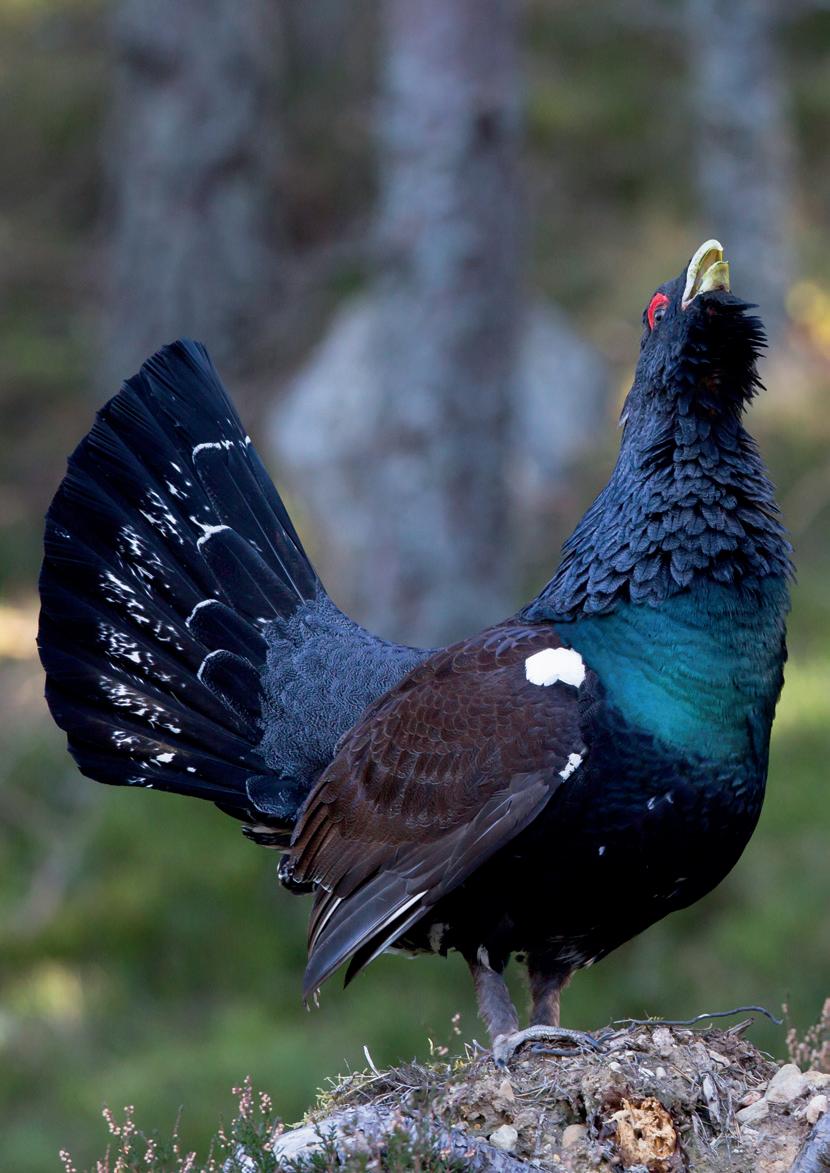
Powerwasher Services Ltd
‘Celebrating 40 Years’
Topic
Vogelsang advice to farmers
£3.75 August
Articles
Young People Connecting with Nature Health Check on British Hedgerows
Making Soil Better, Makes Business Better
Pedigrees for Peace
Innovators Wanted to Help Boost Rural Economy
Adding Value to Rural Estates
Travel Scotland
Country Estate in Inverurie
Farmhouse Kitchen
Slow Cooked Beef by Wendy Barrie plus
The Northern Isles • Ffermio Cymru




Beatha an Eilean • Scottish Country Life

Women in Agriculture • Flavour of Scotland
World Farming
including our regular news areas and columns

2023
Tuathanachas Alba

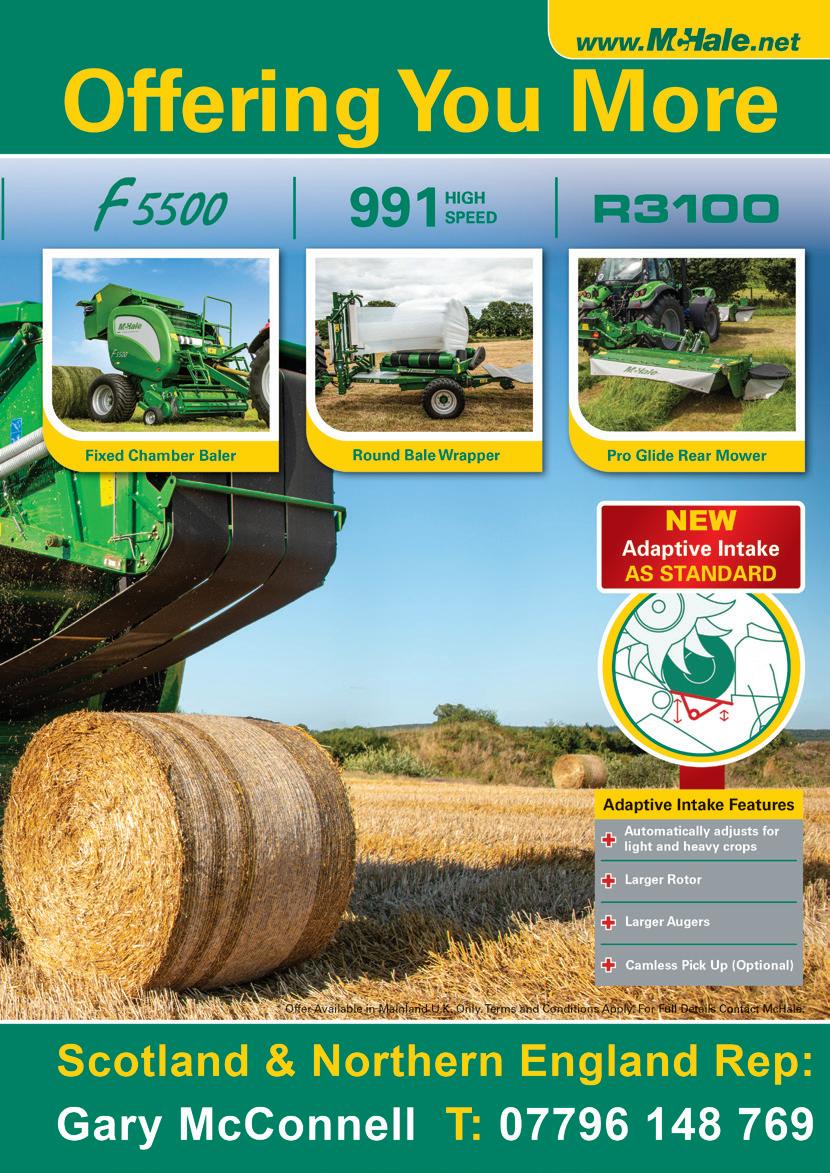
Next






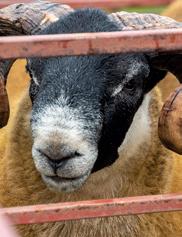

contents August 2023 All Editorial & PR enquiries EDITOR Athole Murray Fleming Tel. 01738 639747 E-mail: mail@farmingscotlandmagazine.com 9 COPYRIGHT This publication has been produced and published by ATHOLE DESIGN & PUBLISHING LTD who are the copyright owners. No reproduction, copying, image scanning, storing or recording of any part of this publication without the permission of ATHOLE DESIGN & PUBLISHING LTD. Contents disclaimer: FARMING SCOTLAND MAGAZINE is not responsible for any factual inaccuracies within press information supplied to us. Any concerns regarding such matters should be directed to the supplier of the materials. FARMING SCOTLAND MAGAZINE is designed, produced and published by Athole Design & Publishing Ltd., Tolastadh, 18 Corsie Drive, Kinnoull, Perth, Scotland PH2 7BU. Tel. 01738 639747 ISSN: 2041–918X ©ATHOLE DESIGN 2023 est 1994 COVER IMAGE: Capercaillie Features 20 Potatoes in Practice 22 Perth Show 24 Pest Control 30 Fruit for the Future 34 Tillage 48 Trailers 70 Telehandlers 81 Border Union Show Profile 40 Powerwasher Services Ltd ‘Celebrating 40 Years’ Articles 13 Young People Connect with Nature 18 Health Check on British Hedgerows 37 Making Soils Better Makes Business Better 54 Pedigrees for Peace Flavour of Scotland 14 Arbikie Gin Advertorial 19 Wroot Water Topic 38 Vogelsang advice to farmers Northern Isles 52 Stories from Orkney and Shetland Ffermio Cymru 90 Welsh Farming News Beatha an Eilean 92 Life on the Islands Scottish Country Life 94 With Jake Swindells Women in Agriculture 96 Overcoming Adversity Book Serialisation 98 Part 4: “Regeneration”, The rescue of a wild land Travel Scotland 100 A country estate in Inverurie Farmhouse Kitchen 102 Slow Cooked Beef News Areas 6 Arable & Root Crops 16 Food & Drink 17 World Farming 26 Environment 32 Science & Technology 55 Beef 56 Livestock 63 Dairy 65 Sheep 69 Pigs 78 Aquaculture 79 People 84 Estate 88 Forestry 104 Machinery 116 Finance 118 Events 121 People on the Move 121 Book Review Columns 3 Editor’s Bit 12 R.S.A.B.I 21 James Hutton Institute 29 Farming for the Climate 31 Crofting 39 Scotland the Brand 55 Quality Meat Scotland 61 Farm Advisory Service 62 The Vet 64 NFU Scotland 68 NSA Scotland 85 Scottish Land & Estates 87 Conservation Matters 89 Scottish Forestry 91 Aberystwyth University 95 Scottish Government 97 Southern Belle Subscriptions 122 Order your copy here.
Issue Out in September. Featuring: Ploughs, Combines, Grain Dryers, Seeding, Scottish Ploughing Championships, Muck Spreaders, Aerobic Digestion and so much more. See our website for details. www.farmingscotlandmagazine. com Advertising & Editorial Enquiries Call 01738 639747 or email mail@farmingscotlandmagazine.com 22 78 81 94 facebook.com/FarmingScotlandMagazine All Advertising & Editorial enquiries ADVERTISING DIRECTOR Athole Murray Fleming Tel. 01738 639747 E-mail: mail@farmingscotlandmagazine.com ADVERTISING MANAGER Barry Tweed Tel. 01475 910153 Email: barry@farmingscotlandmagazine.com PRODUCTION DIRECTOR Christina Fleming Email: christina@atholedesign.com

editor's bit

The ‘water of life’
While this edition was at the printers, Christina and I where on the Hebridean island of Islay sampling the local delicacies like whisky, whisky and a little more whisky!
And yes, the food was fab too!
As a ‘friend of Laphoaig’, we visited our leaseholding of a square foot of Islay to erect a flag to signify our presence on the island – us landowners eh?
We looked over our neighbours land, should we expand? – should we erect a tiny fence? – you know the kind of thing, land ownership can go to your head! (LOL).
This pilgrimage to the land of my favourite whiskies was truly a pleasure – from what I can remember!
And quite expensive too. Well, one must return with stocks renewed you know.
On a more serious point, Scotch Whisky at its best is a fantastic global success story, and one that relates very closely with farming too, providing feed to livestock etc.
Not being a farmer, I do enjoy being part of the ‘chain’ though.
Back in the office now and working on our next issue and trip, we never stop!
NC500 and the Smoo Cave here we come!
NB
I hope you are all enjoying the summer and of course, your local agricultural shows too.
& root crops
Growers are Optimistic about British Blackcurrant Harvest
Blackcurrant growers across the UK are optimistic about the potential of this year’s crop, despite enduring weather challenges and escalating production costs.
The blackcurrant growing season depends heavily on favourable weather conditions. Blackcurrants require sufficient winter chill, a frost-free flowering period, and dry, warm weather during blossom for an ideal fruit set. Unfortunately, this season has been marked by an average winter chill, a dry February, and a cold, wet spring. This combination of conditions made it challenging for farmers to tend to their crops. However, the recent sunny period, perfect for the second half of flowering, brings renewed hope.
Growers across the UK aim to produce around 11,000 tonnes of blackcurrants this season, maintaining an average yield of 3 tonnes per acre. This target marks a recovery from the impact of last year’s extremely hot weather, which caused some crops to fail.
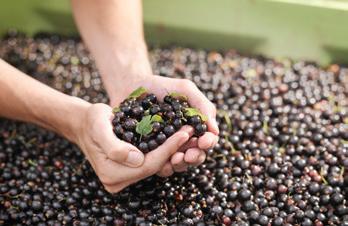
Jo Hilditch, a spokesperson for The Blackcurrant Foundation, which represents UK growers, comments, “The increasing cost of farming
inputs, including labour and materials, has led growers to be cautious about planting new blackcurrant plantations this year. Instead, many growers have opted to extend the lifespan of their existing crops, striving to achieve the highest quality yield possible.”
The UK blackcurrant sector is comprised of 35 specialist growers who maintain approximately 4,500 acres of planted crops. Along with the Wildlife Trust, these growers are committed to sustainable farming practices, including conservation efforts such as the 6 Point Plan implemented in partnership with Ribena. The plan outlines responsible management of hedgerows,
field margins, soil, water, and habitats for farmland birds, among other things.
Around 90% of the UK’s blackcurrant crop is used in the production of Ribena, a perennial favourite British drink. The remaining 10% find their way into other markets, including Individually Quick Frozen (IQF) fruit for supermarkets, puree production, jam making, fresh juice production, and more.
The start of the season will be celebrated on Blackcurrant Day on the 15th July 2023, which aims to share the many benefits of the great British blackcurrant.
Look out for more information at www. blackcurrantfoundation.co.uk
Agricultural sector merger creates growing opportunity
Two of Scotland’s longest established fresh produce organisations, East of Scotland Growers Ltd (ESG) and R&K Drysdales Ltd (RKD), have completed a merger and created an additional growing business, Pease Bay Farms, in a deal managed by leading Scottish law firm Thorntons.
Slàinte, Athole
ESG is a farmer owned cooperative with their main
offices based in Cupar, Fife. The collective of 15 growers produces vegetable crops including broccoli, cauliflower, cabbages, carrots, onions, and asparagus. The members’ farms are based in Fife, Angus, Perthshire, Kincardinshire and the Scottish Borders –producing more than 6,000 acres of Scottish brassicas on Scotland’s fertile east coast.
RKD is the UK’s leading Brussels sprout grower and packer, with one of the most sophisticated and high output grading, packing and storage facilities in Europe. In addition to Brussels sprouts, RKD also grow and pack swede and leeks at their state-of-the-art facilities in Berwickshire.
Both organisations, which are key UK producers for
www.farmingscotlandmagazine.com arable
6
arable & root crops
their respective cropping, have independently grown their businesses over recent years by forming and strengthening key relationships, and consistently providing their customers with excellent service and the highest quality fresh produce in the country.

Aligning the two organisations, couples Scotland’s leading vegetable growers to the premier brassica packer in the country. It also complements the winter cropping of RKD to the summer cropping portfolio of ESG, creating a sustainable, year-round producer. Amalgamating the growing regions will further create opportunities for farmers in Berwickshire, Scottish Borders, Lothians, Fife, Angus, Kincardineshire and Perthshire through the not for profit farmers’ cooperative.
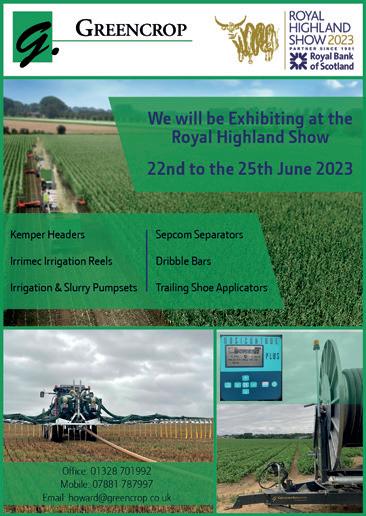

Andrew Faichney, Managing Director of East of Scotland Growers, said: “This merger is very unique within Scotland and combines two firms with
a longstanding history of high-quality produce. With a collective turnover approaching £50m this merger provides
stability and security for our membership and will provide an additional range of products and value to our customer base.
“This is a very exciting development not just for the ESG and RKD stakeholders, but the entire fresh produce
www.farmingscotlandmagazine.com 7
farming industry here in Scotland.”

ESG and RKD have established Pease Bay Farms to grow brassica crops across more than 1000 acres of prime agricultural land, growing
exclusively for the merger and joining ESG as a full member of the producer organisation.
The merger deal was managed by Alistair Lang, Lead Partner in the Ventures and Innovation Team at Thorntons.
He said: “Agriculture is a vital contributing sector to the Scottish economy and effective and strategic partnerships are key component to its ongoing success. With both ESG and RKD achieving great things, facilitating the merger and creation
of Pease Bay Farms can only be positive for the industry.”
Headquartered in Dundee, Thorntons has 13 offices ranging from Glasgow, Edinburgh and Montrose to St Andrews, Arbroath and Perth.
The Fight Against Blight Continues at Hutton
The James Hutton Institute has secured funding from a consortium of partners to continue its “Fight Against Blight” (FAB) project.
The FAB project helps protect valuable potato crops by alerting growers across the UK to late blight outbreaks via a website populated by “FAB Scouts” ; a network of agronomists, growers and industry representatives who submit field samples from suspected late blight outbreaks around the country.
Blight has already been reported in parts of England due to the cool damp weather experienced in May, but with conditions looking set for a drier spell, the risks are expected to decline over the coming week.
The 2023 program will include both the annual sampling of late blight outbreaks, and the characterisation of pathogen populations. In work led by Dr Alison Lees, fungicide sensitivity testing will be carried out once again for active ingredients prioritised by the industry.
Pathogen DNA captured on FTA cards will allow rapid inseason feedback on genotypes to scouts throughout the season
which, in combination with an end of season report, will ensure the potato industry is kept informed on the best-practice for late blight management.

Project leader Dr David Cooke of the James Hutton Institute said:
“The continuation of FAB is great news for growers and the sector more widely, and also for the longer-term research effort that supports this area.
“With concerns about resistance to CAA fungicides
related to the new genotype EU_43_A1 on the continent last year, the early detection of any new arrivals to GB crops is going to be crucial to building effective IPM programs for 2023 potato crops.”
www.farmingscotlandmagazine.com 8 arable & root crops


www.farmingscotlandmagazine.com 9 arable & root crops Increased throughput and top-notch quality with carrot optical sorting advancements Updates to the high-performance Visar Sortop Carrot optical sorter are bringing increased throughput, accuracy and quality to carrot sorting operations worldwide. As UK distributor of the Swiss-manufactured optical carrot and potato sorting machine, leading UK vegetable handling equipment manufacturer Tong Engineering is pleased to highlight the Visar
arable & root crops
Sortop update to growers and producers throughout the UK.

“Creating efficiencies across the vegetable handling process, particularly in replacing traditional sorting methods with the latest optical sorting facilities continues to be a real focus for vegetable producers,” explains Simon Lee, Sales Director at Tong Engineering. “As an experienced optical sorting integration partner, we are dedicated to supplying our customers with the most suitable and advanced optical sorting solutions for their specific requirements, and the latest developments to the Visar Sortop will certainly ensure the machine is an increasingly viable option for significantly
FARMING SCOTLAND
Subscription page 122
reducing labour requirements whilst improving crop yield and reducing waste.”
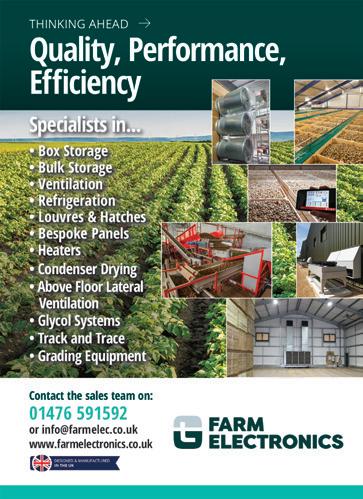
The Visar Sortop carrot and potato optical sorter uses intelligent optical sorting technology based upon a 360-degree mirror system and HD camera for great accuracy at speed. It is designed to accept any form of carrot and potato, even one that is highly twisted, and can detect defects to the nearest millimetre or gram.
One of the key updates to the Visar Sortop carrot sorter, is a new software featuring infrared vision, which increases the accuracy of defect detection such as rotten, damaged or mousegnawed crowns. In particular, the new infrared vision has improved the machine’s vision of carrot crowns and tips where defects can commonly occur. In addition, the new software has a simplified user interface that controls the machine’s automatic
and progressive learning of which defects are acceptable or not. The precise adjustment of quality parameters is now even easier for the operator and instant statistics on production and batch quality are now also easily available. With the new machine, 16 customisable outlets are available for maximum flexibility.
Alongside the updates to the machine’s software, the Visar Sortop has a new infeed system which brings a highly increased hourly sorting capacity. Built upon a unique design, the new feeding system features a simple and ingenious rotating system which cleverly and smoothly aligns carrots of all sizes into a singular orientation, for perfect infeed to the optical sorter without any duplicates. This new infeed systems means that an impressive 1.8m of linedup carrots can be viewed per second.
“The updates to the Visar not only mean the machine is more user-friendly than ever before, but the detection capabilities of the machine have advanced even further whilst throughput has increased significantly with the introduction of the new infeed system,” says Simon. “One of our UK customers who has been operating a series of Visar Sortop carrot sorters for several years has recently upgraded the infeed system to the new design and has seen a noticeable increase in throughput. We are excited to discuss the new advancements with carrot growers throughout the UK so they can see how an advanced optical sorting machine can dramatically reduce the labour costs whilst increasing the consistency and quality of their sorting operations.”
For more information on the Visar Sortop and optical sorting of all types of vegetables, don’t hesitate to get in touch with the Sales Team at Tong Engineering.
www.farmingscotlandmagazine.com 10
MAGAZINE
Protecting the water supply for your potato crops

Extreme weather events, increased demand for water use, plus environmental legislation continues to put pressure on water availability and the need to demonstrate justification for crop irrigation.
Now is a good time for growers to review their irrigation strategy to ensure that their crops receive the irrigation they need whilst using available water in a sustainable way.
Fiona Law-Eadie, senior agronomist at Crop4Sight, explains last summer’s drought followed by a dry autumn and winter means some reservoirs are still not at full capacity, despite the wettest March in 40 years.
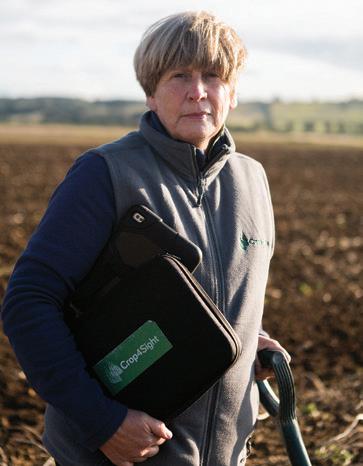
“There are several ways growers can manage irrigation, but there’s a fine line between
giving crops sufficient water and damaging crops by overirrigating,” says Fiona.
“Efficient irrigation maintains the correct soil moisture for crop demand throughout the growing season and is a key factor in producing high-yielding, quality potato crops.
“Excessive irrigation that keeps soil near field capacity for substantial periods can aggravate disease, quality issues, impede root growth, reduce nitrogen uptake and damage soil.
“These factors all contribute to unprofitable crops, costing growers money.”
Fiona explains, when it comes to managing irrigation there are two main approaches.
“Firstly, direct soil methods, which use various techniques for
arable & root crops www.farmingscotlandmagazine.com
measuring soil water content or tension.
“Accuracy of such results are sensitive to good calibration of equipment and being installed at locations in the field representative of both soil type and the irrigation applied - the cost associated can make this a very expensive option.
“Whilst measuring available soil moisture, these systems don’t consider crop water demand or irrigation capacity, often resulting in overwatering.”
Fiona explains: “Secondly, water balance methods, using crop growth stage, environmental and soil data to model crop water demand, either via a manually calculated balance sheet or computerized irrigation scheduling tool.
“The Crop4Sight Irrigation Scheduling Module, available on mobile or web, allows growers to generate real-time irrigation scheduling.
“One of the great benefits of this system is that schedules can be produced as often as a grower needs, especially if weather conditions change dramatically.
“Other systems run on a weekly basis and crop requirements can change significantly during that time.
“This flexibility delivers more efficient water management as growers are able to match irrigation to crop demand.
“Creating a whole farm irrigation strategy taking into account both water requirements of individual crops, as well as irrigation capacity and demands from irrigation equipment elsewhere on- farm.”
Fiona explains, to use the module, growers need to enter information about their fields and irrigation plan which takes a matter of minutes to do.
“In season, growers then need to input the amount of irrigation applied, rainfall data and canopy measurements which will then automatically generate accurate schedules as often as required which is unique to Crop4Sight.
Strong interest in RSABI’s Great Glen Challenge
RSABI is delighted to announce the return of its flagship annual outdoors team event, the Great Glen Challenge, taking place on Friday 25 August 2023.
Sponsored by expert legal advisors to the rural sector, Gillespie Macandrew, The Great Glen Challenge 2023 has now had over 20 teams sign-up, with just a few team places remaining. Competing teams of four plus a support driver will be required to take on the multi-sports race, with four designated stages set out between Fort Augustus and Fort William.
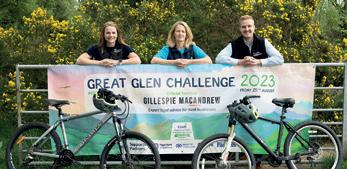
Consisting of a 49km mountain bike, 6km kayak, 18km walk, and 17km run, the event is designed to challenge teams, encouraging dedication and teamwork from the onset of training up until the day of the event.
Carol McLaren, RSABI Chief Executive, said: “Now in its 11th year, the Great Glen Challenge is very popular and our thanks go to all those who have taken part in the past, the volunteers who help us run the event, and everyone who has already signed up this year.
“The 2023 challenge wouldn’t be possible without the generous sponsorship of Gillespie Macandrew who we are looking forward to collaborating with to produce yet another successful event.
Longstanding supporters of RSABI, Gillespie Macandrew also have two teams already signed up to take part and we are grateful for their commitment.”
To enter your team (subject to places still being available) please submit the Sign-Up form available on the RSABI event page: www. rsabi.org.uk/event/rsabigreat-glen-challenge-2023/ RSABI provides financial, practical and emotional support to people in
Scottish agriculture. Its free confidential support service is available 24 hours a day, every day of the year, by calling 0808 1234 555 and calls won’t show up on phone bills, or through a confidential webchat service, available on the RSABI website www. rsabi.org.uk.


For more information or to sign up to RSABI’s supporters’ scheme, please visit the RSABI website www.rsabi.org.uk.
RSABI’s Freephone Helpline – 0808 1234 555 – is open 24 hours a day, every day of the year and a 24-hour confidential webchat service is available at www.rsabi.org.uk.
12
L to R: Lois Newton, Partner of Land and Rural Business at Gillespie Macandrew, Carol McLaren, RSABI Chief Executive, and Sam Conington, Solicitor, Land and Rural Business at Gillespie Macandrew.
Young people connect with nature across Scotland
The Estates that Educate initiative has returned for 2023 offering young people a handson experience of the variety of activities undertaken by Scottish estates to maintain the unique biodiversity of the uplands.
From the Southern Uplands to the Angus Glens, Grampian, Tayside and the banks of Loch Ness, nearly 2,000 young people will have taken part in a training session by the end of the year, gaining a valuable insight into rural careers and helping them connect with nature.
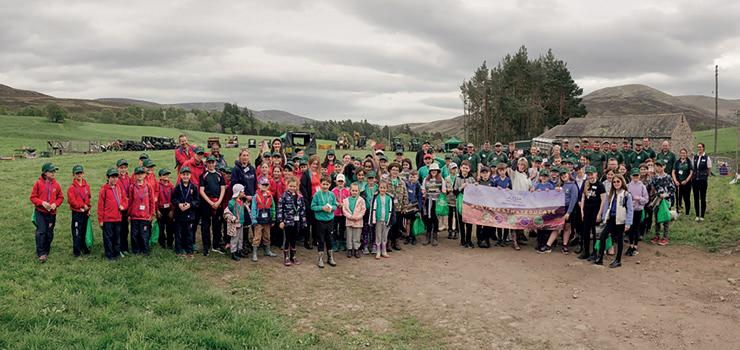
Lianne MacLennan, National Campaigns Manager of Scotland’s Regional Moorland Groups said: “Many of these children and young people live close by but have never come up on to the moors. They don’t have that connection with nature that gamekeepers and shepherds do, who are lucky enough to be surrounded by this natural beauty all year round. Even just listening to all the different birdsongs or seeing a mountain hare for the first time is a
valuable experience and helps them appreciate the species that make the moors their home.”
Activities on offer include: how to identify and record wildlife sightings, sheep shearing, feeding lambs, fishing, foraging, cooking and tasting game or venison, working with gundogs and with hill ponies, forestry and tree planting, deer management, repairing vehicles such as Argocats and 4x4s, building bird boxes, the Countryside Code, safety on the moors and wildfire prevention.
John and Catriona Frankitti of Innes Ross will provide a foraging session, teaching the young people how to make nettle pesto and homemade ketchup from foraged berries. They will also provide samples of various types of venison and game paté, for the children to try.
Over 100 members of estate staff will provide a combined 3,800 hours of skills-based education.
One session will outline the range of upland habitats and plant life, including sphagnum mosses,
blaeberry and cottongrass, which are home to a range of important insects and pollinators.
Lianne MacLennan continued: “This year the focus will be on reversing biodiversity loss by protecting the rare species we have here, such as Golden Eagle, Curlew and Lapwing which don’t thrive in many other places. Young people are particularly interested in peatland restoration and the work estates do to keep the peat in good condition to help store carbon, combatting climate change.”
The Scottish Fire & Rescue Service will talk about safety on the moors including the dangers posed by disposable BBQs, and the importance of wildfire mitigation.
Tasks are tailored to the different age groups and primary and secondary schools are actively involved in devising the programme of activities in line with aspects of the national curriculum.
The Countryside Code is another important element of the
programme – teaching children about why farmers ask for dogs to be kept on leads in the spring and summer, to protect vulnerable ground-nesting birds and sheep with lambs.
Lianne MacLennan concluded: “There has never been a more important time to engage with young people and let them know how they can get involved in land management and conservation to protect the species and the countryside that we all love. Moorland management for red grouse helps protect other rare species and ensures Scotland’s beautiful moorlands are safeguarded as a globally important and rare ecosystem.”
The Estates that Educate initiative is run by Scotland’s Regional Moorland Groups and supported by BASC Scotland, British Game Assurance, Countryside Learning Scotland, House of Bruar, Lyme Disease UK, No. 9 Chef Services, Scottish Gamekeepers’ Association, Scottish Land & Estates, Strathtay Sticks, and Taste of Game.
www.farmingscotlandmagazine.com ARTICLE
13
Estates that Educate - group picture
Credit Kirk Norbury
Arbikie’s climate-positive gin revolutionises global drinks supply chain
Arbikie Highland Estate in Angus is leading the way in the decarbonisation of the global drinks sector, with their gamechanging pea-based gin Nàdar, setting the tone for a sustainable supply chain for other distillers to follow.

This is the seventh in a series of case studies, developed as part of the 2023 RHASS Presidential Initiative (PI), exploring the science behind food and drink production.
Owners of Arbikie, the Stirlings, have been farming for over 400 years, and since the three brothers who currently run it, Iain, David and John, added the distillery to their operation nearly a decade ago, they have made it their ambition to develop a ‘field to bottle’ model of growing, harvesting and distilling everything on-site.
Working closely with scientists at Abertay University and the James Hutton Institute, they have explored the distilling potential of less conventional crops such as peas and potatoes, which has driven the expansion of the global sustainable spirits’ market.
Their award-winning spirit Nàdar is the world’s first climatepositive gin. It was created by Master Distiller and scientist Dr Kirsty Black and in close collaboration with Agroecologist Dr Pietro Iannetta, from the James Hutton Institute.
Together they explored the distilling potential of leguminous crops, in particular looking at peas, which offer many benefits including their ability to fix their own nitrogen, thus reducing reliance on synthetic fertiliser
and reducing environmental impact.
“Nàdar is fully provenanced as a sustainable Scottish product, and when purchased, consumers can be assured, they are also encouraging morepractical crop rotations, helping to reduce artificial fertiliser use, improving soil qualities, and most importantly, directly reconnecting the values of local consumers and farmers, to help realise the most respectful and sustainable of agricultural operations at home,” said Dr Pietro Iannetta.
Iain Stirling highlighted that pressures are mounting on the drinks industry to improve its sustainability record and he hopes the work demonstrated by Arbikie could be replicated and help decarbonise the drinks sector across the world.
“Customers are increasingly demanding more from their produce in terms of sustainability, and we need to be willing to listen to the market and respond,” he explained. “We have an amazing farming industry which is very adaptable and innovative and could supply more in that space if distillers were to ask for it.
“When we launched Nàdar at Abertay University, that was us saluting the scientists, who without, our dream wouldn’t have materialised. Science will be key to helping us to move in this direction more quickly. That is why we have ongoing collaboration with universities and the James Hutton Institute, and are a willing partner in this space.
“We are lucky to work with some of the world’s best
bars, retailers, and restaurants, including Atlas Bar in Singapore, retailers like Wholefoods in the US and hotels like the Hilton. It is challenging to supply them as a relatively new business but that is where innovation and creating things that don’t exist elsewhere, really helps. By working with us, we are offering solutions to their want for greater sustainability and playing our part in decarbonising the drinks supply chain.”
George Taylor of the RHASS Presidential Initiative added:
“Arbikie Highland Estate is an inspirational story of the Stirling

brothers’ vision and hard work, resulting in the production of a great range of sustainable and locally distilled Scottish spirits that are now being sold worldwide.
“Another excellent example of “The Science behind Food and Drink,” where three local organisations in Arbikie, JHI and Abertay University have collaborated and used individual and collective expertise to deliver ground-breaking and world leading results. Alex Stirling would be extremely proud of what his sons Iain, David and John have achieved.”
www.farmingscotlandmagazine.com 14 FLAVOUR OF SCOTLAND
Better Burger Challenge Finalists Announced supply chain
The Better Burger Challenge, a contest aimed at encouraging pupils to explore product reformulation and create healthier versions of the classic burger, has announced its finalists.Developed in partnership with Food and Drink Federation Scotland (FDF Scotland) and Quality Meat Scotland (QMS), the Better Burger Challenge was launched to encourage teachers to use the online “Make it with Meat” resource for pupil¬¬¬¬s to create healthier, unique versions of the beloved burger without losing its classic taste.
“Make it with Meat” is a complete project with lesson plans, worksheets and more. It helps pupils learn about the burger making process from farm to fork, and includes lessons on farming, nutrition, reformulation, product development, costing, labelling and careers.
After an original round of judging the shortlisted recipes, created by pupils, were cooked by City of Glasgow College Hospitality Chef Lecturer Gordon Findlater, who also provided recommendations on how they could be further improved from a chef’s perspective.

Out of the entries from different schools across Scotland, four finalists have been chosen after being taste tested by Chef Findlater, along with judges Jennifer Robertson of Quality Meat Scotland (QMS) and Moira Stalker of FDF Scotland. After much deliberation, the finalists are:
• The Big Drooling Dreamer from an S3 team at Kirkintilloch High School
• The Deli Burger from an S2 team at Merkland School
• The Aberdeen Angus from an S3 team at Stewarton Academy
• The Sweet Chilli Smoken’ hot burger from an S2 team at Rothesay Academy
Winners will be announced in due course.
Jennifer Robertson, Health and Education Manager at Quality Meat Scotland, said: “We are delighted to announce the finalists of our first-ever Better Burger Challenge. We were blown away by the quality of the entries. It was great to see so many pupils across Scotland getting involved and thinking creatively about how they could make a classic favourite healthier. Congratulations to all our finalists.”
Moira Stalker, Skills Manager at Food and Drink Federation Scotland, said: “The Better Burger Challenge is a fantastic initiative. We are delighted to have partnered with Quality Meat Scotland to help encourage pupils to think about the many skills and processes required to create healthier versions of a staple family favourite.”
Susan Millar, teacher at Kirkintilloch High School, said: “S3 Hospitality pupils at Kirkintilloch High School thoroughly enjoyed collaborating with their peers whilst taking part in the Better Burger Challenge. It allowed them to show off their creative and critical thinking skills when working together to understand the process of food reformulation and product development.
“It was very difficult to choose class winners as all burgers were made to a very high standard. We delivered lessons alongside the ‘Make it With Meat’ resources which were excellent. Overall, the competition was well received by pupils, and they thoroughly enjoyed the creative process.”
Kirsten Murray, teacher at Merkland School, said: “We are absolutely delighted to be in the final four. I am so proud of what our pupils achieved, and they just thrived throughout this whole
experience. The resources were fantastic, and it really helped our pupils with reinforcement of what the Challenge was about and exploring the food chain in great depth.”
Kathryn Taylor, principal teacher at Stewarton Academy, said: “I found the resources really useful, and they can easily be adapted to suit the pupils you have in your class. I aimed the Challenge at the S3 pupils as a number of them are taking the subject on in the national qualification. There are great links and areas of progression to the National 5 practical cookery course.
“The students particularly enjoyed the reformulation process. We did sensory testing on a variety of burgers, herbs and spices to help them create their own burger.”
Tara Timms, teacher at Rothesay Academy, said: “As a teacher, I feel proud that one

of our entries are finalists in the build a better burger competition. The team think it is ‘cool’ that their ambition and invention of the “Sweet Chilli ‘Smokin’ Hot Burger” has been recognised. They love the fact that the scheme of work allowed them to work in a team, come up with ideas and design their own burger, from initial concept to finished product.
The whole class loved the competitive aspect the series of lessons brought from quizzes supplied at end of each lesson through to the in-class cook off! From my point of view, the resources supplied were of a very high quality offering a huge amount of variety. This allowed me to ensure I met all learners, needs and covered many learning outcomes.”
For more information on the Better Burger Challenge, visit: https://farmingfoodsteps.co.uk/ lesson-3/make-it-with-meat
FLAVOUR OF SCOTLAND www.farmingscotlandmagazine.com 15
NFU response to the Free Trade Agreements with Australia and New Zealand
President Martin Kennedy said:
“With the UK-Australia and UK-New Zealand Free Trade Agreements (FTAs) going live from midnight on 31 May, the Government’s track record on these particular FTAs is one of failure. Both of these FTAs were negotiated in 2021 without the interests of primary producers in mind but with politicallydriven haste in the wake of the UK’s departure from the EU. The UK Government failed to protect Scottish farming interests, failed to properly engage with stakeholders and failed to provide Parliament with proper scrutiny on such deals once agreed.
“They saw our agricultural interests and access to our food and drink sector used as cheap bargaining chips to secure what is seen as more lucrative market access for other sectors. There was little or nothing in these damaging trade deals for Scottish food or farming, a fact that former Defra Secretary of State George Eustice recently recognised.
“NFU Scotland has consistently highlighted the clear lack of meaningful safeguards to

New fund to help Scottish bakers make their food healthier
protect domestic food security, in addition to the cumulative impacts for particular sectors such as beef, lamb and dairy posed by two giants of global agri-food trade.
“Fast forward to the ‘Farm to Fork’ summit hosted at Downing Street on 16 May and the rhetoric of ‘putting agriculture up front’ and ‘protecting sensitive sectors’ in the context of any new FTAs. For NFU Scotland, these commitments are certainly welcome, but in the case of Australia and New Zealand, they ring hollow and the horse has now bolted. The approach now being promised and pursued by the UK Government around trade deals should and could have been in place from day one, had the UK Government listened to industry.”
Food and Drink Federation (FDF) Scotland - in partnership with Food Standards Scotland (FSS) - has launched a new fund to help Scottish bakery businesses to make their products healthier.

The Healthier Bakery Fund is open to all businesses based in Scotland that produce sweet or savoury bakery goods such as cakes, pies, pastries and bread. This includes bakery and ingredient manufacturers, local butchers and bakers, cafes and restaurants and retailers.
This fund will support projects that reduce the fat, sugar, calories or salt content
in much-loved products or that increase fibre, wholegrain, or fruit and vegetable content in recipes. These changes can often be achieved by simple actions such as swapping shortening for a lower-fat alternative or incorporating wholemeal flour into a recipe.
Food and drink producers have a real desire to offer a wider range of healthier products – but the associated costs can be challenging. That’s why this fund has been launched. Successful businesses can use up to £5,000 of funding to pay for activities such as trialling recipe changes or nutritional testing.
Introducing the Whisky Coaster & Glass gift set by J Boult Designs

J Boult Designs, a renowned name in world of artisanal craftsmanship, is thrilled to unveil its latest creation, the handmade Whisky Coaster & Glass Gift set. Meticulously handmade with passion and countryside grit, this exceptional upcycled stave coaster is poised to revolutionise the way whisky enthusiasts savor their favourite single malt after a chilly day on the peg or deerstalking up the windswept hill.
Each coaster is expertly handmade from authentic whisky staves, locally sourced from the finest oak barrels that once held the golden nectar of aged spirits. Every coaster showcases the intricate beauty of the wood’s natural grain. With its unique character and emphasis on sustainability, no two coasters are alike, making each coaster a truly one-of-akind treasure.
Nestled within this artisanal piece is the iconic Glencairn Glass, revered by whisky connoisseurs worldwide. Meticulously shaped to enhance the aroma and flavour profile of your favourite spirits.
The Whisky Coaster & Glass Gift Set by J Boult Designs is now available for purchase through their website: www. jboultdesigns.com for £30 including postage.
food & drink www.farmingscotlandmagazine.com 16
UN Rural development agency partners with Amundi to issue IFAD’s largest sustainable bond to date
The International Fund for Agricultural Development (IFAD) has issued its largest private placement (€115 million) to Amundi Asset Management, to increase financing for inclusive and sustainable rural transformation. IFAD is an international financial institution and specialized United Nations agency based in Rome, the UN’s food and agriculture hub. Amundi is Europe’s largest asset manager and a strong advocate for responsible investments.

With the 15-year issuance, IFAD completes its 2023 funding plan. The proceeds, together with contributions from IFAD’s Member States, will support IFAD’s investment program of up to US$3.5 billion planned for the triennium 2022-2024 in rural areas of more than 90 developing countries.
Providing small-scale farmers access to markets to sell local produce, developing agricultural value chains, sharing and implementing agricultural techniques that are climate-resilient, rehabilitating land and protecting coastal areas from extreme weather events, promoting diets that are nutritious and sustainable, and enabling women to access financial resources and decisionmaking power are only a few of the areas that this issuance will support.
“We are delighted to have been able to complete the 2023 funding plan so early in the year,
and we are proud to partner with Amundi, a frontrunner of Environmental, Social and Governance integration in the investment process, and a firm believer that ESG criteria in investment decisions is a driver of long-term financial performance. This trade is yet another example of how two like-minded institutions can overcome challenging market conditions” said Natalia Toschi, Head of Funding at IFAD.
The investment comes as global leaders will be converging to the New Global Financial Pact Summit in Paris on 22-23 June to discuss ways to reform the global financial architecture and channel more funding to the world’s poorest countries enabling them to finance climate action and their development.
About 3 billion people live in the rural areas of developing countries and rely to a significant extent on small-scale farming for
their food and livelihoods. Smallscale farmers produce one third of the world’s food and up to 70 percent of the food in low- and middle- income countries. While being essential for global food security, they often live in poverty and hunger. About 80 per cent of the world’s extremely poor people reside in rural areas. The number of people suffering from hunger has been growing in recent years and reached approximately 828 million in 2021.

www.farmingscotlandmagazine.com 17
WORLD FARMING
Health-check Britain’s hedgerows this summer
Wildlife enthusiasts needed to join the Great British Hedgerow Survey and survey local hedgerows, which is vital for their ongoing conservation
Hedgerow survey season is here, and wildlife charity People’s Trust for Endangered Species (PTES) is looking for volunteers in all corners of the UK to take part in its Great British Hedgerow Survey.
Between now until October volunteers are encouraged to health-check their local hedgerows by filling in PTES’ simple survey form. Key features of their chosen hedge are recorded, such as the height, width, structure and what tree species are present.
The data gathered provides instant feedback about how healthy the hedgerow is and offers bespoke management advice*. When volunteers work in collaboration with farmers and/or landowners, this advice can be passed to those that directly manage the hedgerows, ensuring they are sensitively managed so they can thrive for many years to come.
The results also enable PTES’ conservationists to build a nationwide picture of Britain’s hedgerow health and how it’s changing over time. And, by understanding their current structure, condition and key features, PTES can start to implement targeted, data driven conservation (alongside the work the charity already does with landowners and the farming community), which is crucial to ensure this iconic and important habitat is preserved.
The Great British Hedgerow Survey is primarily aimed at wildlife enthusiasts, landowners, Wildlife Trusts and other groups,
but anyone with a passion for preserving native habitats and the countless species they support can take part.
PTES offers free survey training to groups and there is also advice available online. To find out more and to take part, visit: hedgerowsurvey.ptes.org
Megan Gimber, Key Habitats Officer, PTES says: “The value of healthy hedgerows cannot be overstated; they provide a lifeline for so much wildlife (from hedgehogs and dormice to birds and butterflies), as well as many rare and threatened species. They are a home, provide food, act as safe corridors for wildlife travel across the countryside and the way they are managed has a huge impact on their ecological value.”
“About half of the UK’s hedgerows were lost in the last century through incentivised removal, and although the rate of this decline has slowed significantly, it’s important that what we’ve got left is in good condition. After all, the hedgerows that remain today are “the single most important ecological building block left in this country” to quote George Eustice, Secretary of State for Environment, Food and Rural Affairs.”
Megan continues: “Since the Great British Hedgerow Survey began in 2019, hundreds of volunteers have taken part and together they’ve surveyed over 800km of hedgerow. This is a great start and gives us a real insight into how these hedgerows

are faring, but there’s plenty left to do. With over 500,000km of hedgerows in the UK, the hedgerow infrastructure is largely there, we want to ensure that this translates to 500,000km of ecological dynamite. We really need a nationwide push to health-check as many hedgerows as possible.”
Hedgerows are icons of the countryside, and as well as supporting myriad species of wildlife (one study in Devon found over 2,000 species within an 85m stretch of hedge!), they are a huge asset to farmers and land managers too. They offer services such as crop protection (through beneficial insects that
predate crop pests), act as a wind shelter and host essential pollinator communities. For livestock they act as barriers whilst providing shade, shelter and browse. They can also provide income and benefit the environment by acting as carbon stores. They help to reduce flooding, soil erosion, air and water pollution levels too.
To take part in the Great British Hedgerow Survey or to find out more about PTES’ hedgerow conservation work, visit: hedgerowsurvey.ptes.org
*In line with the hedgerow management lifecycle, which is based on the 10-point scale expertly developed by Nigel Adams
www.farmingscotlandmagazine.com 18
ARTICLE
Measuring the height of a hedge as part of the Great British Hedgerow Survey. Credit Megan Gimber.
K-Line Dirty Water Filter
After many years of searching for a simple cost-effective solution to clean dirty water and make the K-Line system Work. We have worked with customers and come up with simple lowcost reliable system.
The K-line dirty water system consists of a submersible pump in the dirty water collection tank or lagoon.

The water is pumped over the dirty water filter using the submersible pump located in the dirty water collection tank / lagoon. The water goes through the filter into the collection tank underneath the filter, any solids slide of the filter and into the slurry lagoon, or into the particle collection tank.
The filtered water is collected in the tank below the filter, the cleaned water is then pumped by the secondary pressure pump, this pumps the water to the field then into the K-Line system.
The system has float switches to stop the pumps running dry when the water level
drops below a certain level the system can also be operated on a timer to avoid over watering and saturating the soil.
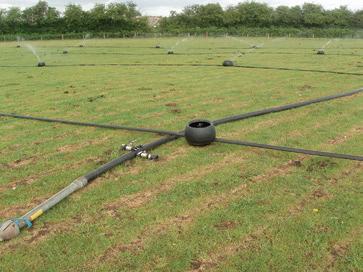
The pictures show the main components of the K-Line irrigation system in the field distributing the dirty water after the filter.
The isolation valves are fitted with quick couplers to save time when connecting and disconnecting before and after moving.
The pods can easily be moved using ATV or Quad bike.
The system is easy to set up.
One of the main advantages of this dirty water system over other systems is that all the components are simple and requires very little maintenance.
The system is designed as standard to operate @ 8 TO 9M3 per hour @ 3.5 bar, this is 6mm per hour per Ha.


This application rate avoids run off and soil saturation, as it matches the infiltration rate of most grass land.

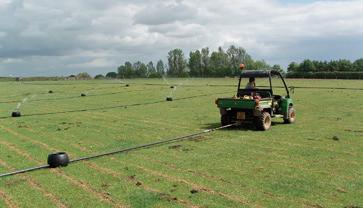
www.farmingscotlandmagazine.com 19 ADVERTORIAL
K- Line being easily moved with RTY
The quick coupling for the use of K-Line
Dirty water filter
Dirty water filter
Unveiling the Future of Potato Crop
Production at the UK’s Largest
Field-Based Event in Dundee – Potatoes in Practice


Potatoes are the world’s third most important food crop and hold a significant place in the agricultural landscape of the United Kingdom. Their cultivation plays a vital role in the country’s economy and potatoes are one of the most nutritional crops as
well as providing more food per unit of water than any other crop. On August 10th, 2023, from 9.00 am to 3.30 pm, the James Hutton Institute’s Balruddery Farm in Dundee in partnership with the Scottish Rural Collage and Agrii will host the UK’s largest field-
based potato event, Potatoes in Practice.
This eagerly anticipated gathering brings together a variety of demonstrations, cutting-edge research, trade exhibits, and a wealth of knowledge from experts in the field. With a focus on using
evidence to build resilience for potato crop production, this event promises to provide valuable insights and opportunities for farmers.
A Comprehensive Showcase
The event offers a comprehensive
www.farmingscotlandmagazine.com 20
Harvesting of tubers from potatoes from the Commonwealth Potato Collection curated by the James Hutton Institute
POTATOES IN PRACTICE
showcase of the latest developments in the potato industry. From commercial breeders introducing new varieties to agronomists demonstrating advancements in crop protection, attendees will have the opportunity to witness first-hand the latest innovations and emerging trends. Researchers will also be on hand to discuss their most recent findings, allowing farmers to tap into the wealth of scientific knowledge available. This year the SSCR will kindly sponsor a meeting tent which will be available to book for private meetings
Building Resilience
The theme of this year’s event, “Using Evidence to Build Resilience for Potato Crop Production”, highlights the importance of evidence-based practices in overcoming the challenges faced by potato farmers. Prominent speakers will share their expertise and insights on various topics, offering practical advice and strategies to enhance the resilience of potato crops.
Steven Thompson from SRUC will provide a large-scale economic analysis of the potato supply chain in his presentation entitled: “Building resilience through understanding the true value of potato supply chains”. Patrick Hughes from SAOS will present ‘A strategy for the seed potato sector in Scotland’. Additionally, Nick Winmill from Agrii will give a presentation entitled ‘The Potato partnership: Delivering integrated solutions for the industry’. Attendees can also look forward to hearing from Ian Toth, the newly appointed director of the National Potato Innovation Centre (NPIC) at the James Hutton Institute, updating them on the latest developments in this crucial initiative.
Exploring Innovation
The event will cover various aspects of potato farming and storage. For example, Derek Stewart will showcase new cold storage facilities and capabilities, highlighting the importance of postharvest management in preserving potato quality. The introduction of a purpose-built greenhouse
gas observatory tower will be a game-changer in understanding and mitigating the environmental impact of crop production, and information on this development will be presented. Attendees will also have the opportunity to explore new technologies in potato breeding, as well as advancements in disease detection during storage using a prototype volatile detector. Furthermore, the event will showcase current pathogen modelling techniques and integrated pest management (IPM) strategies, empowering farmers with the tools they need to enhance productivity and sustainability.
Spotlight on Disease Resistance
Plots at the event will highlight breeding efforts focused on developing potato varieties with improved resistance against viruses, blight, and PCN. As disease management remains a significant challenge in potato farming, these advances in breeding offer great promise for mitigating crop losses and reducing reliance on chemical interventions. Attendees will gain valuable insights into the latest disease-resistant varieties, allowing them to make informed decisions when selecting planting materials.
An event not to be missed
The UK’s largest field-based potato event at James Hutton Institute’s Balruddery Farm in Dundee promises to be an exceptional opportunity for industry professionals, researchers, and exhibitors to interact and discuss this critical sector. With its focus on using evidence to build resilience for potato crop production, attendees will be at the forefront of innovation and knowledge sharing. From exploring cuttingedge technologies to gaining insights into disease resistance and best agronomic practices, farmers will leave the event equipped with the tools they need to navigate the challenges of potato farming.
Contributed by: Ingo Hein, Eleanor Gilroy and Philip Burgess from the James Hutton Institute
Scottish arable and horticulture production
The future of Scottish agriculture is under pressure from pests and diseases, climate stress, rising input costs, labour availability, and global trade. Which actions are needed now to prepare for and prevent future threats? This is the tricky question being tackled by scientists at the James Hutton Institute, funded by the Scottish Government.
To this end, a recent study by Hutton scientists consulting with agricultural stakeholders has shed light on the crucial drivers of risk that could affect the sustainability of Scottish agriculture in the future.
The findings, based on an online survey distributed to agricultural stakeholders last autumn, revealed significant concerns regarding the potential threats to crop production.
Among the major challenges identified, the respondents expressed concern that a warmer climate, coupled with the decreasing availability of pesticides, could lead to a surge in pests and diseases, posing a significant threat to future crop yields.

In addition to pests and diseases, the study identified several other key drivers of change that could impact Scottish agriculture: global conflict, rising costs of agricultural inputs, labour availability, export regulations, and market globalisation. The report summarising these
findings is available at https:// zenodo.org/record/7810017.
The information from the survey will inform the next stage of the research, which will see stakeholders gather for workshops this summer. These workshops aim to develop future scenarios with stakeholders of threats (and opportunities) to agriculture and explore what might happen to arable and horticultural production in Scotland.
The approach will give insights about the importance of different social, economic and environmental drivers and stimulate creative thinking about actions that can be taken by industry and policy to safeguard the future of Scottish arable and horticultural production.
The workshops are planned for Weds 28th June and Tues 11th July. If you are involved in the arable or horticulture sectors and interested in participating, please contact Alison Karley (Ali.Karley@ hutton.ac.uk) or Luz Maria Lozada (Maria.Lozada@hutton. ac.uk) for further information.
The James Hutton Institute is a world-leading scientific research organisation working to resolve global challenges in food, climate, energy and water security. The Institute works in partnership with people, organisations and governments to enhance sustainable environmental, social and economic development to deliver practical solutions for our shared future. www.hutton.ac.uk

www.farmingscotlandmagazine.com
Hutton study highlights key factors impacting future of
The City of Perth is preparing to roll out the green carpet as country comes to town for the 161st annual Perth Show.
The agricultural, equestrian, food and fun extravaganza is set to take place at the city’s South Inch on Friday and Saturday, August 4 and 5.
And organisers are promising “one of the best Shows ever” as the two-day event lines up something for everyone.
Thousands are expected to visit the agricultural showcase which turns the spotlight on the area’s vital farming sector. And with one of the best line-ups of prime livestock on parade, Perth Show 2023 is sure to prove a lure for animal lovers and farming folk alike.

Attractions include one of the country’s finest line-ups of
It’s Showtime!
would-be champion horses, donkeys, goats, cattle and sheep. More than 500 horses and 770 head of livestock will compete in 358 classes while other Show supporters vie for prizes in cooking and handcraft.
Throughout the two days, trade stands, sideshows, entertainment, activities, pipe band and parades all add to the vibrancy of this annual crowd-pleaser which is now the third largest of its type in Scotland. This year Perth Show has secured a prestigious double as it prepares to host two national cattle shows – the Scottish Hereford National Show and the Limousin Cattle Annual Grand Prix.
And both look certain to attract one of the country’s largest gatherings of these popular breeds this year.
Perth Show Chairman Robert Gilchrist, himself Chief Executive of the prestigious Aberdeen-Angus Society, said that securing the two national breed showcases for Perth was a real “cattle coup” for this year’s event.
“Perth Show 2023 is well on the way to being a record-breaking event boosted by the entries both these national gatherings will attract,” he said. “We would expect to see some of the finest Limousin and Herefords in the country on display at Perth, turning the national spotlight for their breeds on the city this August.


“We look forward to hosting both the cattle and breeders to Perth Show again,” added Robert. “The national shows are staged at county agricultural shows around the country, and we last welcomed the Hereford event about six years ago and the Limousin showcase around 10 years ago - so it’s great to see them back.”
Backing up the national cattle shows on the Saturday will be one of the finest line-ups of prime livestock in Scotland as farmers and owners travel from across the country to compete with the best.
Show secretary, Jen Leslie, said they were set for one of the strongest showings ever as entries flood in for a record number of classes.
“It’s really heartening to see the support we have at Perth across all classes,” she said. “Throughout the two days, the judges will work flat out to find the champions from among around 500 horses, 500 sheep, 200 cattle, 40 goats and 30 donkeys while visitors to the Show enjoy the spectacle of these magnificent animals.
“Perth Show is the Perthshire Agricultural Society’s main fundraising event so it’s always good to attract a strong field and a busy showground.”
www.farmingscotlandmagazine.com 22 PERTH SHOW 2023
Smile! The show team
A particular treat for showgoers this year will be the Driven Heavy Horse class. Perth Show is one of only five Scottish shows to host this amazing sight of the popular large horses pulling single carts.
“A qualifier for the Driven Heavy Horse of the Year Championship, the class is open to Clydesdales, Shires, Percherons, Suffolk Punches and Belgian Draughts from all across Britain so it will be a fabulous spectacle for Perth audiences,” explained Jen. “A real crowd pleaser.”
Friday is, as always, given over to light horses with both affiliated and unaffiliated classes attracting a strong field.
“Highlights will include a working hunter qualifier class for Blair Horse Trials and two jumping classes and two flat classes which are qualifiers for the London International Horse Show,” added Jen. “It’s a top-class level of entry that people will see at Perth on the Friday.”
Perth Show prides itself on not only providing one of Scotland’s most popular gatherings for the agricultural community, but also “a great day out” for the general public and families.
So, while high-stepping thoroughbreds and champion livestock are strutting their stuff, man’s best friend has not been forgotten.
“’Show Dugs’, in conjunction with Missing Pets, Perth and Kinross, is now a favourite show within a show,” explained Robert. “We’ve created an attraction for dog lovers that features everything from agility demonstrations and competitive classes to canine
product stands and doggie treats such as tasty offerings and even massages.
“It’s a real draw for canines and their human companions and we’re sure there will be lots of fun and entertainment for everyone to join in with over the two days.”
Another huge draw for the public is the Private Driving classes ranging from donkeydrawn gigs to four horses in harness pulling beautiful carriages containing handlers in immaculate turnout.
And if that’s not enough adrenaline pumping action for spectators, there’s also the heart-stopping daredevil riding of youngsters in the fiercely contested Pony Club Games.
If the delightful donkeys capture your heart, look out for them in a special Donkey Agility class being put through their paces.
Young Farmers clubs will do battle in the annual Tug of War competition while individuals will vie to Toss the Sheaf or Chuck a Bale higher and further than anyone else.
And people will see just how versatile a tractor can be when Mearns Vintage Vehicle Club get behind the wheel in a Tractor Football Match staged for the first time at Perth.
“This will be a big draw for the public,” said Robert. “Cheer on your favourite side as the vehicles come up against each other fighting over a giant-sized football to propel it into the opposition net – great fun.”
The Grand Parade will feature all the day’s champions, creating
one of the most impressive lineups of award-winning livestock in the country.
“This is where people get to see the best of the best,” said Robert. “It’s a parade of superbly raised animals decked in colourful rosettes marching round the main arena to the well-deserved applause of an appreciative audience. It’s a great sight and undoubtedly the highlight of the Show each year.”
Throughout the two days, the Royal Highland Education Trust (RHET) will be offering a range of hands-on experiences for youngsters as they bring the farming world alive to a younger audience.
“They can learn how to milk a cow, use pedal power to make a fruit smoothie or set off on a creature hunt, tracking down the hidden animals in every corner of the showground,” said Jen.
“RHET are also staging ‘Ask the Farmer’ Q+A sessions so you can learn all about the agriculture sector and how it works to produce our food.”
And the ‘field-to-fork’ story continues at the ever-popular Perthshire On A Plate food festival, supported by Binn Group and UHI Perth, which draws thousands to the food and drink pavilion for a twoday programme featuring cookery demonstrations by celebrity and local chefs at the Food Theatre, food and drink producers offering tastings and sales in the produce marquee and chefs from local restaurants offering taster-size portions from several local eateries in the pop-up dining area.
The work of Perthshire farmers and their teams is also celebrated at

Perth Show each year through the presentation of Royal Highland Agricultural Society of Scotland Long Service Awards. This year, 10 will be presented to local agricultural workers, including two to men who have served 40 years in the industry.
A record number of trade stands will provide lots of entertainment and information for visitors, while the ever-popular Craft Marquee offers the ideal shopping opportunity for showgoers.
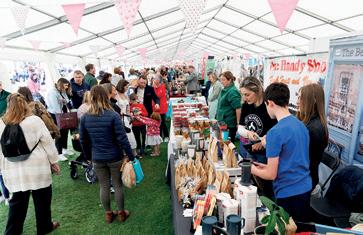
Food and drink stands will keep the thousands of visitors fed and refreshed, while a vast range of sideshows, activities and entertainments will keep the kiddies occupied.
And Robert thanks all contributors and key sponsors Binn Group, A-Plan Insurance, Netherton Equestrian, Morris Leslie Group, RD Morgan and EQ Chartered Accountants for their support.
“Perth Show is a grand day out,” said Robert. “This event is unique among county agricultural shows in that it is held in the heart of a city, allowing local people to get a real sense of the country and the farming community right on their doorstep.
‘It’s not just about providing a get-together for farmers,” he said. “We offer entertainment for all the family by diversifying into a food and drink festival, skills demonstrations, show ground entertainment, educational activities and a wealth of agriculture related interests, appealing to a much wider audience and truly bringing city and country together in a two-day special.”
PERTH SHOW 2023 www.farmingscotlandmagazine.com 23
Something for everyone
Livestock on parade
How to tackle the tiny but troublesome field mouse, …fast!
By Laurence Barnard Country Business Manager for Professional & Specialty Solutions at BASF

Field mice, also known as wood mice (Apodemus sylvaticus), are troublesome pests that can cause a whole host of issues if they find their way indoors.


Cousins of the House mouse, these rodents make their way inside buildings in search of food, water, and shelter, but the consequences of a field mouse infestation can cause several issues.
From chewing through electrical wiring and pipes, to causing damage to foodstuffs, furniture, fixtures and belongings, there isn’t much that a field mouse won’t enjoy gnawing. They also mark their territory with urine and transfer harmful bacteria as they scurry around, posing a potential risk to humans’ health. Not only that, but they can carry a potentially fatal respiratory disease known as Hantavirus, as well as posing the risk of Lyme disease through fleas and ticks.
Ask any pest controller, and they’ll probably have had issues with field mice in the past. But what makes this particular species so tricky to target, and how can pest controllers combat a challenging infestation?
Laurence Barnard, Country Business Manager for Professional & Specialty Solutions at BASF and
former pest control professional, suggests the following approach:
“We all know that the best way to handle a pest is to prevent a problem from taking hold in the first place, so an Integrated Pest Management (IPM) programme is key, which can be achieved in a few easy steps:
“Assess the site for potential entry points. Field mice can squeeze through gaps as small as 5mm – that’s about the width of a pen – so take extra care to inspect buildings. Pay particular attention to areas such as door frames, windows, vents, and any gaps in walls, beginning at a lower level before moving higher up the building. Look out for droppings, and damage that may indicate where the nest is located.
“Proof buildings once a thorough inspection has been carried out. This includes blocking any access points to prevent reentry, but also proofing around the building itself. Environmental management such as cutting back surrounding vegetation and ensuring the surrounding site is clean and tidy will have a huge impact when it comes to reducing the risk of an infestation.
“Monitor for activity using a monitoring paste. This will help
www.farmingscotlandmagazine.com 24 PEST CONTROL
Laurence Barnard
you establish how big of a problem you may be facing and get an idea for a colony’s movements. BASF’s Monitoring Paste is a highly palatable, soft block formulation that field mice will consume even with alternative attractive food sources available. If neophobia or bait shyness is a problem, try using a covered and protected approach by creating bait stations using materials already on the site, such as slate, wood or even old tyreswhatever sturdy items you can find can be used!

“Use a field mice-approved rodenticide to tackle the infestation once you have established areas of activity. Selontra® is the only professional-use product on the market to target this particular species of mice. Suitable for use in and around buildings, its stopfeed effect means that rodents stop moving 24 hours after a lethal dose is consumed, so pest controllers can gain control in as few as seven days, and its active ingredient cholecalciferol is neither bio-accumulative nor persistent in the environment. Plus, it features

the same highly attractive formula as Monitoring Paste, so field mice won’t know the difference, meaning you can tackle the problem and move on to your next job!”
To become a certified Selontra® user, complete a short 30-minute training session at https://www.training.selontra. com/.
Find out more about Selontra® at https://www. pestcontrol.basf.co.uk/en/ Products/Overview/Rodenticides/ Selontra.html
PEST CONTROL www.farmingscotlandmagazine.com 25
Scottish glen becomes hub for climate and nature tech innovation
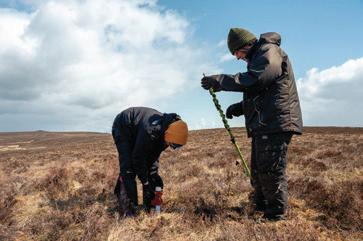
A first of its kind innovation and technology proving ground for climate solutions for the world’s farmers and land managers has been launched at a remote Scottish hill farm.
The Climate Innovation Hub at Glensaugh has been set up in an Aberdeenshire glen by independent research organisation The James Hutton Institute to plug a critical gap in access to real-world farming and land management sites to prove and reduce the risk of new climate friendly technologies and ideas.
Through the hub, technology developers will have access to the institute’s 1,000 ha research farm, including offices, conference facilities and laboratories, to help them develop and test novel concepts and tools, from new smart sensors to recycling farm waste.
The hub, funded by the Macaulay Development Trust (MDT), a charity which supports research into sustainable use of land and natural resources, has already welcomed its first tenant, carbon capture start-up UNDO.

The firm is trialling a technology that aims to both enrich soil and help sequester large volumes of carbon dioxide, by spreading crushed basalt rock onto agricultural land.
In partnership with CENSIS, Scotland’s Innovation Centre for sensing, imaging and Internet of Things, the hub will also be home to another cutting-edge new initiative, the Centre for Smart Natural Capital. This will provide a unique platform for the development of smart sensing, monitoring and advanced computing and analytics needed to inform the growing field of natural capital.
Antonia Boyce, Climate Innovation Hub Manager, says, “Reducing emissions in the farming and wider land management sector is a real challenge across Scotland, where agriculture is responsible for about 19% of our emissions and it’s essential that we enable innovation to tackle the problem. But it’s not easy for innovators to test their ideas or collaborate with others working in the same space, so we’re inviting companies or individuals with great ideas they want to test out to get in touch.
“With the Centre for Smart Natural Capital also being hosted here, it will possibly also be the smartest hill farm in the UK.
We aim to deploy a growing variety of both mainstream and emerging intelligent wireless
communications technologies to support farm and estate-wide remote sensor deployments.”
Carbon Capture Scotland secures funding deal from international investor
Dumfries and Galloway based Carbon Capture Scotland has secured a seven figure sum investment from Steyn Group to facilitate further growth in a deal managed by Scottish law firm Thorntons.
Carbon Capture Scotland is the UK’s leading and most active net-zero carbon capture asset specialist, and already operates one of the UK’s largest dry ice manufacturing sites. It now has ambitions to develop the world’s largest carbon capture plant by 2024, which the latest funding round supports.
Carbon Capture Scotland uses specialist technology to capture biogenic CO2 emissions, meaning CO2 that is captured through the growth of plants and
other biomass. These emissions can be processed and either used to create sustainable products or stored permanently underground.
The process removes CO2 emissions on the atmosphere and has potential to reverse the effects of global warming. Ultimately, the

www.farmingscotlandmagazine.com 26 environment

work of Carbon Capture Scotland supports a range of businesses and positively contributes towards Scotland’s ambitious targets of net zero emissions before 2045, and the UK’s by 2050.
The business, run by CoFounders and brothers Richard Nimmons and Ed Nimmons, operated as Dry Ice Scotland in 2012 before rebranding the operation to Carbon Capture Scotland in 2022.
Richard Nimmons said: “We are leading the way in commercialising proven and scalable CO2 utilisation technologies. Ultimately, we put CO2 to use in a way that benefits wider economic growth and society whether that be for food and beverage manufacturing or removing it to reduce its presence in the atmosphere.
“This latest funding will be instrumental in enabling us to
achieve our goal to be the global leader in carbon capture, which is a huge coup for Scotland.”
The deal was managed by Alistair Lang and Columban Young-Smith, from Thorntons’ Ventures and Innovations team, which works with early stage and high growth companies from its offices in Edinburgh, Glasgow, St Andrews and Dundee.
Thorntons’ partner Alistair Lang said: “Carbon Capture
is a fascinating and rapidly expanding market and the work of Richard and his brother Ed in this sector is impressive. We’ve worked with their business supporting on property matters as well as new carbon capture contracts and agreements. This funding has opened even more doors for growth and we’re proud to have played a role in supporting such an ambitious and successful Scottish business.”
British firm Agricarbon selected for Major European Climate Project
Agricarbon, a Dundeebased automated soil carbon measurement company has partnered with HeavyFinance, a European climate tech investment marketplace,
The strategic partnership, centred on the launch of a 15,000ha project in Lithuania, will see the companies align on a shared vision of making the transition to sustainable farming practices and the measurement of changes in soil carbon stock.

The deal forms part of HeavyFinance’s progress of removing one gigaton of carbon dioxide from the atmosphere by 2050. Both companies believe that cost effectiveness, along with data accuracy, is key to unlocking participation in the soil carbon offset market.
The companies will work together to test new stratification methodologies and remove previous barriers to direct measurement of thousands of hectares, all under a major international protocol for offsets.
Stewart Arbuckle, Cofounder & Chief Technology Officer of Agricarbon comments: “We are excited to be working with HeavyFinance as their innovative business model and understanding of and ability to deploy a direct measurement project will be extremely helpful across thousands of hectares, feeding into the everimportant sustainability agenda
and promoting better financial opportunities for farmers everywhere.”
Laimonas Noreika, Founder of HeavyFinance comments: “By combining the innovative financing models from HeavyFinance, including Green Loans, with Agricarbon’s innovative soil carbon measurement technology, we can begin to champion the transition to regenerative farming, achieving greater ROI for investors and making best practices more accessible to farmers. Collaboration is key to driving climate progress through the carbon credits market and we are excited to be working with Agricarbon to promote greater sustainability.”
The companies plan to scale the project across wider European companies over the
next 12 months, increasing accessibility for farmers and investors in key markets.
James Hutton Institute and BioAtlantis to develop molecular priming technology to counter the effects of climate change
The James Hutton Institute (the Hutton) is collaborating with leading research groups and industrial collaborator BioAtlantis in a new European
research project called “CropPrime.”
With EU Horizon funding of up to €1 million confirmed, CropPrime will
develop “Molecular Priming” technologies, which will enhance crop yield under stressful conditions caused by climate change. The project will

environment www.farmingscotlandmagazine.com 28
primarily focus on developing novel technologies to improve crop tolerance to stresses associated with climate change. One important aspect of the project will be the identification of natural compounds found in “plant biostimulant products” (which trigger natural plant processes that enhance nutrient use efficiency), derived from marine algae such as seaweed, produced by BioAtlantis, based in County Kerry, Ireland.
Additionally, the project will work on developing RNA (similar to DNA)-based fungicides to reduce fungal infections in crops. The overall goal of this research is to develop sustainable agri-tech products to help crop growers protect and enhance their crops against adverse weather conditions such as drought, heat, cold, and waterlogging, which are becoming more frequent due to climate change.
The Hutton along with its project partners, will investigate the molecular mechanisms underlying plant stress and how these relate to the physiological processes that support crop resilience.
Revisiting regenerative agriculture
 Rebecca Audsley, Principal Consultant, SAC Consulting
Rebecca Audsley, Principal Consultant, SAC Consulting
We are hearing more about the benefits of adopting regenerative agricultural methods as part of routine farming activities. The concept of regen ag is centred around five key principles which firmly put soil health at the front and centre of agricultural practice. Here is a short recap:
1. Maintaining a living root
The project consortium brings together expertise in plant systems biology, chemistry, genetics, and biostimulant technology from research institutions in Europe, Africa, and South America. By pooling their efforts, the consortium aims to provide sustainable solutions for crop protection to growers.


Dr Robert Hancock, Senior Biochemist and Plant Physiologist at The James Hutton Institute, said: “This ambitious endeavour aligns perfectly with our mission to drive innovative solutions for sustainable agriculture in the face of climate change.
“By harnessing the power of ‘Molecular Priming’ technologies and leveraging natural compounds derived from marine algae, we aim to enhance crop resilience and protect against the increasing stresses brought about by adverse weather conditions. The CropPrime project exemplifies the power of international collaboration and knowledge exchange, and we are excited to contribute to the global impact of this research. Together, we can pave the way for a more resilient and productive future in agriculture.”
Root exudates provide food for soil organisms at the base of the food web, which in turn help to support diverse groups of flora and fauna found in a healthy soil. A living root means there’s a growing plant above ground too, protecting the soil surface.
2. Minimising soil disturbance

Taking a reduced tillage approach to minimise soil disturbance can help to promote good soil structure, increase organic matter content and support the biological processes that happen in the soil.
3. Maximising crop diversity
Above ground diversity leads to below ground diversity too, as different species of plants associate with different soil organisms, supporting the soil food web. Diversity can be increased on many farms, such as by adding different crops into the rotation or through more novel approaches such as companion cropping.
4. Keeping soil covered
From crop residues to cover cropping, keeping the soil
covered protects the soil from erosion caused by heavy rain or wind and helps soils retain moisture.

5. Integrating livestock
Bringing livestock back into the arable rotation brings benefits to the soil in terms of soil structure, microbial diversity and introduces valuable organic fertilisers back into the system.
Where suitable, taking a regenerative agriculture approach can bring other benefits, for example better water filtration, improved water holding capacity, nutrient cycling and increased biodiversity.
At Farming for a Better Climate, we have been working with five progressive farmers who have been taking these principles and putting them into practice. You can read more about their activities, along with practical guides looking at the five concepts in more detail, on our webpages at www. farmingforabetterclimate.org Sign up to our newsletter, find us on Facebook or follow us on Twitter @SACfarm4climate.
www.farmingscotlandmagazine.com 29 environment
Farming for a Better Climate is funded by the Scottish Government.
Fruit for the Future 2023: Breeding progress for a challenging climate
Dr. Susan McCallum and Dr. Julie Graham, James Hutton Institute
Fruit for the Future is Scotland’s leading soft fruit event for knowledge exchange, bringing together the key players in the food and drink industry, from farmers and agronomists to processers and suppliers, to demonstrate and discuss key industry issues.

The event, which will be held on 27 July at The James Hutton Institute, Dundee, features
field walks and presentations from breeders, researchers and agronomists. Topics will include an update on advances across blackcurrant, raspberry and blueberry breeding programmes as well as an insight into the use of remote tools to study plant-pollinator interactions and potential of machine harvesting.

The UK soft fruit industry continues to grow year on year
with a market value of over £1.7 billion. There continues to be strong consumer demand for soft fruit throughout the UK, driven in part by the significant progress made in breeding with the production of sweeter, larger, high yielding varieties with greater shelf life compared with those previously available. Although the sector continues to flourish, the cost of production
has also increased dramatically which means that new varieties must be developed which have larger, well displayed fruit to help to increase picking speeds and keep harvest costs sustainable. Although consumers consistently rank UK grown fruit quality ahead of imports, purchasing patterns themselves mainly reflect price. Alongside new varieties, technology to aid in the growing
www.farmingscotlandmagazine.com 30
FRUIT FOR THE FUTURE
and harvesting of fruits will also be important to combat the everdecreasing margin of profitability.
Scotland is synonymous with soft fruit with our rolling landscapes, fertile soils and relatively cool climate which is perfect for developing high quality crops.
Over the last few years, however, we have seen the impact of a changing climate and its effect on several of our soft fruit crops. The hot, dry summers have resulted in problems such as narrow harvesting windows and variability in fruit quality for some growers. Extended periods without rain have seen water resources stretch to capacity while we have also seen milder winters that impact on timing and efficacy of bud break and thus yield, and periods of heavy rainfall resulting in soft fruit. These shifting weather patterns make the tasks of predicting yield, inputs, and harvesting that much harder for growers, and can threaten both the productivity and profitability of the entire crop.
Projected forecasts for climate change, however, do suggest that Scotland could continue to be a highly suitable growing region for soft fruit in the future while some areas of England may see their climate becoming too hot and too dry. This means that developing new high quality, resilient varieties as well as adapting growing and harvesting techniques is more important for Scotland than ever.
The last few years have been incredibly difficult for many growers across the UK who are not increasing acreage because of the rising costs and volatility of demand due to ever increasing (cheaper to produce) imports. Add this to the growing concerns over both the availability and cost of primary resources such as water, substrate and fertigation means that new varieties must also be more resource efficient and be more resilient to climate change and emergent pest and disease threats that are likely to come as a result.
At Fruit for the Future, visitors will hear about promising new selections which are being
developed which are expected to have greater levels of climate resilience and be more resource efficient. Research is underway looking at differences in blueberry cultivars and how they respond to variations in light levels and how that impacts on yield.
The raspberry breeding programme focuses on breeding robust new cultivars for the fresh market which require fewer inputs and are suitable across the whole supply chain. The programme deploys molecular markers to identify important traits early in the breeding process. Whilst outstanding fruit quality remains high priority, more recently, increased efforts are focused on reducing production costs by selecting genotypes with improved picking efficiency and optimising resource use to improve crop consistency and reduce waste.
Blackcurrants have been bred at the Institute since 1956, the Institute has since become a world leader in Ribes species with the variety’s series ‘Ben’ being cultivated worldwide. The improvement for plant resilience, and pest and diseases tolerance are high priorities for growers facing the present and future uncertain climatic conditions and challenges.
Our blueberry research focuses on improving efficiencies, including the reduction of inputs, waste and water footprint while enhancing crop yield and quality. New advanced selections will be on display showing progress from the last six years of breeding. Advances in terms of machine harvesting will also be discussed and how this could help maintain Scotland’s sustainability in the soft fruit industry.
Fruit for the Future takes place from 3pm – 6pm on 27 July at The James Hutton Institute, Invergowrie, near Dundee and is supported and promoted by The James Hutton Institute partnered with James Hutton Limited. The event is sponsored by the Scottish Society for Crop Research. For booking information: https:// www.eventbrite.co.uk/e/fruit-forthe-future-tickets-608702705177
crofting
Honouring the pledges
By Patrick Krause, Chief Executive, Scottish Crofting Federation



Scotland’s agriculture depends on livestock production and yet we have hardly any abattoirs. We claim high animal welfare standards but force some crofters to travel huge distances with their livestock trailer. We want to cut the fuel impact of agriculture yet have very few local abattoirs, massively increasing food miles. We claim an interest in local food and food provenance yet in most cases crofters have to put their specialist animals into the general meat market of a few large-scale abattoirs.
The fight for more local abattoirs has been going on for decades but how little the Scottish Government has done to help the situation despite manifesto pledges. In the 2021 SNP manifesto, it says it has the aspirations of agricultural outcomes focusing on a drive towards “low carbon approaches which improve resilience, efficiency and profitability”.
That same manifesto also has a commitment to “support the growth of local food markets... to bring fresh affordable produce closer to where people live and work”. Home-grown meat, especially with the credentials of extensively-grazed croft meat, is a very sought-after local food, but where are the local abattoirs?
‘The Greens’ (SGP) go further by committing in their 2021 manifesto to rolling out a
“network of mobile abattoirs for rural and island communities, to support crofters whilst minimising live animal transportation”. A great aspiration, exactly what we have been asking for, but where is it? It doesn’t seem to feature in the Programme for Government beyond generalities about strengthening local food production and improving food security.
If existing abattoirs in rural & island communities don’t get support now, there will just be more locations that need mobile abattoirs which will cost the government (us, the tax-payer) more money in the long run. They say they want to support provision of abattoirs closer to where the livestock is reared for the outcomes mentioned above, so they need to put their money where their mouth is.
And whilst on pledges to support local communities, the SGP 2021 manifesto also commits to:
- “provide funding to establish community and crofter led wool processing and manufacturing businesses.” and
- “Establish local crofter and producer food co-ops to sell direct to the public and the hospitality and tourist trade”.
I see the SGP commitment to removing local fishing and thereby devastating coastal communities but I don’t see these pledges being honoured.
www.farmingscotlandmagazine.com
www.crofting.org
science & technology

It is true…Autosteer has just become affordable!
The new DGPS4U Autosteer BV (Best Value) demonstrates, that in just 60 minutes you could have a great autosteer system installed on your current machinery... and for much less money than other “premium” systems. Now is the time to move your field driving practices up to the next level!
The precision guidance and driving the DGPS4U Autosteer BV offers, will deliver savings in fuel, optimise machine hours, and will help to avoid expensive waste with accurate delivery of fertiliser, seeds and other consumables. Supplied with all you need to program and use, including the simple to follow interface and graphics, this package includes: superb +/- 2.5cm accuracy, single
GNSS Antenna module, terrain compensation features, large 410mm steering wheel with huge steering power, GNSS RTK / EGNOS technology as standard, fitment for over 90% vehicles... straight out of the box, IP66 / IP65 rated, amazing Return on Investment and increased driver welfare, as Autosteer can help reduce fatigue.
At DGPS4U our ambition is to give you higher profitability with less environmental impactthat is good for everyone! Using our selected “BV” products and technology has you covered for all seasons…Ploughing with Tractors, Sowing with Seed Drills, Fertilising with Sprayers, Harvesting with Combines and much more!
Interested in the DGPS4U autosteer BV or for more information on our other products, including guidance systems, antenna, mobile DGPS,

cameras and monitors. Please call us today on +44(0)1339 883361 / Mob +44(0)7770 765411, email info@dgps4u.com or visit our website www.dgps4u.com.
New camera improves detection of hues of blue
LEMKEN introduces the new IC-Light+ camera control, which also detects the near-infrared range, for its Steketee hoeing machines. The new camera control makes detection easier in crops with a high proportion of blue in the leaves. This offers clear advantages in mechanical weed control, especially in the cultivation of onions, leeks, broccoli or red cabbage.
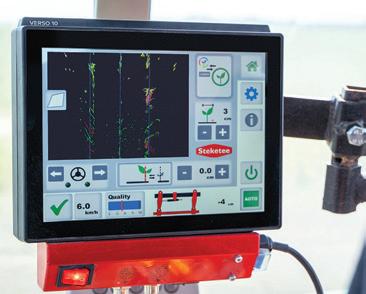
The internally developed standard IC-Light camera system in LEMKEN Steketee hoeing machines captures the RGB colour range and reliably distinguishes between hues of green and red. Thanks to its
self-learning mode, the system continuously develops as it is being used. The new IC-Light+ camera now also captures hues of blue as well, allowing even very young plants or plants with a particularly fine structure to be better identified and shown. The camera easily handles even onions the size of a pin.
The IC-Light+ camera is operated via the IC-Light terminal and allows hoeing as close as two centimetres from crop plants at forward speeds of up to 15 km/h. The camera detects up to five rows of plants at a time and controls the steering of the hoeing machine between the rows.
www.farmingscotlandmagazine.com 32
Boost for innovative climate change farm projects

Researchers at Scotland’s Rural College (SRUC) are involved in four industry-led innovative farm projects offering climate-focused solutions and farming technology.
The projects are funded by Defra’s Farming Innovation Programme and delivered by Innovate UK, part of UK Research and Innovation (UKRI.

Genus and researchers at SRUC, led by Professor Rainer Roehe, are providing targeted genetic solutions to the reduce environmental impact of the UK beef supply chain.
They have carried out groundbreaking research on beef cattle showing the potential of ruminal microbiome-driven breeding to mitigate methane emissions by up to 17 per cent per generation and improve the feed conversion ratio by up to 15 per cent per generation.
The award will enable the project to optimise and validate this new breeding strategy under practical conditions.
MI:RNA Ltd, working in partnership with SRUC Reader Spiridoula Athanasiadou, was given funding for its Johne’s disease identification project.

This project will combine a unique biomarker testing technology with artificial intelligence (AI) to help detect early-stage Johne’s disease in cattle, which leads to a significant reduction in milk yields and weight loss, as well as increasing the greenhouse gas production from affected animals.
A project led by Aquanzo, in partnership with SRUC Professor Jos Houdijk, will develop farmed marine proteins for poultry feed.
Finally, Synergy Farm Health received funding for its bovine tuberculosis (bTB) antibody testing project.
The project, which involves SRUC Professors Mike Coffey and Georgios Banos together with partners from NMR, will carry out a longitudinal study with an antibody test to detect bovine
tuberculosis in bulk milk with the aim of improving the control of bTB in dairy herds through better welfare surveillance, reducing overall costs for farms and the taxpayer.
Eileen Wall, Head of Research at SRUC, said: *As we navigate the complex and pressing issue of climate change, it is paramount that we work together with the farming industry. Our farmers are not only the custodians of the land, but also critical partners in developing and implementing solutions that support sustainable food production and environmental protection.
“By linking science with the invaluable insights and experience of our farming industry, we can accelerate our efforts to tackle climate change and bolster the resilience of our agricultural sector. These projects demonstrate how SRUC research continues to collaborate with our industries to both innovate and implement solutions to tackle the climate change challenge head on.”
For more information about research at SRUC, visit: www. sruc.ac.uk/research/
www.farmingscotlandmagazine.com 33 science & technology
Tillage equipment available today
The Kuhn Performer Cultivator
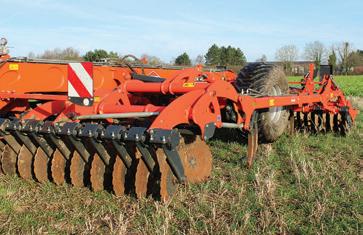
The KUHN Performer is a deep cultivator, available in working widths from 3 to 7 metres, designed to prepare the soil for minimum tillage drilling. The Performer fulfils four cultivation tasks in one, by chopping, mixing, loosening, and levelling the soil in just one pass.
At the front of the machine there are two rows of hydraulically adjustable, 510mm cutting discs. The discs are capable of cutting through crop residues and root systems and can be used independently for stubble cultivation at depths of 10 centimetres, even at higher speeds.
The discs are followed by hydraulically pressured tines with options for 80mm standard points, 50mm carbide points with deflectors, or 80mm and 50mm carbide points. The carbide coating provides strength and durability, making the tine longer lasting. The tines can be adjusted to operate at depths of 5 to 35 centimetres, depending on the point chosen, to cover a wide variety of soil types.
Behind the running wheels, are four rows of tines set at equal widths that perform an in-depth mix, incorporating any residues and straw into the soil. Also available as standard on the Performer are 350mm carbide wings.
In addition, a single row of star shaped levelling discs provide a fine tilth. At the rear of the Performer is a double U-shaped packer or the option of an HD liner roller to roll the soil and leave an even finish.
All of the Performer’s functions are adjustable from within the cab using KUHN’s KTH 105 selector terminal
which only requires one double acting valve for the axle and a single acting valve for the safety legs. The discs can be operated independently for stubble cultivation and the roller can be lifted and carried above the soil when not required.
The Performer range is designed for tractors with outputs of between 180 horsepower for the 3 metre machine and 420 horsepower for the 7 metre model. It also folds to less than 3 metres, making it ideal for tight gates and narrow lanes.
North Yorkshire arable farmer, Matt Harrison, bought a Performer 4000 for his family farm in Wistow, near Selby. It has become the primary cultivator for the 1500-acre farm following a decision to move away from a plough-based system. Mr Harrison said:
”I have been so grateful for the time savings the Performer has brought to the cultivation work on the farm. It is very easy to set up and requires far less maintenance than previous cultivators I have used. I don’t have to grease the legs and discs
to prepare the machine, which means I can take advantage of every opportunity I get.”
This time and labour saving is due to the Performer having easy to change depth settings and fewer greasing points. “It also has a control box in the cab that makes life so much easier. Using just one spool I can control the whole machine and quickly make alterations for the changing land we have on the farm,” he added.
The machine is also helping to reduce the amount of fuel needed to prepare the land.
When using a plough-based system his tractor could use 600 litres of fuel in a 10-hour day and only cover 30 acres. Whereas, with the Performer the same tractor can cover 60 acres using the same amount of fuel, which has halved is fuel cost. “We use a 2009 CAT Challenger. It is not the newest machine, but it is perfectly suited to the Performer and the cultivation work we do here. The fuel savings with a min-till system make a big difference. Especially with the recent rise in fuel costs,” he concluded.
The Amazone Cenio 3000 mulch
cultivator
The Amazone Cenio is a mounted tine cultivator which, with its 30 cm tine rows and a maximum working depth of 25 cm, is aimed at the smaller tractor with its shorter, lighter execution making the tractor lift easier, The Cenio keeps the 3
row tine layout of the Cenius for optimum soil and trash mixing as well as good passage through the machine. The rear levelling discs or paddles back-fill the tine action to ensure a level finish before being consolidated by the following roller.
The Cenio range is available in 3 m, 3.5 m and 4 m rigid mounted models and is offered with the full range of following rollers - from the simple cage, the soil on soil UW and DUW rollers, through to the wedge ring and disc rollers.
TILLAGE www.farmingscotlandmagazine.com 34
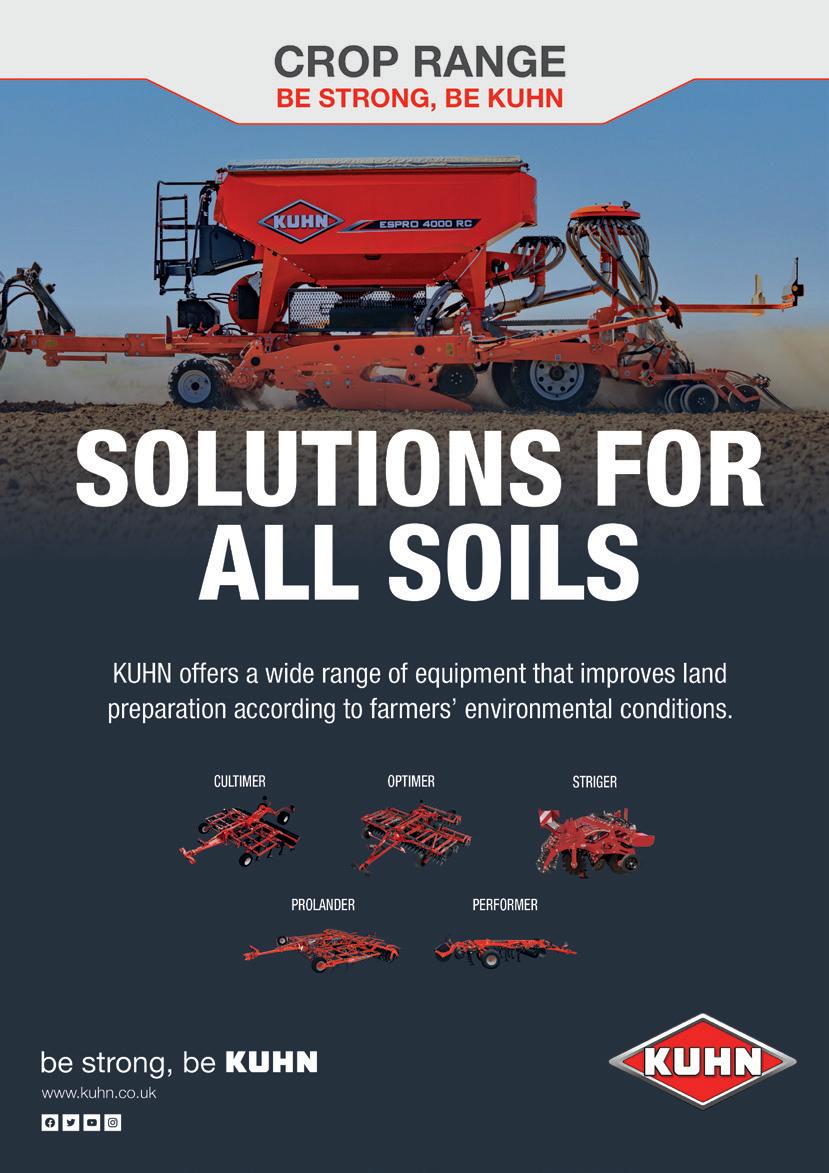
The Vaderstad Carrier XT 425-625

The Carrier XT 425-625 is a versatile agricultural implement available in mounted or trailed versions with working widths ranging from 4.0m to 6.0m. It is specifically designed for highspeed shallow cultivation and effective stubble mixing, reaching


depths as low as 10cm. With Carrier XT, you have complete control over the working depth from the comfort of the cab, including the hydraulic wing lock, ensuring precise and efficient performance on different soil types. The depth adjustment is conveniently carried
out hydraulically, eliminating the need for top link adjustments.
To cater to various needs, the Carrier XT 425-625 can be equipped with different disc options. These include 450mm discs with small notches, 470mm TrueCut discs, CrossCutter Disc 450mm, or the more aggressive CrossCutter Disc Aggressive. Additionally, there are multiple packer options available with
rubber suspension, allowing farmers to tailor the implement to suit their specific soil conditions. For enhanced versatility, front tools such as the CrossBoard Heavy or the CrossCutter Knife can be added as optional extras. These tools further optimize the performance of the Carrier XT 425-625, providing even more efficient cultivation and stubble mixing.
TILLAGE www.farmingscotlandmagazine.com 36
The Cenio Special features shear bolt overload protection for the tines – the Cenio Super
with sprung break back overload protection and a 450 kg trip force.
Making soils better makes business better
Johnnie Balfour, Balbirnie Home Farms
Since the Second World War, we’ve bought in a bag and killed in a field to produce as much as possible from an acre of land. Although still core to what we grow, we’ve side-lined the soil in the race, and it’s costing us.
Going back to whole systems at Balbirnie Home Farms, maximising on our natural assets – sunlight, water, worms and hooves – we have focused over the last eight years on making our soils better and seeing our farming business become better and more resilient. A regenerative approach to farming is a no-brainer for me, it’s about mitigating risk in a different way to what we’ve been doing for the last 80 years.
While I was living in Hong Kong, where my wife and I moved with our young family for work, I completed a post-grad in Sustainable Agriculture as well as a course at the Holistic Management Institute. I’d always been interested in Holistic Management and what we could be doing with this ethos around giving livestock a more involved role in growing arable crops.
Our Farms Manager, David Aglen, was already
experimenting with cover cropping and direct drilling, and, both on the same page, when I returned to the farm full-time five years ago, we took the handbrake off and started experimenting in multiple ways to give the soil the best chance at optimum health.
Integrating livestock into our crop rotation has been one of the most obvious uplifts – last year, the fields where we didn’t have animals integrated were less productive crops.
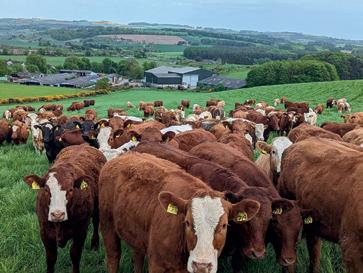
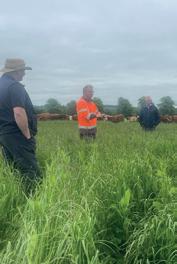
We keep big mobs of sheep on small areas of the winter sown arable fields for a short period of time, grazing enough to take the growth down but not too long that they decimate the root mass. It also allows us to rest the grass on the rest of the farm so that the covers are longer in the spring.
We grow forage crops to feed the cattle during the winter which has the benefit of keeping the soil covered year-round before sowing spring barley or oats. It brings diversity into the rotation and decreases disease pressure. Livestock is part of our toolbox of reducing the need for nitrogen and fungicide. It’s easy to tell where there hasn’t been
livestock in the rotation as we need more chemicals to manage the crops.
With the cattle outside yearround, it’s also reduced our costs on concentrated feed and manpower on both bruising the feed and feeding indoors over the winter, which is another sideways win. Grass and forage are best for the animals and we’re spending a lot less too. We’re also proud to have been certified with Pasture for Life, which recognises what this approach is doing for ecosystems, and has growing appeal for discerning consumers.
All our growing on the farm now goes through a litmus test of regenerative farming’s five core principles: reduce disturbance, cover the soil, keep living roots in the soil, retain diversity in the crops and integrate livestock. What we’re doing is not complicated – we very much keep to the KISS (Keep It Simple) approach. We haven’t got it all right, and like any change in farming it takes years not days to see the real results. That’s why I’m really looking forward to GO (Groundswell Outreach) Falkland
this summer, to learn from others who are experimenting with different methods and delving into the science of soil. There’s an amazing line-up of different perspectives, from scientists to on-the-ground practitioners and highly regarded authors like Anne Biklé, and stages on the ‘journey’.
There’s a lot of conversation around regenerative agriculture underway in the south of England, but what works in Essex won’t necessarily work in Fife, so it will be particularly valuable to hear from experience in a Scottish context. It’s going to be a wonderful showcase of what’s already happening in Scotland, embodying the spirit of the Groundswell Festival of food and farming, with huge opportunities to speak to and to learn from, and with, the agricultural community in Scotland.
Johnnie Balfour is Managing Partner at Balbirnie Home Farm. He is on the GO Falkland committee and has worked with his neighbour Ninian Stuart at Falkland Estate and the Cherry family who founded the Groundswell Festival in Hertfordshire, with the wider committee and organising team to bring together this inaugural fringe event for Scotland.
For the full GO Falkland programme and to book tickets see: https://falklandestate. co.uk/go-falkland/.

www.farmingscotlandmagazine.com 37
ARTICLE
Johnnie Balfour, Managing Partner at Balbirnie Home Farm and coorganiser of GO Falkland
The cattle grazing above Balbirnie Home Farm
Looking at grass with Balbirnie Farms Manager David Aglen
Vogelsang is encouraging farmers to think of their slurry as ‘liquid gold’ to help with costs

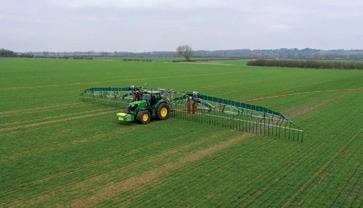
Agriculture supplier, Vogelsang, is encouraging farmers to think of their manure as ‘liquid gold’ as a combination of Government restrictions and high fertiliser prices comes to the fore.
According to analysis by the Energy and Climate Intelligence Unit (ECIU), farmers could be paying an additional £1.1 billion for fertilisers in the years between 2021 and 2024. Farmers are also facing additional spreading and storage restrictions such as the Clean Air Strategy, under which slurry must be applied using low emission spreading equipment by 2025.
Sion Williams, Agriculture Manager for Vogelsang, said:
“Farmers have had a tough time lately. They are being tasked with
addressing their emissions being released into the atmosphere, and are faced with more restrictions on what they can and cannot
do in terms of fertilisation. This is causing a bind for farmers, especially since last year’s nitrogen price spikes. Many farmers want to cut their emissions and are being told that it is actually good for their farms, but it needs to stack up financially. Because of this, more and more farmers are using liquid manure as their go-to fertiliser, which is great as it’s so much more than a waste product; really it’s liquid gold.”
Sion added: “But it all comes down to how you use it, and many farmers are essentially throwing away this precious resource by the way they spread it - or worse
topic
still - leave it sitting in the lagoon. For instance, using a splash plate loses 80% of the ammonia nitrate in liquid manure - you can literally see the pound coins disappearing into the atmosphere through lost nutrients.”
Because of the nitrogen lost through ineffective spreading, Vogelsang is highlighting the benefits and importance of precision slurry spreading. Tactics such as low-emission spreading methods using trailing shoes and dribble bars - which direct the liquid manure to the base of the crop - and covering slurry stores, can help prevent nutrient losses and emissions into the air.
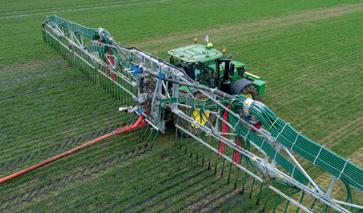
John Williams, Head of Soils and Nutrients at ADAS, said: “Spreading slurry accurately and evenly at times when crops are growing will maximise economic returns and minimize losses to air and water. A 30m3/ha of typical dairy slurry applied in spring has an N, P, K (nitrogen, phosphate, potassium) replacement value of over £160/ha. Using dribble bars and trailing shoes can typically reduce ammonia emissions from spreading by between 30% and 60% compared with surface broadcasting. Targeting fields with low soil P and K levels is also key to slurry fertiliser value.”
To help farmers understand and calculate the nutritional value of their slurry and best plan for its use, Vogelsang has created a helpful guide, available online, alongside the ADAS and the Farm Carbon Toolkit. 3 Steps: Creating A Liquid Manure Nutrient Management Plan | Vogelsang.
Becky Willson, Business Development and Technical
Director at Farm Carbon Toolkit, said:
“Manures are a fantastic resource to be used on the farm to both reduce the need for expensive artificial fertiliser, and through the addition of organic matter into the soil which also supports farmers delivering climate solutions. At Farm Carbon Toolkit, we work with farmers who, by focusing on nutrient management planning, are able to generate significant financial savings and emissions reductions, as well as enhancing their business resilience for the future.”
Vogelsang hopes that an increased awareness of better slurry management will see farmers benefit from lower outgoings and more easily adhere to Government guidelines using a mix of nutrient awareness and better slurry application.
Steve Jones, owner of Hooftrimming Ltd, said: “We wanted a direct and precise way of applying the liquid manure. Since using Vogelsang’s dribble bar and trailing shoe system we have been able to offer customers a more economic and environmentally friendly way of manure application. The product is spread below the plant leaves, this method offers significant reductions in odour and contamination, as well as ensuring maximum nutrients are applied to the ground.
“My customers have been impressed with the reduction in fertiliser costs because of the minimal nitrogen losses and accurate application from the Vogelsang system. We are definitely providing a high-quality service for our customers and a large part of that is down to the machinery we use.”
Scotland

The Brand
Scottish Agritourism Provides Opportunities for Income
By Ruth Watson
Agritourism brings £60million into the economy, much of it flowing through small communities. Many more farmers and crofters have entered the retail business, selling directly to the public through premises on their land or through local deliveries.
The new Chief Executive at the National Farmers’ Union of Scotland is John Davidson, fresh from Scotland Food and Drink, bringing a strong understanding of the potential for farmers to put the best of Scotland’s larder on the table.
“Clear provenance and local food and drink is fundamental to the success of agritourism. The Scottish name itself is a story people want to hear. There is strong demand, and I would encourage farmers and crofters to work with others in their area to enhance our reputation for what we already do extremely well.”
The Scottish Agritourism Strategy aims to get 1000 farms into agritourism, and for 50% of those farms to be providing their own food and drink as part of the experience. Caroline Millar is the Sector Lead, Co-Chairing the National Agritourism Strategy Implementation Board with
Mairi Gougeon, Cabinet Secretary for Rural Affairs, Land Reform and the Islands. She runs ‘The Hideaway Experience’ from her farm outside Dundee.
“We are seeing a huge interest in the sustainability of farming and the welfare of the animals. We have a real opportunity to get more folk onto farms across Scotland. They are more likely to close the gates behind them and keep their dogs on leads because they understand the countryside and feel more connected to it,” Caroline says.
Caroline clearly is passionate about the opportunities it offers, especially when local producers work together:
“Farmers are working really hard to tell the story of their food; putting together welcome baskets with produce from 5 or 6 local farms, for example. Visitors love it!”
As farmers face increasing pressures, local produce and on-farm experiences provide real potential for much-needed revenue.
www.farmingscotlandmagazine.com
Ruth Watson is the founder of the Keep Scotland the Brand campaign.
topic
The Power of Laurencekirk
By Janice Hopper
Just off the A90 near Laurencekirk is a bustling company that provides services for many local and Scottish farmers. It employs 22 people plus three company directors, it sends out ten vans a day to all corners of the country, but this forty year old successful business was established in 1983 by a dairyman who was a bit down on his luck.
Jack Whitecross worked on local farms, his father before him
had done the same. Jack wasn’t a young entrepreneur who always wanted to run his own business. He simply did an honest day’s work for an honest day’s pay. But when the farming work dried up and he was let go, he found a position at an engineering firm that sold power washers. Jack felt that these machines were being sold in good faith, but lacking long term provision for their maintenance, their spares and their longevity.
Basically, he saw a gap in the market. So Jack visited the bank, secured a £5,000 loan, and set up Powerwasher Services Ltd. The money funded a van, some basic tools and a portacabin. It was 1 July 1983.

Today the company offers a range of cleaning, heating and workshop equipment across a mix of sectors, from food production and haulage, to farming and oil and gas. Jack’s daughter Liz and


son Jim are Managing Directors. Jack’s grandchildren, Kevin, Nick and Rebecca also work in the ‘family firm’, with Kevin and Nick being Associate Directors, so I visited the Laurencekirk depot to find out more from daughter Liz Carnie.
“I remember dad started out doing everything himself,’ says Liz. ‘He was a one man show, and learned on the job. Within a few months of setting up the business
POWERWASHER SERVICES LTD www.farmingscotlandmagazine.com 40
he invested in two powerwashing machines and took them to the Fettercairn Show. One customer was interested in buying the small machine but dad looked at the vehicles that the client needed cleaning and said he wouldn’t sell the little machine because the customer needed the bigger one. From the very beginning dad’s been very particular about supplying the right machine for the right job’, stresses Liz. ‘He was primarily targeting the agricultural market, as that was his background and what he knew, but one of his earliest customers was a haulage company in Aberdeenshire. Other early clients included oil companies in Montrose and Portlethen, so dad realised there was wider potential for his products.”
Liz describes a tough schedule for Jack, on the road by day, in the shed doing repairs by night, and, in the days before mobile phones and the internet, trying to spread the word about his business by attending farm
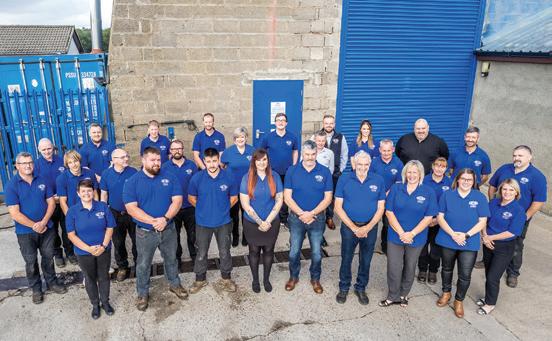
shows, printing leaflets and handing out business cards.
As his name slowly spread the agricultural world was changing and modernising too. Farm machines swapped out wee
tractors for the large mechanical beasts we know today, sheds and outbuildings were replaced by modern state of the art stores, warehouses and parlours, and the days of sluicing out farms
by squirting a humble hose were numbered.
Powerwasher Services Ltd was able to provide big machines for big jobs and big spaces, cleaning areas more efficiently, powerfully and to

www.farmingscotlandmagazine.com 41 POWERWASHER SERVICES LTD
All the staff
a higher standard. The company diversified into space heaters, used for areas such as potato storage sheds, drying grain and heating for farm employees’ personal comfort. Another expansion was into air compressors. Every farmyard relies on good tyres, plus many chicken and pig farmers’ feed machines rely on air compressors. And power washers were being used for appearances as well as
cleanliness: modern farmers took increasing pride in their machinery, washing their tractors similar to how they’d wash their cars, keeping everything looking smart and in good condition.
Changes and modernisation of health and safety laws also brought Powerwasher Services work, as new laws regulated what farmers could and couldn’t do. PWS provided machines such as

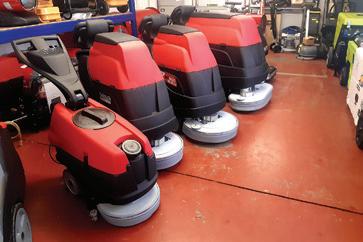
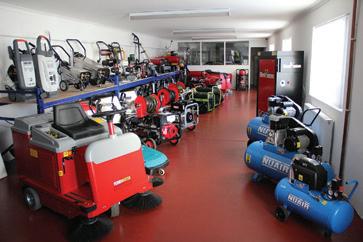
sweepers to clear up dirt including fine potato dust. Historically it used to be the norm to sweep it up manually whereby it would waft into the air and particles were breathed in by farmers and their staff. Changed attitudes to health at work altered what was acceptable, and sweepers helped contain and remove dust more efficiently. With new customers, machines and markets to cater for, PWS was
getting busier year on year. Liz joined the team in 1990 to help her father. She had previously worked in the RAF and the police force, and was ready for a new challenge. In 1993 Jack also trained up an engineer to assist him with all the machinery. Liz’s brother Jim joined the family business too, and they both became partners in 1999. Jim was hands on and out in the van, while Liz focused on
POWERWASHER SERVICES LTD www.farmingscotlandmagazine.com 42
Showroom
Scrubber Driers

sales (visiting potential clients), accounts and office management. Neil Ingram joined the team in 2001 and is now one of the three Associate Directors, and a Service Manager.
Today if you visit you’ll find eleven members of staff working onsite, which includes the office team, service team, stores team and workshop engineers. They offer onsite servicing and repairs, or the engineers on the road will happily drive to a customer to do the work, especially as many of the machines are so big. Two full time staff are employed in the parts store. They ensure that the vans are full of all the parts required before the team hits the road. The Parts Supervisors also assist customers who perhaps drop in to pick up a spare part, they post parts out to customers across the UK, and sell detergents and a range of goods to complement the machines.
The staff at PWS generally has a low turnover, and most are trained from scratch. Many have an agricultural background rather than coming from competitors. This means they need to be schooled in the world of power washers, space heaters, air compressors and sweepers as it’s a relatively niche industry and arguably quite a specialised skillset. Admittedly many of the team do a lot of travelling throughout the week. There are usually two vans working in Aberdeen, and other members of the fleet visiting farms and businesses all over Scotland.
“We’re the biggest company of our kind in Scotland, and good maintenance is and always has been our USP. When we sell a machine that’s not the end of the story. Some customers, once they’ve purchased their machines, we rarely hear from them, others request regular services and we get to know them over the years. It can depend on how regularly the client uses the machines — if it’s in use three times a day, every day, we’re more likely to maintain and repair that machine as it plays a core function in their business. Our staff are proactive, contacting customers to remind them a service is due, and we’re happy if the client wishes us to carry out that work for them.’
Our customers also know that we stock a range of brands,’ continues Liz, ‘We’re not tied to one brand only but stock machines from various suppliers such as MAC International and Kärcher. MAC International provides one of our most popular machines but we’ll pick and choose which machines deliver best in each individual situation. We’re keen to help our customers make sensible choices, because these machines are a big investment. Yes, someone can walk into the showroom and simply buy what they need, but we often conduct site surveys, and then product demos at their farm/shop/factory to reveal what machines suits our customer best. We invest time in the front end so that our products deliver on the job over the years.”
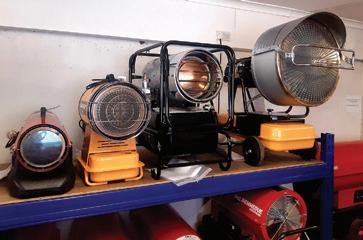
The family’s farming links also led them to work in food production and factories. Naturally these industries have very high hygiene standards, a never ending cycle of cleaning, a myriad of laws to comply with, plus regular site inspections. New machines now include scrubber driers that prevent any splashes onto walls/surfaces. As the floor is left dry there’s far less risk of slips and falls, essential in the modern litigious world, so these machines are sold to shops, showrooms, restaurants and event spaces. Another appreciated local client was P&J Live that opened in 2019 in Aberdeen.
Lastly, the location of Powerwasher Services is part of its story too. Jack set up the company next to the house he happened to be lodging at in Aberdeenshire. It was that simple! Situated just off the A90 means the team covers all of Scotland into Northern England, but Aberdeen to Perth is on their doorstep. They indirectly receive free advertising as thousands of cars pass the clearly signposted depot every day, and the location helped the company get a footing within the oil and gas industry thanks to its proximity to Aberdeen. ‘The oil companies knew we were on call and could reach Aberdeen within forty minutes,’ says Liz.
But it hasn’t all been plain sailing. Every company with a forty year history has faced some bumps on the road. The 2001
foot and mouth outbreak was a traumatic episode in the farming community, and impacted severely on companies like PWS who worked alongside them.
“Hygiene was a key focus in the foot and mouth hotspots so while competing companies in Cumbria and the Borders did well there was an immediate drop off of business for PWS’, says Liz. ‘All shows and marts were cancelled, plus access to farms was off the cards so it was almost impossible to get work done. After the immediate disaster had abated, a vast array of second-hand washers flooded the market from farmers who no longer required them, making it harder to sell new machines. It took a long while for the market to stabilise.”
2020 also brought a truly unexpected curveball. Covid impacted on every single Scottish farm, business and individual in a myriad of different ways.
“At Powerwasher Services Ltd, we were classified as essential workers because we worked alongside so many essential providers,’ explains Liz, ‘The farmers didn’t stop farming for example. But it was a very stressful time for us. At first we furloughed half the staff, the other half worked remotely, but it was heartbreaking to look at this business that had been built up over the years and realise there was nothing you could do to protect it. We were as scared and stressed as the next person,’ says Liz. ‘By September 2020 we had everyone off furlough, back working but still operating within Covid regulations. Office staff worked from home, the staff in the
vans could operate alone, driving to rural farms to work on machines in isolation to ensure the smooth running of the businesses and clients who relied on our machines. We adapted like everyone else.’
‘The market did change,’ continues Liz. ‘We noticed people weren’t replacing machines as regularly as they did before. Maybe they were using them less, or people were more careful with their money. Obviously some sectors completely dried up, such as sport and hospitality. And the agricultural shows and events where we pitch our wares had stopped completely as well, so we were operating with shifting sands.’
‘One sector we did develop was virus control because hygiene was more important than ever. A machine like our Motor Scrubber Storm is a key example. It specialises in cleaning smaller areas that large machines can’t reach. It sprays a fine mist of disinfectant into nooks and crannies. We provided these machines to businesses such as bus companies and children’s soft play centres, companies that had to take their cleaning to the next level. Many businesses, now that they’ve got these machines, they like the results, they like the excellent cleanliness and it’s now part of the service they provide. Covid did change approaches to cleanliness and in some ways that’s a positive thing.”
With the end of Covid lockdowns, the team is looking forward to attending their favourite trade shows as usual.
“Yes, we’ve got our show wagon all prepared!’ says Liz,
POWERWASHER SERVICES LTD www.farmingscotlandmagazine.com 44
Heaters

‘We’ve got our stall, banners, leaflets and cards ready to go. It’s a great form of PR for us. It’s fun too. We see our customers in a social setting and it’s a relaxed way to maintain relations and meet new people. This year our list included the Spring Show at Thainstone, the Fettercairn Show, the Scottish Game Fair at Scone, AgriScot, and the Royal Highland Show of course. We’ve
actually applied for an Innovation Award for some of our electrically driven environmentally friendly machinery, so fingers crossed for that.”
Another highlight for PWS was receiving the Royal Warrant in 2021. Powerwasher Services Ltd provide goods to Royal Households and properties such as Balmoral and Birkhall. They applied for the warrant, were

delighted to be accepted and display the coat of arms proudly on their building.
“It’s lovely to have the warrant,’ says Liz. ‘It has brought some unexpected social outings too. We were invited up to Balmoral last year for an open day as part of the Platinum Jubilee celebrations. And this year we’re looking forward to attending the annual Garden Party at Holyroodhouse. We have met
Princess Anne in the past, as she’s the Patron of the Spring Show in Thainstone. Her Royal Highness came to our stand and spoke in quite some detail about our business. Her level of knowledge and interest were high and much appreciated.”
Soon the Powerwasher team will be holding their own parties and be the stars of the show when their 40th anniversary arrives on 1 July 2023. The team usually holds two staff events a year, the Christmas party and a summer get together, but this year a summer barbecue on 5 August will be the main focus of the celebrations. Hundreds of people will be invited, staff, their partners and families, customers and neighbours.
Jack Whitecross of course plans to attend the shindig. Now in his eighties he’s naturally and gradually stepped back from the business over the last ten years to hand the reigns over to Liz and Jim. But he’s still very much involved, has a keen interest in the daily happenings at PWS, and pops in regularly for a cup of tea and to run a discerning eye over what’s going on.
And what does the future hold? The team doesn’t plan any radical changes, they see a move towards green environmentally friendly electric machines, and PWS plans to be part of that shift, but the main aim is to carry on providing their clients with the right machines for the job at the right price, with support, maintenance and care long after the initial sale is completed.
Meet Some of the Team
Many of the Powerwasher Services team have hobbies that have a direct link with farming, Scottish history, heritage and tradition. And some of the team are just really, really strong! Let’s meet some of the PWS crew.
Jim Whitecross is involved in the high-powered motorsport of Tractor Pulling and competes in the British Championship. Tractor Pulling is a competition of pulling power, pulling a purpose built sledge which gets heavier as it’s pulled. Jim’s new tractor has four Rolls Royce helicopter turbine engines, producing 4800HP and
POWERWASHER SERVICES LTD
46
www.farmingscotlandmagazine.com
will be the only turbine tractor in the UK. Jim’s first outing with the new tractor will be at BA Stores in Aberdeenshire on the 12th / 13th August. Tickets are available to purchase on the Scottish Tractor Pullers Club website or Facebook page. Catering, a beer tent, and DJ will all be onsite. Jim will be busy!
Liz Whitecross enjoys curling. Powerwasher Services sponsors the Farmers Open in Forfar. Her father Jack spent time curling and, again, Liz followed in his footsteps, and has been curling since 2002.



Rebecca Whitecross plays the snare drum in the Arbroath Pipe Band. She had always wanted to join a pipe band but never knew how to get started until she was invited to participate by a colleague. Her goal is to get to competition standard, and she hopes to be competing next year.
Kimmy Elder is an on call firefighter. She liked the thought
of helping to take care of her community, her town and keep them safe. She’s Brechin’s first ever female firefighter at the station. PWS are being awarded the “Employer Appreciation Certificate” by the Scottish Fire and Rescue Service — this gives recognition for what the business does in terms of allowing Kimmy the time to leave when required for emergencies. Kimmy’s next goal is
to drive the fire truck. It’s a three year phased assessment whereby firefighters learn on the job. After two more years Kimmy will hopefully be behind the wheel!
Nick Whitecross spends his spare time Power Lifting. He’s the Scottish Bench Press Record Holder with a weight of 252.5kg. Nick started out playing sports in his younger days and did
weight training for strength and conditioning. This led Nick to discover Power Lifting and he developed a passion for it. His goal is to chase the British record, but he does have a softer side too. Nick proposed to his fiancé Lisa at the Scottish Power Lifting Championships in Glasgow in 2021. She said yes, Nick won the championship, and they were married in May 2023.

POWERWASHER SERVICES LTD www.farmingscotlandmagazine.com 47
Liz Carnie
Jim Whitecross
Jack Whitecross
Trailers
A glance at four current models available on the market, plus new trailer tyres to protect from soil damage Trailers
form Harry West
Harry West (Prees) ltd are one of the UK’s trailer manufacturers along side their award winning muck spreader range.
The West flatbed/bale trailer to as two models available, FB26 & the FB 32, as the model denote they are 26’ & 32’ long both with a 14T capacity. The use of 250 x 150 box section in the construction and full commercial parabolic springs with ADR 10 stud hubs giving the trailers a very strong and durable construction.
A similar construction is also used in the West C27 trailers which are made up of both 14T & 16T capacity grain trailers and silage trailers. These trailers are built to the same
excellent quality expected in any West product. A short compact design these trailers give good manoeuvrability in and out of gateways and up tight lanes.
Both the FB & C27 ranges have numerous options with tyre choice, air brakes, ABS systems and our ESP information unit. The ESP unit is incorporated in the ABS control block and gives the operator an accurate record of miles/km travelled, speeds travelled and weights carried. This can give contractors simple details when costing work carried out.
At the other end of the spectrum we at West still give the option of a “classic” built trailer in the 10T & 12T capacity grain/utility & silage trailers.

These units have been tried and tested over the years and run on the rocking beam design. These are both road friendly but come into their own when used on
undulating fields and heavily rutted lanes and gateways. These units are available with spring system axles and this give us a wide and varied line up
HiSpec launch new push-off Dump Trailer

HiSpec Engineering has introduced a unique new Dump Trailer that uses the well proven push-off technology originally designed for the company’s Kompactor range of push-off trailers.
The new HiSpec Push-off PD20 Dump Trailer, which will be displayed for the first time in the UK at this year’s Royal Highland Show, has a heaped load volume of 14.5m3, giving it a carrying capacity of around 20 tonnes, depending on material.
Unlike conventional tipping dump trailers, the PD20 Dump Trailer is offloaded using a hydraulically operated moving floor type headboard that cleanly and efficiently clears the load from the body once the up and over tailgate has been raised. The moving headboard is based on the same mechanism that was developed for the larger Kompactor push-off trailer range and has a push-off capacity of 28,000kg.
This has the benefit that it enables the Dump Trailer to be
TRAILERS www.farmingscotlandmagazine.com 48
safely used and offloaded on slopes or at an angle without any risk of the trailer tipping over, or in buildings and situations where there are height restrictions. Where necessary, it also makes it very easy to offload and spread a load while on the move. Once the trailer has been emptied and the tailgate closed, the operator can move off while the headboard is retracting, so avoiding the delay while a tipping trailer is lowered, and as a result turn around times are reduced.
For maximum durability, the floor of trailer body is constructed from 8mm thick Hardox steel, and 6mm Hardox steel is used for the body sides. By avoiding the need for a hydraulic tipping ram and hinge points, the centre of gravity is lower than for a conventional
dump trailer. This not only makes the PD20 Dump Trailer very stable on the road, but the load height at just 2.39 metres is reduced and correspondingly it is also far easier to see into the trailer and the load from the tractor cab.
The trailer chassis of the PD20 Dump Trailer incorporates a hydraulically sprung drawbar fitted with a bolt-on swivel hitch. The running gear on the PD20 Dump Trailer comprises of a parabolic sprung tandem axle fitted with 127mm round commercial axles. These are fitted with 525/65 R20.5 173F tyres and 420x180 air/hydraulic brakes.
The standard specification also includes LED road lighting, four reversing lights, a strobe beacon and brackets for fitting an up and over sheet.
Hydraulic Bale Clamps from Bailey
Available as an option across the range of Bale and Pallet trailers from Bailey Trailers, Hydraulic Bale Clamps provide the perfect solution for moving high volume round or square bales more easily, quickly and safely. Bailey has designed each side to lower below the height of the trailer bed which provides easy access for fork lifts. Additionally, because both sides are powered independently you can select either nearside or offside loading to fit your needs. The simple press of a button raises the clamps and the load is totally secured in just a matter
of seconds, then you’re ready for safe transit across field and road.
Need more height? Not a problem. Bailey’s new Twin Hydraulic Bale Clamps provide the option to load bales at a height of three Hesston’s. This latest innovation offers the ideal solution for contractors and large-scale farm businesses looking to further reduce the number of loads and save valuable time, plus save on fuel costs.
All Bailey Bale and Pallet trailers in the Bailey range are 2500mm/8’2” overall and fitted

TRAILERS www.farmingscotlandmagazine.com 49
are with a 4.5 mm chequer plate floor with 60 x 40 RHS floor runners at 300 mm centres. Bale trailers feature heavy-duty 8 mm side rails and a 600 mm high headboard for safe and secure loading of pallets, bags and boxes.
A wide range of optional extras are available for Bale and Pallet trailers including: a

Dump trailers from Chieftain
Hydraulic Working Platform to aid filling of potato boxes; a Box Pusher for safe transportation of loads and a Rollover Sheet for protection against adverse weather conditions.
For more information on Hydraulic Bale Clamps and the Bale and Pallet trailer range speak to your local Bailey dealer or visit baileytrailers.co.uk
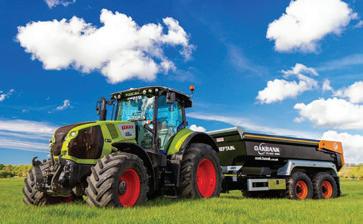
Chieftain’s wide range of Dump trailers include the Chieftain HP20 and SB14. The Chieftain HP20 full Hardox 450 body and half pipe design offer benefits such as increased load capacity due to the material’s high strength-to-weight ratio. The lighter weight of a full Hardox 450 body also contributes to improved fuel efficiency as with the reduced weight, less energy is required to transport the same payload resulting in lower fuel consumption. The Chieftain HP20 is specifically engineered to offer excellent resistance to abrasion which ensures that it remains in optimal condition even when working with abrasive materials, such as rocks, gravel, or construction debris. This helps minimise the need for frequent repairs or replacements. The Chieftain HP20’s curved design promotes efficient material flow which also assists with self-cleaning as
materials tend to flow smoothly and quickly towards the rear of the trailer and slide off the curved surface more easily, reducing the unloading time, enhancing productivity and leaving behind minimal residue.
Chieftain’s SB14 is a dual functionality trailer that allows the operator to transport both materials and small excavators to the job site, eliminating the need for separate trailers for each task. This versatility saves you time, effort, and resources by having a trailer that can handle multiple functions. Ramp storage trays are incorporated into the design which offers space saving benefits and Aluminium ramps can be purchased with the trailer. Whether it’s construction, landscaping, utilities, or other projects requiring material transport and equipment mobilisation, the Chieftain SB14 offers adaptability and convenience for the operator.

TRAILERS www.farmingscotlandmagazine.com 50
MAGAZINE
FARMING SCOTLAND
Next issue out September 2023 Subscription page 122
The new Mitas AGRITERRA 02 SP tyre for trailers
Mitas launches the new radial tire AGRITERRA 02 SP (Soil Protector), designed for modern agricultural trailers to maximize the protection of the farmer’s soil. The tire, launched in the 560/60R22.5 IMP size, is the first in the AGRITERRA range to feature the Very High Flexion (VF) technology.

The tire is designed to provide farmers with decreased pressure on the ground and a larger footprint leading to greater soil protection and therefore increased yields. “Due its flexible and very strong VF sidewall construction, the AGRITERRA 02 SP enables safe operation at lower inflation
pressures. This increases the tire’s footprint by up to 25%, in turn reducing soil pressure by up to 20%. It enhances soil condition thanks to significantly reduced soil compaction,” explains Pavel Kott, Product Manager for Mitas agricultural tires. With its high load capacity and maximum speed of 65 kilometers per hour, the AGRITERRA 02 SP means fewer journeys are needed to transport loads and also enables fast on-road movement, providing significant time savings. The tire is suitable for on- and off-road use and its excellent self-cleaning capabilities reduce road soiling when leaving the field.
Due to the special hexagonal bead wire, the tire is able to operate at lower inflation without limiting its lifespan. Moreover, the AGRITERRA 02 SP tread pattern, with its rounded shoulders, is very
gentle on grassland. All these features deliver clear productivity benefits to farmers using agricultural trailers, spreaders, tankers, and other towing equipment for which the new tire is designed.

TRAILERS www.farmingscotlandmagazine.com 51
Mixed start to the silage season
By Ethan Flett
As the first cut of dairy silage was being finished off last week, the crop seems mixed, though both barley and silage have come on with the recent warmer weather.
However, the recent spell of dry weather hasn’t left Marty Hay of J. & S. Hay looking for rain.


He started this year’s silage two weeks ago, and was due to get into the first cuts for beef farms last weekend.
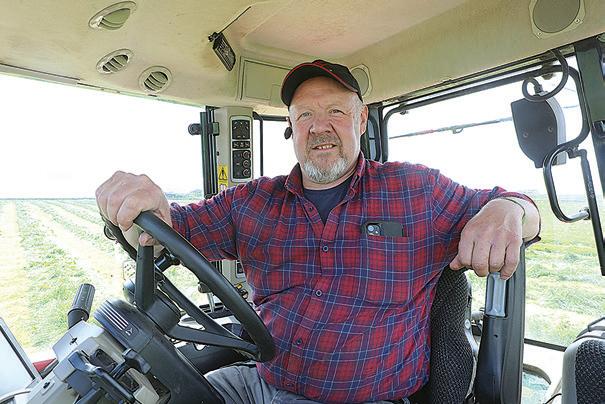
“It’s been mixed,” Mr Hay said, on the quality of the crop so far. “Some of it has been light-ish and some of it’s been not too bad. It had been quite cold and dry throughout May, so things have

got a bit stuck. I think things have jumped this last week again — it’s been a bit warmer.
“A lot of folk are shouting for rain, but I would say it’s warmth we need more so than rain.”
The contractor has also noticed that, among his customers, there’s enough silage left over from last year for them to be cutting earlier than usual, and opting for quality rather than bulk.
“And the weather’s good as well just now, so why not take advantage of a good spell,” he added.
“Barley crops always go through a sticky stage, and you
think ‘oh God, what’s wrong with that.’ Then next you know, it’s away again and everything is looking fine.

“I would say we’re through that, because it was so windy in May — one week in particular was horrendously windy, and there was a lot of salt spray in our area. It affected the grass and the barley, so it’s all recovered after that now. Everything’s coming on and looking good. The countryside is looking quite nice and green just now.”
Compared to last year, Mr Hay said grub was proving to be less of a problem — there’s some
damage in a few fields, but not to the extent that it was last Spring. But the good news doesn’t end there.
“One that’s a major thing for farmers and contractors is that the price of fuel is more sensible than it was this time last year,” Mr Hay said. “And it looks like fertiliser is going the same way. It’s looking better for later this year and into next year. It’s on its way back down as well, so those two things are encouraging.
“And cattle and sheep prices are not too bad. Things are looking a lot better than they were a year so ago, anyway.”
www.farmingscotlandmagazine.com 52
NORTHERN ISLES
News
The amount of animal disease entering Shetland has reached “unprecedented” levels
According to Shetland Island Council’s veterinary adviser



Hilary Burgess warns a combination of factors have contributed to an unwanted spike in diseases which have impacted on the Shetland flock.
A drop in laboratory tests available – and therefore heaping challenges on efforts to make diagnoses – has been counted as a major factor. But an increase in the number of female sheep entering the isles has also caused problems.
Mrs Burgess, of the Shetland Animal Health Scheme (SAHS), says veterinary surgeons are keeping an eye on the worsening rate of infections on the mainland, and are concerned about the potential impact on sheep in the isles.
“The last couple of years have been extremely busy for the Shetland Animal Health Scheme as we have tackled an unprecedented amount of animal disease coming into Shetland,” she said.
The SAHS has already highlighted the unwelcome return of sheep scab, which came back after a 30 year gap.
Test results showed 10 per cent of sheep imported to the isles were infected with the condition.
Dipping equipment was subsequently installed at the marts in Lerwick to prevent any further introductions. Early signs have shown the measure has been effective, with no reports of problems in the 2022/23 season.
But Mrs Burgess has warned other conditions with potentially
fatal consequences are threatening animal health. A key one of those is EAE – Enzootic Abortion of Ewes, which is caused by a highly infectious bacteria called Chlamydophila abortus.
The SRUC says EAE is the most common infectious cause of abortion in sheep in the UK.
Outbreaks of the disease occur in all types of flock and result in serious economic losses.
“In the spring of 2022 we unfortunately had our first Shetland flock to have abortions due to EAE,” said Mrs Burgess.
“Getting an early diagnosis of the causes of abortion in a flock can be really helpful to limit future losses.”
The last year has also seen an increase in the number of imported sheep with the highly infectious viral disease, Maedi Visna (MV).
“This is to be expected, as the prevalence of MV on the mainland has increased in the last few years,” said Mrs Burgess.
“MV has a long incubation period and so even after the infected ram is returned to the vendor – there will need to be a further test of any contacts in six months to screen for any spread of infection.”
Her comments follow a visit this year from sheep lung disease expert Phil Scott, who operates a consultancy business scanning thousands of animals every year for ovine pulmonary adenocarcinoma, or OPA.
OPA is a viral lung disease of sheep which causes tumours, and is becoming increasingly prevalent in mainland flocks.
The SAHS is currently looking for funding which would help provide capacity for OPA scanning in through the Shetland Vet Practice.
Anecdotally, OPA was initially found more frequently in black face flocks.
This breed has now begun to undertake control measures for this disease – but OPA can also be found in mules and sheep of various breeds.
There is neither a vaccine or a cure for the condition.
It spreads more rapidly in housed sheep and it is thought that it can also spread through colostrum.
It can have a long incubation period – up to several years – and affects sheep mainly between two to four years.
A case of OPA was confirmed last year in Shetland following a post mortem of an infected ram.
Affected sheep begin to show clinical signs as the tumours start to grow in the lung and replace normal lung tissue.
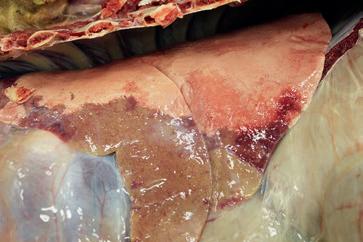
Sheep may lose condition, be slow to drive or have a clear nasal discharge.
Veterinary surgeons say OPA can look very like pneumonia, and it can be common for sheep with OPA to develop secondary bacterial infection.
If sheep affected by OPA are treated with antibiotics, they may improve in the short term.
But vets warn relapse and death are inevitable.
There are no reliable laboratory diagnostics for OPA in the live animal, although it is straightforward to test for at post mortem examination.
www.farmingscotlandmagazine.com 53 www.shetlandtimes.co.uk Tel: 01595 742000 In association with www.orcadian.co.uk Tel: 01856 879000
Pedigree for Peace

Farmer Raises £27,000 for ‘Pick-ups for Peace’ with a Brilliant Borderway Online Sale of Top British Beef Genetics
In a remarkable demonstration of inspired cooperation, Aberdeen Angus breeder Daniel Whiteford has tapped into the generosity of the British beef industry to raise an astonishing total of £27,000 to support fellow farmers in war-torn East Ukraine.
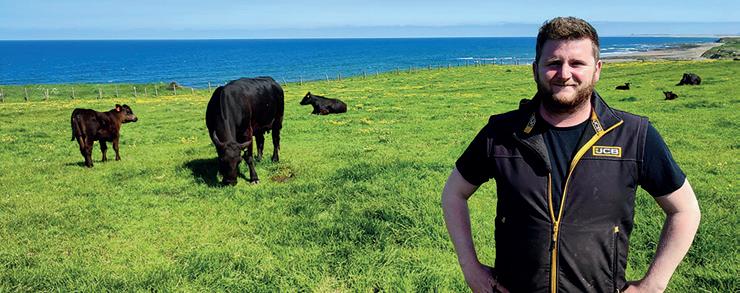
Following his own journey across Europe to deliver a fully loaded pickup earlier in the year, the Berwick upon Tweed based farmer came up with a brilliant initiative to create a unique ‘Pedigrees for Peace’ online sale of top British beef genetics including his own Angus breed. With support from Josh Dowbiggin of Dowbiggin Marketing, donations from around the UK of Angus, Hereford, Limousin and Charolais genetics, gave Harrison & Hetherington a top quality timed online sale of 51 lots that sold out on May 25th and
26th for a total of almost twice the expected target of £15k.
The money will pay for three or possibly four used pick-up trucks and their full complement of supplies, to be delivered to the 24th Lviv Danylo Separate Mechanized Brigade, as part of the Pickups for Peace campaign.
Daniel Whiteford of Borewell Farm can still hardly believe how successful his fundraising venture has been. “When I went out to Ukraine last month to donate my own truck, I saw for myself what the Ukrainian people were facing, and what a difference these pickups are making to the 24th Brigade. So, working with Josh we started asking other beef farmers if they would donate lots for an online sale, and the response and generosity was incredible. So was the response from Harrison &
Hetherington and Mart Eye, who organized and carried out the sale at no charge, and from the buyers who raised this amazing total of over £27k. I can’t thank everybody enough. It’s a brilliant result.”
Scott Donaldson, Managing Director of Harrison & Hetherington, has never organized a sale quite like this and feels truly humbled: “This whole initiative was a wonderful testimony to the UK farming community and their determination to support the Ukrainian people, and it just shows what can be done in two weeks.
Daniel secured some top class lots from the leading beef breeds and buyers from the four corners snapped them up for very generous prices to give us a result far beyond our expectations. Congratulations to Daniel for the idea and the energy to make it happen, and
thank you to every single donor and buyer who made this such an unbelievably successful sale in the best possible cause.”
Pickups for Peace is an initiative aiming to send at least 200 used pickups filled with essential supplies to farmers in Eastern Ukraine. The NFU is hoping to hit the target by the end of the year, and all donations are welcome.
You can support this wonderful cause by donating your old but roadworthy pickup or supplies to fill the trucks, or both. You can also donate funds to pay the costs of transport and return flights for drivers, or volunteer your time to drive a truck yourself.
For more details on what and how to donate visit: https://www. nfuonline.com/media/lurh3oy4/ pick-ups-for-peace-9-mar-23.pdf
www.farmingscotlandmagazine.com 54
ARTICLE
QMS launches InCREDible new summer campaign
This summer, QMS is evolving its ‘Make It with Field Cred’ activity with the launch of its new ‘Make it InCREDible’ campaign.
The new 30-second advert will be live on TV from 1st to 30th June on STV, Borders, STV Player and ITV Player, and is set to reach 82.6%of people in Scotland.
The shift in focus to ‘Make it InCREDible’ enables the campaign to build upon the consumer brand response and awareness developed during the ‘Make It with Field Cred’ activity, allowing the campaign to become more measurable, accountable and effective than previous activity.
While the approach may be different, the campaign will continue to crosspromote the three brands; Scotch Beef, Scotch Lamb and Specially Selected Pork, and focus on the key benefits - being quality assured, locally sourced, farmed with care and fully traceable. The campaign will also highlight the importance of a healthy, sustainable and active outdoor lifestyle.

Furthermore, the campaign messaging will also showcase the high animal welfare standards found on Scotch farms with stress-free life grazing on Scottish hills, as well as highlighting the many health benefits of red meat including that it is a rich source of Vitamin B12 which
beef
Automated weighing technology a gamechanger for
Scottish beef finishing sector
Innovations in technology such as automated weighing platforms have proved a gamechanger for Scotland’s beef finishing sector, improving data collection, driving better management decisions and boosting overall performance.
This is the eighth in a series of case studies, developed as part of the 2023 RHASS Presidential Initiative (PI), exploring the science behind food and drink production, with the spotlight turning to the development and widespread adoption of the Ritchie Beef Monitor.
helps combat tiredness and fatigue.
Lesley Cameron, Marketing & Communications Director at QMS, said: “Our new ‘Make it InCREDible’ activity aims to build upon the successes of our previous campaigns in order to further boost awareness of the Scotch brands.
“While the important message of a healthy and sustainable lifestyle continues to be the same, our summer campaign has evolved to take a more emotive approach to targeting consumers. We want to ensure the campaign is not only more measurable and accountable, but also more effective.”
For more information on Scotch Beef, Scotch Lamb or Specially Selected Pork, visit www.qmscotland.co.uk.
For more information on Scotch Beef, Scotch Lamb or Specially Selected Pork, visit www.qmscotland.co.uk.
The automated weighing crate, complete with fitted water troughs and 3D cameras, was borne out of a multi partner collaboration between David Ritchie (Implements) Ltd, SRUC, Scotbeef, and others (Harbro, Innovent Technology Ltd, Wm Morrison Supermarkets), and allows farmers to monitor live weight and weight gains of individual cattle through compatible ear tags, every time they walk on the unit to access water.
The technology allows farmers to track optimum finishing points for individual animals, which has led to a welcome reduction in penalties for overweight cattle, whilst reducing labour needs, minimising stress for livestock and offering clear health and safety benefits.

The weighing crate was first launched four years ago and deliverers of the weighing crate, David Ritchie (Implements) Ltd, has since been working closely with farmers to further develop the technology, and this
May, launched a new SMS alert system, which notifies farmers if certain cattle aren’t performing as expected, as well as when animals are ready for market.
Technology pioneers, AgriEPI Centre, were an early adopter of the system, working with several farmers to trial the platform on the ground. CEO Dave Ross explained how the development and adoption of new technologies like Ritchie Beef Monitor are critical to improving data collection and efficiency in Scotland’s beef herds:
“Science and innovation are the engine of improvement in agricultural output and have demonstratively been that engine throughout history. There are high levels of variance between the performance of the top and bottom 10% of farmers and what is missing, is the data to inform on management decisions and to optimise performance. These technologies eliminate the guesswork, improve data collection accuracy, reduce labour pressures and enhance animal welfare on farm,” said Mr Ross.
www.farmingscotlandmagazine.com 55
NFU Scotland Poultry Working Group urges poultry industry to get behind Ukraine Pick-ups initiative
After its recent meeting, NFU Scotland’s Poultry Working Group is urging the poultry sector to get behind the Pickups For Peace initiative, where farmers and the farming industry have been supporting the war effort in Ukraine.
The working group were inspired by recent press articles highlighting the generous donations and delivery of more than 100 pick-ups and 4wd vehicles, along with important equipment and medical supplies, to those fighting on the frontline in Ukraine.

Poultry Working Group member Matthew Steel, from Craignathro Farms in Angus, and a free range egg producer has made two deliveries to Ukraine, inspiring the group and its chair Robert Thompson to urge the poultry sector to get behind and support Pick-ups For Peace.
Mr Thompson said: “Our industry has and will have more difficult times, but we also have our good times as well. But the plight faced by Ukraine and its people puts everything into perspective.
“At our working group meeting last week Matthew gave an invaluable insight into the strife in Ukraine and how he personally has supported the initiative to get vehicles and equipment to the frontline. That led to the whole working group agreeing to raise awareness and collectively urging the whole poultry sector to help where they can.
“The need for 4wd vehicles is great but tools, spare parts and motoring accessories are also needed. I ask those within the poultry industry to think what you can do. Even a small donation to the initiative’s JustGiving page would help make a difference.”
livestock www.farmingscotlandmagazine.com 56
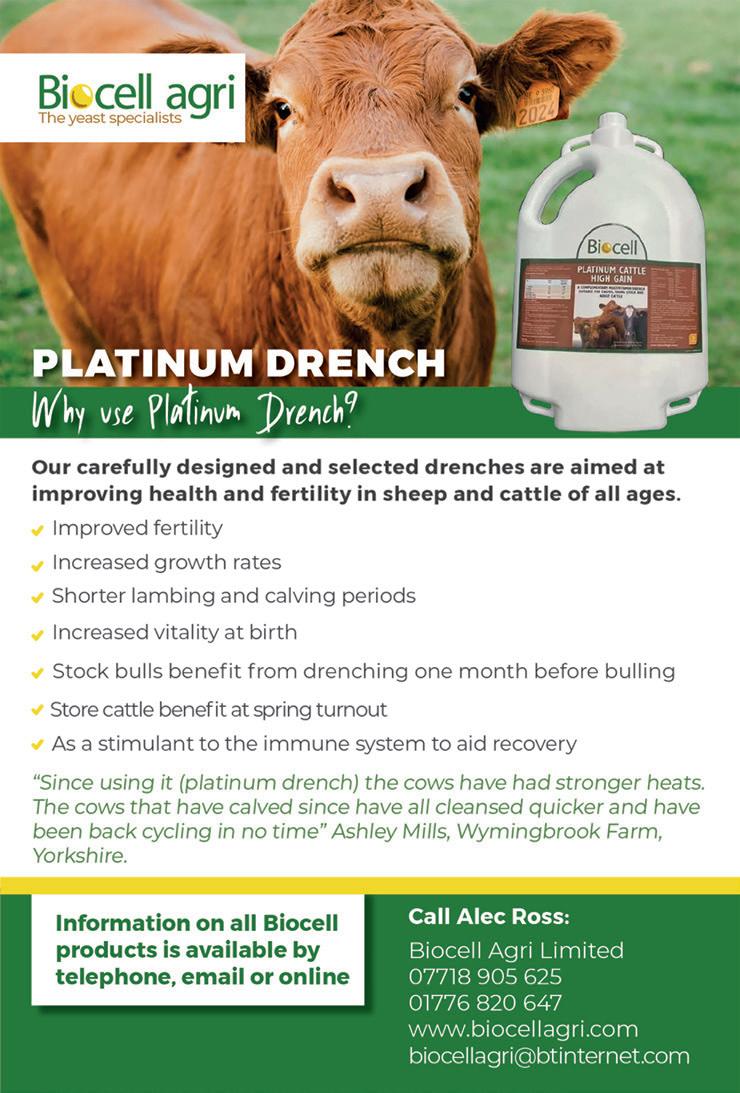
New survey to record livestock ear tag experiences
A project investigating the factors impacting on ear tag loss and retention in cattle and sheep in Scotland has launched an online survey to build on information gathered in stakeholder interviews.
Ear tags are a fundamental part of livestock traceability and while timely replacement of lost and damaged tags is vital in maintaining the integrity of these systems, it can come at a cost to farmers and may have impacts on animal welfare.

The structure of Scottish livestock farming – with many independent small-holdings, crofts and farms operating in diverse settings – can make it difficult to identify trends behind lost and damaged ear tags.
By collecting data from livestock keepers about their practical experience, researchers from Scotland’s Rural College (SRUC) aim to develop a better understanding of the various factors, and their interactions,
contributing to ear tag losses.
Following earlier consultations, researchers found that ear tag loss and retention are linked to the way tags are applied, the environment they are exposed to and the performance of the tags themselves.
Team leader Dr Sam Beechener said: “Support with this project so far has been very encouraging. We’ve come to understand that lost, damaged and unreadable tags are a function of initial application, the external environment and tag performance – a so-called ‘ear tagging triangle.’
“We’re keen to explore these interactions in the next stage of the project by collecting data from a broad cross section of livestock keepers across Scotland through a new survey.”
The interactive form, which has been designed so participants only see those questions relevant to the stock they keep, should take no longer than 10-15 minutes
to complete with all responses treated in confidence. Results will be shared to encourage and inform discussion on a topic that is expected to be of interest to many of Scotland’s livestock keepers.
The project is funded by the Scottish Government with a view to establishing how ear tag losses are impacting on livestock keepers, what the causes are, and how they might be addressed.
Scots livestock production needs ‘moon shot’ approach
Scotland should adopt a ‘moon shot’ approach to innovation in livestock production to make the most of huge potential rewards in sustainability and growth for the rural economy.
Professor Wayne Powell says Scotland is in a uniquely strong position to use targeted innovation informed by strong collaboration between academia, businesses, government and communities to shape a high
value food production sector that is “environmentally sustainable for landscapes, rewarding for farmers, beneficial for consumers and supportive of national and international commitments to reduce greenhouse gas emissions”.
In his latest blog post, the Principal and Chief Executive of Scotland’s Rural College (SRUC) says the development and refinement of animal feed supplements, investment in selective breeding programmes and better use of technology to capture livestock emissions, such as SRUC’s GreenShed project, all have a vital role to play.
He writes: “We have the means to achieve low or even
zero-carbon meat at considerable scale and in ways that put Scotland in pole position to develop a new and exceptionally valuable market in the food supply chain. As we do so there will inevitably be trade-offs that need careful management, including higher input costs for farmers and fewer animals overall in the food supply chain.
“Yet we need to be canny enough to appreciate that food produced to exacting environmental standards can be sold to consumers at a significant premium as compared with animals with lower welfare standards. New systems of sustainable farm monitoring accreditation will be needed. In
practice farmers should be able to achieve the same or better returns from smaller herds, freeing up land for biodiversity or other forms of food production alongside low intensity animal husbandry.”
Professor Powell adds: “The challenge is for the academic community to redouble our efforts to work with and support businesses, policy makers and communities across Scotland to seize the opportunity in a concerted manner. Together we can adopt a ‘moon shot’ approach to rapidly developing and refining livestock production that reaps huge environmental and economic rewards for Scotland in the years ahead.”
livestock www.farmingscotlandmagazine.com 58
FARMING SCOTLAND MAGAZINE Next issue out September 2023
BVA President calls on Scottish politicians to deliver funding for veterinary education in Scotland

In a speech at the Scottish Parliament recently British Veterinary Association (BVA) President Malcolm Morley warned that the future of veterinary education in Scotland ‘sits on a precipice’ and called for adequate long-term funding to secure sustainable provision of inclusive veterinary education and, with it, the future of the country’s agrifood economy.
Addressing more than 80 guests at BVA’s Annual Scottish Dinner, Dr Morley highlighted that Scotland had long been at the forefront of veterinary education but that the impressive work of
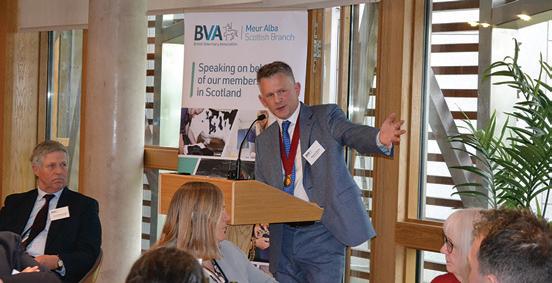
livestock www.farmingscotlandmagazine.com 59
its vet schools, including the new development of SRUC’s school of veterinary medicine, needed crucial Government support to remain sustainable and to plug veterinary workforce challenges, especially in Scotland’s rural and remote areas.
Dr Morley said: “Scotland has long been at the forefront of veterinary education and is home to two of the oldest veterinary schools in the UK. The exciting development of SRUC’s School of Veterinary Medicine is timely, offering a new model and aiming to increase access to the profession and encourage graduates to stay in rural areas once qualified — complementing the impressive work already underway in Scotland’s existing vet schools.
“However, more than ever, it’s crucial that the Scottish Funding Council provides the necessary financial support. The reality is that current funding per Scottish vet student doesn’t
meet the cost of providing this education — and while the vet schools have been increasingly resourceful in implementing innovative models, the future of veterinary education in Scotland sits on a precipice if sustainable long-term funding is not assured.”
Addressing guests including George Burgess, the Scottish Government’s Director of Agriculture and Rural Economy, MSPs, and key representatives from animal health and welfare organisations and colleagues from across the veterinary profession, Dr Morley also underlined the importance of investing in the people and infrastructure of crucial public sector veterinary services.
He said that central to this was the recognition that investing in people was not just about investing in vets, but other members of the vet-led team, such as vet techs, musculoskeletal professionals and equine dental
technicians. Dr Morley called for Scottish Government to join BVA in lobbying Defra for urgent legislative reform of the “outdated” Veterinary Surgeons Act, which “doesn’t recognise these important roles or enable us to embrace the full potential of the wider veterinary team”. He also welcomed potential plans for a Scottish Veterinary Service and recognised the work of the Highlands and Islands Veterinary Services Scheme (HIVSS), and its coordinator Freda Scott-Park, in supporting veterinary provision to remote crofting communities.
Speaking about agricultural transition in Scotland, Dr Morley underlined that veterinary engagement will be key to its successful development and that it must support animal health and welfare and sustainability. He said: “The new agricultural policy offers the opportunity to harness the unique and trusted relationship which exists between
vets and farmers, empowering collaboration to drive positive outcomes on all levels. Central to this is developing sustainable agricultural practices that minimise environmental impact and prioritise animal health and welfare. To enable this, we must ensure there is veterinary engagement and representation on key bodies such as the Agriculture Reform Implementation Oversight Board, AREOB, and safeguard animal health and welfare as a central component of agricultural transition — alongside our custodianship of the land.”
Next issue out September 2023
Subscription page 122


livestock www.farmingscotlandmagazine.com 60
FARMING SCOTLAND MAGAZINE
Study seeks UK farmers’ feedback on impacts of bovine tuberculosis
New research by national charity
The Farming Community Network (FCN) seeks to better understand the impact of bovine tuberculosis (bTB) on UK farmers’ health and wellbeing.The study is exploring the emotional, financial and physical impacts of bTB and the long-term ramifications these may have had on the farmer, farm family or farm business.
The researchers are also hoping to hear about farmers’ experiences of government policies to control and eradicate bTB.
As part of the research FCN is running a survey that will help the charity to better understand how farmers and farm families perceive the threat of bTB – helping to improve its support to those at risk or affected by a bTB breakdown.
• The survey, which is open for responses until mid-August, is available here: https:// www.surveymonkey.co.uk/
r/3HG5YFG
It should take no more than 10 minutes to complete.
Farmers who have experienced a bTB breakdown are being encouraged to fill the survey in and to share their experiences.


The charity is also inviting those who fill in the survey to take part in an optional longerform interview from September onwards.
Dr Jude McCann, Chief Executive Officer, The Farming Community Network, said: “We know all too well the devastating impact bTB can have on farms in the UK. The anxiety associated with bTB testing, and the unfortunate outcome when a bTB breakdown does occur, can cause irreversible damage to a farm business and can significantly impact the health and wellbeing of farming families.
“We hope this study will help to shed light on this issue, provide farmers with the opportunity to share their own experiences with bTB, and help FCN and the agencies we work with to better support farmers affected.”
Linda Jones, FCN Cymru National Manager, said: “I would urge cattle farmers in Wales to complete this short survey in order for us to fully understand and assess not just the impact of a bTB breakdown, but in addition, how the stress and worry associated with an upcoming bTB test affects farming families.”
North Wales farmer and FCN Ambassador Will Evans said: “This is an important study that will help our industry to better understand the impact of bTB on farmers’ health and wellbeing. The threat of bTB is endemic in parts of the UK – the findings of this study will help FCN and the wider industry in enhancing our understanding of the impacts of this awful disease and developing targeted support.”
The study follows a report in 2009 conducted by FCN (Stress and Loss – a report on the impact of Bovine TB on farming families). This included interviews with 68 livestock farmers in the bTB hotspot areas of South West England, and eastern Wales.
The findings highlighted the serious and widespread impact of bTB on farmers and demonstrated that this impact commonly extended across all family members as evidenced in their psychological and physical health, as well as in their overall financial and social wellbeing.
FCN welcomes any assistance in circulating this survey to farming groups and connections you may have.
Reviewing your livestock farming costs
The top 25% of Scottish Beef and Sheep Less Favoured Area (LFA) farms have 67% greater costs than the average yet return 116% greater revenue. This is a finding from the Scottish Farm Business Survey (2021-22) data and illustrates how above-average costs can be justified to achieve greater output with good management decisions. This means that, in times of increasing variable costs, we must be shrewd about which costs to cut to avoid disproportionately reducing output.
Feed and fertiliser are key cost-cutting opportunities. While these can be invaluable during extreme weather, it’s important to avoid becoming too reliant. Consider options to reduce dependence on these inputs that are compatible with the farm characteristics.
In some cases, investments will save money – this is most true for grass
production, check soil fertility and structure to improve nutrient uptake and enable greater meat production from grass. Improved grazing management is also a great opportunity to increase the utilisation of grass and save on feed and fertiliser requirements.
The nature of livestock farming is changing; where in the past, high-input businesses could justify their high costs as they were, in some cases, better placed to reap the benefit of the greater product price, the recent increase in costs has clouded the picture. Although revenue is influenced by external forces as well as production, focusing on selling a sustainable amount of meat while keeping costs in check can give businesses a real edge.
Read the full article here: www.fas.scot/article/ reviewing-your-livestockfarming-costs/
livestock www.farmingscotlandmagazine.com 61
Bolster low quality forage with home grown concentrates
What does sustainable farming mean to you?
By Madeleine Brady Northvet Veterinary Group


Producers are being encouraged to consider home grown concentrates, such as crimp, to bolster rations where silage analysis indicates low energy forage.
Lientjie Colahan, from Lallemand’s technical support team, says that the timing of the wet weather this year resulted in some farms taking first cut later than originally planned, which could result in a lower energy forage. For these farms, crimp could prove a good home-grown energy alternative.

“Crimped grain can help balance the energetic value of the ration, without increasing the proportion of purchased feed required,” says Mrs Colahan.
“The straw left behind after combining can also be baled and used for feed. Because the crop is harvested earlier than dry grains, the digestibility value of the straw is marginally increased,” she adds.
Mrs Colahan explains that when it comes to handling crimped grain, the way it is treated and ensiled has a big
impact on its nutrient retention and quality at feed out, so this must be considered.
As crimp offers a rumenfriendly source of starch, Mrs Colahan says it is a very safe way to lift the energy content of rations and is a particularly good option in situations where silage falls short.
“Some farmers may have made high bulk but lower energy silage,” she says.
“If first-cut grass silage analysis is lower in ME than expected, crimped cereals should be considered as a cost-effective way to make up the shortfall in rations.
“Crops that are suitable for crimping include maize, barley, wheat, oats, and triticale. Grains should be harvested at a moisture content of between 25 and 40 percent – typically two to three weeks earlier than conventionally combining,” she adds.
Due to the high moisture, all crimped cereals will need to be treated with an appropriate inoculant to reduce spoilage and nutrient loss.
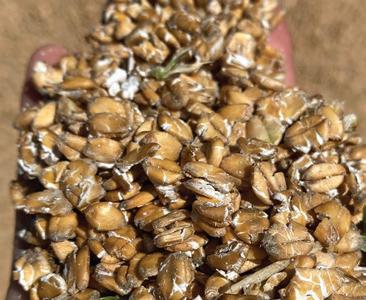
I recently attended a discussion group on Sustainable Livestock Production. Our initial question “What is Sustainable Livestock Production?” proved it can be difficult to define. Ask a roomful of people and you will get a variety of answers.
Often it is broadly defined as farming that meets the needs of the present without compromising the future. On a more individual level perhaps it is the ability of your farm to carry on an economically viable and ethical business that can continue for generations to come? Is it about maximising productivity whilst minimising the impact on the land? Providing high quality food products whilst ensuring the natural environment is not ignored?
Any livestock farmer knows that animal health and welfare is one of the main priorities of a livestock business. Healthy animals require less inputs, have better welfare and are more efficient. The Scottish government recognises this
and through Preparing for Sustainable Farming provides incentives to farmers to increase efficiencies through animal health and welfare interventions.
Farmers can claim a maximum of £1250 over two years for various different interventions. It may be as simple as testing for worms and implementing a prevention and control plan in conjunction with your vet or arranging an annual pre-breeding exam for your stock bulls. Certainly many Scottish farms will already be routinely performing several interventions on the list. The complete list can be found on the Rural Payments and Services website.
We finally have some better weather in Orkney and with grass growing rapidly I look across green fields of healthy cattle and sheep and wonder – all the sustainability buzzwords aside, if it’s about happy, healthy livestock then isn’t that what we have been striving for all along?
livestock www.farmingscotlandmagazine.com 62 The
VET
Breakthrough approach for detecting mastitis in dairy cows
The developers behind the smaXtec advanced health system have identified a new early standard for mastitis detection – Level Zero –which will enhance the welfare of dairy cows and reduce economic losses of the disease for farmers.
This scientific advancement is a major step in proactively tackling one of the costliest diseases impacting the dairy sector. Industry reports estimate that the loss of milk production, associated veterinary costs and premature culling costs £334[1] per case of mastitis.
This new early diagnostic standard has identified a specific temperature pattern that indicates the early onset of mastitis through in-depth analysis of data collected through smaXtec’s continuous monitoring. This sets a new Level Zero standard for the detection and proactive prevention of the disease.
Based on the highly accurate measurements of inner body temperature generated by its health monitoring boluses, smaXtec has identified three rapid temperature
increases over a short period as the trigger for mastitis.
The Level Zero classification, the lowest in severity, is described as inflammation already being present but with a normalappearing mammary gland and visibly normal milk.
Data also shows that a cow’s inner body temperature increases up to four days before clinical symptoms of mastitis become visible[2].
Until now, it’s been considered good practice to detect and treat mastitis from Level One. But, if you can identify mastitis at Level Zero before the somatic cell count (SCC) reaches pathological levels, it gives producers the ability to administer a preventative treatment.
“By detecting mastitis at Level Zero using our award-winning technology, dairy farmers will experience routinely healthier cows, consistently higher milk yields, less antibiotic usage and, ultimately, less dumped milk –saving both time and money. It’s
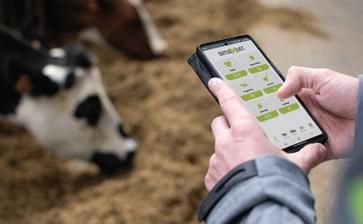
win win,” says the company’s global sales director, Chris Howarth.
smaXtec customers typically report a 55% reduction in antibiotic usage for mastitis cases in the first few months of using the bolus technology, with longerterm customers reporting antibiotic reduction by up to 70%. This is encouraging data for an industry focused on reducing antibiotic usage.
Managing a herd of 650 cows, Cornish farmer, Bill
Jewell introduced the health system in 2021 and says that mastitis outcomes have improved significantly.
“Since installing smaXtex, I honestly can’t say that we’ve had any prequartered cows from having mastitis. There has not been a case that we’ve missed,” he says.
The new level of detection for mastitis is just one example of smaXtec’s ongoing efforts to develop innovative solutions that improve the health and productivity of dairy herds worldwide.
New welfare strategy launched by the UK dairy industry
Dairy farmers, vets and industry professionals right across the whole supply chain have collaborated through Ruminant Health & Welfare (RH&W) to create the new UK Dairy Cattle Welfare Strategy for 2023-2028.
The strategy, which has now been launched is designed to help the industry show progress in animal welfare by 2028.
RH&W vice-chairman, Gwyn Jones, says the strategy is an update of a previous strategy aimed at improving the welfare of the national dairy herd, but
importantly, has support right across our four nations.
“The industry’s shared vision is for the UK dairy industry to demonstrate evidence-based progress in six key areas of cattle welfare by 2028,” adds Mr Jones.
“Ability to provide evidence of progress will assist in maintaining UK status as a global leader in dairy cattle welfare; helping us compete with our international players.”
The six strategic goals in the strategy are:
• Thriving cows – ensuring all dairy animals are bred, reared and cared for to thrive in all systems
• Healthy feet – ensuring a proactive lameness management plan is in place on every UK dairy farm
• Comfortable cows – maximising cow comfort in housing and at pasture
• Appropriately nourished cows –ensuring a healthy body condition throughout the year

• Healthy udders – continued improvements to udder health to reduce cases of mastitis
• Positive welfare – moving towards ‘positive welfare’ by providing an environment that allows animals to exhibit normal behaviours such as curiosity or play
Mr Jones says RH&W will support the industry to make progress in these six key areas
dairy
www.farmingscotlandmagazine.com 63
as research has shown the public expects the delivery of good welfare as well as good health, and we must continue to set the bar high for our industry standards.
“The UK must ensure standards deliver excellent welfare, providing a solid platform for UK supply chains to build on in the future,” adds Mr Jones.
“To enable the UK dairy industry to compete internationally, the sector will need to be able to provide evidence of progress on welfare. By doing so across the four nations, the UK will be positively differentiated from other countries.”
RH&W steering group member and senior animal health and welfare scientist at AHDB, Dr Jenny Gibbons, says AHDB has committed to helping the industry publish an annual progress report. The report will capture data evidencing the outcomes achieved by the strategy’s stakeholders, showing the actions taken annually to achieve the six welfare goals.
Dr Gibbons says: “These actions will be reported by groups of key industry stakeholders working together to gather evidence of industry achievements and progress on the six goals.”
In developing the strategy, the key stakeholder groups have been identified and split into the following categories: farm assurance; farmers; government; processing supply chains, including markets and hauliers; retail supply chains; research organisations; commercial organisations and veterinary surgeons.
Mr Jones and Dr Gibbons say that now the strategy has been launched, we must work together across the wider UK dairy supply chain to deliver the strategy.
Mr Jones says: “The wider industry from government officials and assurance scheme providers to dairy farmers and processors, must wherever possible work together to support progress on the strategy and support a centralised data collection to demonstrate industry progress.”
The dairy welfare strategy is part of a wider body of work at RH&W to facilitate and create welfare strategies for the whole UK ruminant sector – sheep and beef cattle ones will follow in due course.
Can “Farm to Fork” deliver?
Food chains are creaking and unless the Prime Minister’s ‘Farm to Fork’ summit delivers on its commitment to fairness across the supply chain then the empty shelves seen in some supermarkets will become a permanent feature writes NFU Scotland’s Milk Policy Manager Tracey Roan.


Tracey writes: “In my own sector, milk prices paid to farmers have been plummeting at the same time as input costs are still remaining historically high, not just in Scotland but across the UK .
“We need hammer home that food prices cannot afford to come back at the producer’s expense - farmers live in the same world as everyone else and are also facing a cost of living crisis as well as meeting Government targets to get to
By Tracey Roan
Net Zero. As a sector we are happy to produce quality, high welfare food and reduce our carbon footprint but not for free!
“With the current rapid decline in milk price coupled with the strong beef and cull cow price, it won’t incentivise farmers to try and increase milk output, and any unfavourable weather events will likely reduce output further. Some parts of Scotland are already recording low river levels and dry ground conditions, with SEPA warning us of water scarcity this summer.
“The average milk price paid to farmers is predicted to fall significantly. I’m hearing lows of 33p per litre but cost of production is estimated to be at 43.5p!
“It is disappointing that supermarkets have opted to
reduce the price of milk when the biggest price increases seen on shop shelves were on imported food items. There are often more highly processed and unsustainably produced than British milk and dairy produce.
“Retailers may claim that those supplying them with fresh milk won’t be affected by price cuts on the shop shelf, but it highlights the lack of fairness in the supply chain and the ability of retailers to target the weakest part of the chain first.
“It adds urgency to our long running campaign to secure statutory contracts for the dairy sector to deliver fairness and transparency, with further revisions of a statutory instrument to deliver this being presented to both Houses at Westminster in June before becoming law.”
www.nfus.org.uk
dairy 65 www.farmingscotlandmagazine.com 64
NFU Scotland
sheep
The sheep of things to come
First UK outing for portable chambers to measure methane
High-tech portable chambers for measuring methane emissions from sheep are being used in the UK for the first time.
Scientists at Scotland’s Rural College (SRUC) have unveiled their New Zealanddesigned Portable Accumulation Chambers (PACs) as the latest tool in mitigating agricultural greenhouse gases.
The trailer-mounted chambers can predict methane emissions in individual sheep from a variety of systems, including at pasture, as well as in multiple locations.

Scientists can collect air samples and then analyse methane concentration, showing which genetics, feed types and systems generate the highest emission levels.
In a recent blog post, Professor Wayne Powell, Principal and Chief Executive of SRUC, called for increased efforts to reduce the climate impact of ruminant livestock.
Dr Nicola Lambe from SRUC, who is leading the PACs
project, said: “There is an urgent need to mitigate greenhouse gas emissions from sheep. Recent figures show there are more than 1.2 billion sheep in the world, producing around 7 million tonnes of methane into the atmosphere.
“Despite the fact resource efficiency and greenhouse gas emissions are global priorities, there are few examples around the world of research to implement breeding strategies to directly tackle these issues in sheep.
“This is largely due to the difficulty in recording feed consumption and greenhouse gas emissions on an individual animal basis, especially in grassbased systems. The Portable Accumulation Chambers will play an important role in starting to address this issue.”
Working with Agri-EPI Centre, Rob Hodgkins, who has 2,500 sheep on his farm in Hertfordshire, has become the first farmer in the UK to use the
Blenheim Estate transforms sheep farming practices
As part of its ongoing sustainability and animal wellbeing strategy, The Blenheim Estate is introducing mob grazing, a more sustainable way to manage its 1,000 strong flock of Scotch Mule and Cheviot sheep.
The practice emulates how animals flock and feed in the wild, grazing down the sward equally, and means they eat the most nutritious top third of the plants and trample the less nutritious stalks onto the ground, helping to enrich the soil quality.
This new practice will see mobile electric fencing replace the 2,000-acre estate wooden fencing via a partnership with Rappa Fencing. The new fencing system allows sheep to move to specific new grazing areas quicker and more easily.
A major upgrade of its sheep farming facilities, the transformation forms part of the Estate’s ambitious land strategy that looks at innovative ways to move towards more sustainable farming practices. It is one
PACs, following a grant from Innovate UK.
He said: “Not only does this make sense from an environmental point of view, but it also makes sense economically. It will only be a matter of time before consumers will be able to
look at labels on packets of meat that shows what they’re buying has come from, for example, a carbon-zero sheep.”
Sheep farmers hoping to find out more about the PACs can contact nicola.lambe@sruc. ac.uk

www.farmingscotlandmagazine.com 65
of a range of measures being introduced to support its ambition to deliver carbon negative land management within 10 years.
Already, the Estate’s sheep lamb later than many farms because they are reared entirely on grass within the Parkland, keeping them as naturally healthy as possible. Blenheim Estate allows its sheep to give birth outdoors, in order to give the lambs the best spring grass and nutrients they need, making it vitally important that they remain safe and protected from interference from dogs. With Blenheim’s lambing season underway after Easter, there are renewed calls to help protect the lambs, with Blenheim urging walkers to keep their dogs on leads as part of its annual Thank Ewe campaign.
The Blenheim Estate has also introduced Pedigree Hampshire Down rams in September 2022, as it looks to diversify its livestock using native breeds that support its commitment to organic produce.
As the landscape opens up to more sustainable and traditional farming practices, shepherds on the Oxfordshire estate will use an all-terrain vehicle (ATV) equipped with an auto fencing machine from Hampshire-based Rappa to establish terrain for mob grazing, which involves the sheep being regularly moved to different areas of the park.
“We took the decision to do away with all the old permanent fencing and instead use a mobile system which allows us to be much more flexible,” said Blenheim Estate Shepherd Tom Locke.
“Due to the number of sheep we have here and the fact that electric fencing will enable us to move to more sustainable practices, we needed to invest in equipment to help speed up work on the fencing, the most labour intensive aspect of mob grazing.
“The Rappa ATV Winder has made picking up and putting
down fences twice as quick as before as everything is so user friendly and close to hand while you are doing the job. The kit is very robust, British made and a cost-effective way of giving our shepherds more time to focus on looking after the sheep. It ticked all the boxes for me and the work I would be using it for.”
Nick Cockayne from Rappa said: “Our system is tried and tested by sheep farmers around the UK and has proved its worth as a reliable and efficient way of keeping sheep safely
grazing in different areas of land. It is designed to cope with a wide variety of terrains to offer maximum flexibility, and working with the Blenheim Estate team, we were able to supply equipment that will meet their exacting requirements and help them adapt to their new farming practices with ease.”
Rappa has led the world in mechanised electric fencing for 40 years, developing its original fencing machine into a complete range for everyone from smallholders to large multiacre farms.

Yeast fermentation additive reduces lamb finishing times, resulting in an additional £18.91 per head profit
Data collected in a 2022 farm trial found that lambs supplemented with Celmanax, a yeast fermentation additive, from weaning to slaughter resulted in a £18.91 per head advantage compared to lambs not provided additional supplementation when cost of feed was taken into consideration.
According to Dr Alison Bond, nutritionist for Rumenco and UK distributor of Celmanax,
the biggest contributor to the increase in profit was a significant increase in daily liveweight gains resulting in faster finishing times. Of the lambs supplemented with Celmanax, 50% were finished by the end of June and an additional 35% were finished by the trial end. Only 8% of unsupplemented lambs were finished in June, with an additional 17% finished by the
end of the trial, resulting in 75% of the control group remaining unfinished at the end of the trial.
“The nutritional benefits from Celmanax allowed lambs to achieve an average daily gain of 530g in the first four weeks of the trial, a 150g advantage over the control group that had an average daily gain of 380g,” explains Dr Bond.
Beginning on May 15 and ending on July 25, over
650 10-week-old lambs on a commercial sheep farm in Wales were split into supplemented and control groups. Lambs had negative worm counts, were managed on paddocks with a sward height of 9cm (2,500 kg DM/ha) and had free access to a Rumenco mineral bucket.
Each group was supplemented with creep feed, allocated 1kg/h/day. The control
www.farmingscotlandmagazine.com 66
sheep
group was fed standard creep feed and the treatment group received creep feed containing Celmanax to provide 0.5g/h/d.
“Celmanax is a yeast fermentation additive that has been shown to improve ruminant performance by supporting a stable rumen environment. A range of compounds within this product supports the maintenance of a stable rumen microbiome, therefore improving digestibility and feed efficiency,” explains Dr Bond.
Financial and environmental advantages of yeast fermentation products for sheep farmers
According to Dr Bond, the financial return of feeding Celmanax was achieved through a combination of fewer days on farm and the lambs earning a higher price by hitting the market early.
“If you look back through market trends, lamb price will be strong throughout June and then start to decline as you get into July and August. This is because the majority of lambs are finishing in the July-August period, flooding the market and driving down prices,” she says.
In June 2022, the average deadweight lamb price was 671.73 p/kg, dropping to 636.35 p/kg in July and even further to 544.90 p/ kg in August.
Fewer days on farm, also equate to fewer resources like water, grass and labour being required, adds Dr Bond, which was not taken into the financial calculations on this trial. However, using industry data, Rumenco estimates that Celmanax supplementation reduced enteric methane emissions throughout the trial period by 18.7% compared to the control group.
Yeast fermentation feeding options
Sheep farmers wanting to take advantage of the rumen support and average daily gain benefits of Celmanax have a couple of feeding options, says Dr Bond.
The first is to feed it in a creep compound like the trial farm. The recommended feeding rate is 0.5g/h/day to be fed from weaning through to finish.
The second option is to supplement lambs from
weaning through to finish with a multipurpose product like Rumevite Quality Lamb, which replaces concentrates. Good frame growth and weight gain are achieved through the block’s 18 percent all-natural protein content and 13 ME. Lambs also benefit from the formulation which includes essential trace elements, vitamins and minerals. This
includes vitamin B1, selenium, cobalt and protected zinc. The combination of nutrients in Rumevite Quality Lamb provides huge performance benefits. In a 2018 trial, lambs supplemented with Rumevite Quality Lamb had an average daily liveweight gain over double that of the control group and were finished 81 days quicker, with a 390g heavier finishing weight.
Regardless of the method of supplementation, a yeast fermentation product like Celmanax will provide sheep producers with the benefit of getting lambs off farm faster.

“Being able to maximise homegrown forages will be the most cost-effective way to get lambs to finishing and off the farm earlier,” concludes Dr Bond.
Tup sales success
2022 saw a tremendous show of quality stock at Kelso. 4429 Rams from 17 breeds were sold in 15 rings over a frantic day of bidding.
It was a day of wind and rain which did nothing to dampen the spirits of those present more saddened by the recent death of Her Majesty Queen Elizabeth 11.The Society broke with tradition and rang two bells. One for 2 minutes silence which was respected solemnly across the showground and another for that start of the sale.
Sponsored by our long term partners Norbrook the event was busy with trade from auctioneers and engineers alike. It is full recognised as the place to be for all parts of the sheep industry and a bell weather for its state of health.
Our top sales price of £65,000 in 2021 was not quite achieved but a tremendous £52, 000 was paid for lot 2 in ring 9 where a Texel shearling consigned by Messers Wright and Sons, Midlock was purchased by Elmscleugh and Craig Douglas. This, one of 9 shearlings in 5 figures for the day.
Lamb prices were equally keen with the top price of £3800 going to Mr W J Knox of Mid Haddo for their Texel purchased by Davy & Co Canllfaes. Another presented by Mrs Goldie of Harpercroft was a close second for top price in the lamb section at £3600 off to Shetland with B Nicolson.
The Society is gearing up for the next sale on the Friday 8th September 2023 when the canvas marquees will return as
well as potentially more than 5000 quality rams from around the country and possibly from across the water.
Interest is already growing and the town’s reputation for holding the finest sale of rams in the world is set to continue, with 15 rings in full flow for the day it remains a unique part of the calendar for all.
Border Union Society Chairman Peter Douglas of Ruletownhead said;
‘ Kelso Ram Sales provide the single most effective one stop shop for purchasing quality stock of many different breeds. The sale is rightly renowned across the world for premium rams and generates considerable revenue for the community and commercial business in the Scottish Borders. We look
www.farmingscotlandmagazine.com 67 sheep
forward to another fantastic day continuing the tradition and enjoying the excitement of the Kelso Ram Sales in full flow.’
Potential for sales to Northern Ireland still exist but the long layover of 60 days ahead of landing remains a challenge, particularly with the proximity of them needing to work shortly after the sale. Consignments coming across to sell remain low but there has been interest for 2023 and we remain hopeful to see a return to the former brisk trade in both directions.
It is a testament to the event that we see sellers and buyers from across the UK including the Islands and South West of England where interest remains strong.
The sale is promoted and supported by expert and knowledgeable Auctioneers including: Border Livestock Exchange Ltd, C&D Auction Marts, Harrison and

Hetherington, Hexham and Northern Marts, Lawrie & Symington, North eastern Livestock exchange and United Auctions. This year their consignees will have until 1st August to make their entries with the famous Kelso Ram Ballot where Tups are allocated their position in the sales to be held on the 10th August at Springwood Park Showground where the sale will commence sharp at 10am on the sound of the bell on the 8th September.
Over the years breeds have come and gone responding to the demands for meat, stock getting or wool quality and with practices always on the change it will be interesting to watch how the trends continue to favour one breed over another of geographical preference for those on show. It remains critical that the best of the best will be presented in the rings and as they always say:
‘You’ll always get one extra bid at Kelso’
There is much to look forward to with the sales now attracting a great many visitors to the region and delivering commercial benefits which go right through the rural economy with accommodation, catering and retail sales included. To buy and sell at Kelso Ram Sales is an exciting and rewarding exercise and we keep a positive outlook for the industry and its fortunes this year.
Lynx Reintroduction – Is this the time?
In late May the potential for reintroducing lynx was debated in the Scottish Parliament, after a parliamentary motion by the SNP’s Kenneth Gibson received cross-party support to engage this discussion. The motion highlighted the moral and ecological case for the species’ return, and how lynx reintroduction could make Scotland’s natural world ‘richer and stronger’ via a managed reintroduction, following appropriate assessments. NSA Scotland advocate for the diverse tapestry of habitats and biodiversity across farmland. Protecting these habitats that exist, the species that are at risk right now and the people managing them should be the priorities for government. However, NSA members across Britain and notably Scotland have been at the sharp end of species reintroductions, from poor consultation processes, illegal releases, no management strategies and no mitigation, exit or recognition of the impacts to farming businesses and livelihoods. NSA as a whole believe it is absolutely imperative that there is a clear

plan in place for responsibility of the reintroduced species, especially when it comes to maintaining our sheep industry, the natural environment, possible increased footfall and subsequent consequences – traffic, litter, fencing, pathways, gates, damage to crops, fields, and livestock attack incidents. Looking forward, detail on how the Agriculture Bill and support package will embed food production, climate adaptation and resilience in Scotland’s agriculture sector remains undefined and absent from the information regarding the proposed support package framework for farmers. Scottish livestock production has a vast number of positive environmental, economic and health benefits and should not be lost at the expense of implementing arbitrary livestock reduction targets which many continue to propose. Scotland does have a legal requirement to meet climate change and emissions targets, but many are forgetting there is as much of a legal requirement to implement a ‘just transition’ and sustainable food production is a vital component.
For further information, please visit https://www. nationalsheep.org.uk/webinars/

sheep www.farmingscotlandmagazine.com
FARMING SCOTLAND MAGAZINE Next issue out September 2023 Subscription page 122
Manage heat stress in pigs as temperatures rise
Following a scorching summer last year and with temperatures currently on the rise, pig producers are being urged to manage heat stress to avoid the negative consequences it can have on feeding behaviour, growth rates and animal welfare.

Hannah Elliott, monogastric technical manager at Lallemand Animal Nutrition, explains: “Heat stress can have a significant impact on all ages of pigs with research showing that they start to show signs of heat stress from as low as 17-180C.
“One of the most important impacts of heat stress is a change in feeding behaviour, which has a significant knock-on effect on performance and can cause severe health problems. However, by paying close attention to the pig’s nutrition and environment, heat stress can
be effectively managed,” she says.
Ms Elliott explains they have seen good results in maintaining feed intakes when pigs have been given probiotic supplementation in their diet, mainly in their ability to adapt their eating behaviour to the heat stress conditions.
“We’ve found that when using the specific probiotic live yeast, Saccharomyces c. boulardii CNCM I-1079 (Levucell SB), normal feeding behaviour, feed intake and growth in fattening pigs can all be maintained during a significant heat stress period.
“We also have positive field experience using the probiotic to ensure sow performance under heat stress, with improved piglet growth during lactation and at weaning.”
It is not just about what is in the feed, adds Ms Elliott, but also when and if the pig consumes it.
“It’s far better to feed sows during the cooler periods of the day as they will be likely to consume more. Smaller portions fed regularly throughout the day, can also help avoid a decrease in feed consumption and reduce feed spoilage,” she says.
Management of the pig’s environment also plays a crucial part in avoiding heat stress. Ms Elliott explains for outdoor pigs, making sure that arks or tents are properly insulated, or white in colour to reflect the heat, and that adequate shade is provided, will help reduce heat stress.
“Clean fresh drinking water is essential and mud wallows are a great way of keeping pigs cool, and will also provide a form of sunscreen,” she says.
For indoor herds, she explains there is a much greater level of control of the environment but ventilation needs to be assessed.
“Adequate ventilation is crucial but systems must be kept in good working order. Automated systems will adjust air inlets and fans according to conditions but they must be well-maintained and checked regularly.
“Evaporative cooling/ misting systems or sprinklers can also help. Again, make sure pigs have a constant supply of cool, clean water, maintaining adequate pressure during peak demand periods,” she says.
“Managing the environment of pigs, combined with diet supplementation in feed, will help ensure that you are one step ahead when sustained high temperatures
www.farmingscotlandmagazine.com 69 pigs
Workhorses with a long reach
A look at some of the latest telehandlers and accessories available today
New Bobcat Super Compact Telehandler for Agriculture
Bobcat has launched the new TL25.60 AGRI Super Compact telehandler. This new addition extends Bobcat’s telehandler range for the agricultural market to eight models, offering rated capacities up to 4.3 tonne and lifting heights up to 7.5 m. The TL25.60 AGRI is powered by the D24 Stage V diesel engine providing 56 kW (75 HP) of power, has a rated operating capacity of 2500 kg, maximum lift height of 5.9 m and a fully extended reach of 3.3 m. Florian Hilbert, Product Manager Telehandlers at Bobcat EMEA, said: “The innovative design of the TL25.60 AGRI is based on

intensive analysis of customer and application requirements in agriculture. This ensures the new telehandler is simple to use, offers excellent stability and provides optimum comfort and productivity in any type of work on the farm.” The arrival of the new TL25.60 AGRI follows on from the successful launch of its counterpart model for construction, rental and associated industries in late 2022. Like the construction machine, the TL25.60 AGRI is compact and agile for optimum manoeuvrability on the farm. Whilst there are similarities, the TL25.60 AGRI offers many
more features specifically for agricultural customers, including: Front auxiliary with hydraulic flow of 80l/min, Boom cushion retract as standard, Three AGRI finishing levels to choose from Large variety of tyre choice, Air suspended seat, Cab+ AGRI option containing all required AGRI features within the cab and Electric mirror with de-icing Hand throttle.
The TL25.60 AGRI offers superior comfort, with a roomy cab which offers easy stepless access via the large entry door with ergonomic handholds. Inside the cab there is a tilting steering column as standard
and telescopic as an option, which can be adjusted for the convenience of the operator. Florian Hilbert added: “The TL25.60’s cab is identical to that of some of Bobcat’s larger models, making it the most spacious compact telehandler on the market today. The intuitive operating system on the TL25.60 AGRI allows operators to quickly master the controls and joystick layout - ideal for both experienced and novice operators. The machine also provides excellent visibility and ease of use, so that all workers can use the machine on the farm.”
www.farmingscotlandmagazine.com 70 TELEHANDLERS
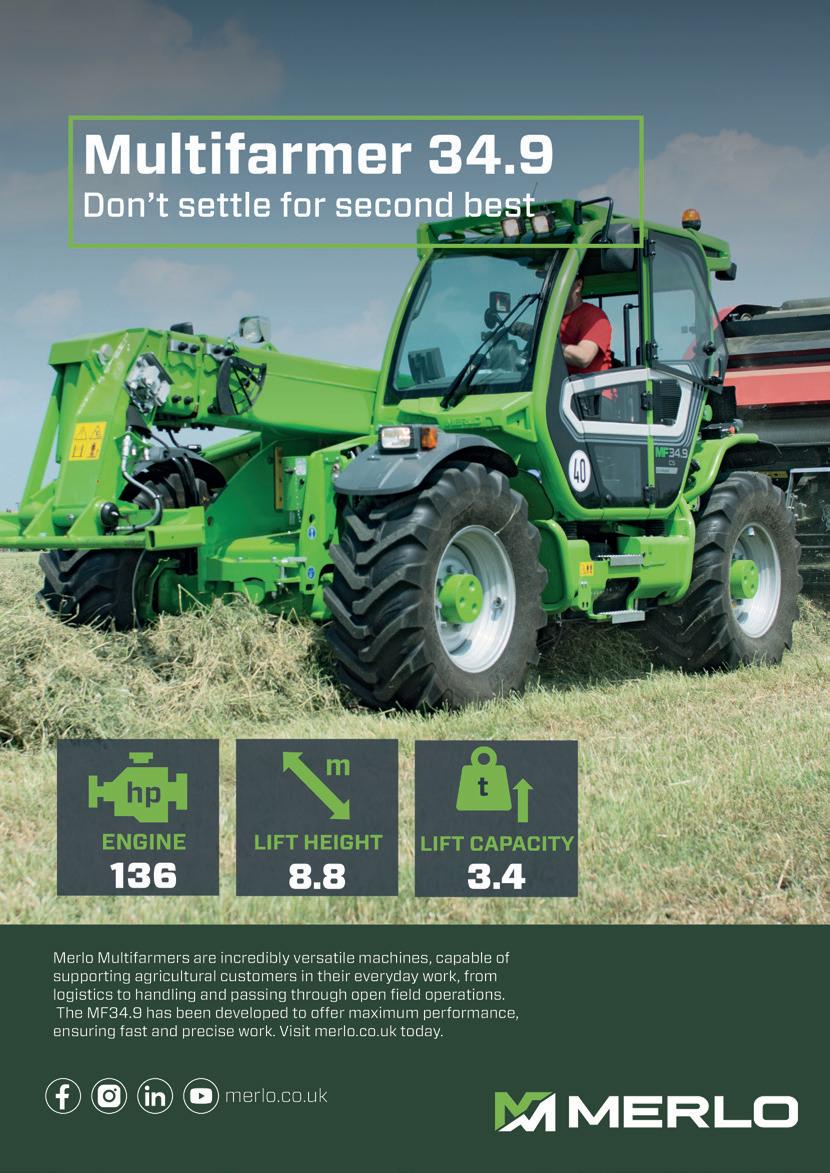
Claas Scorpion telehandlers receive performance and comfort update

For the 2023 model year, the SCORPION telehandlers from CLAAS will receive a comprehensive facelift. In addition to improvements in operator comfort, the smaller models also have new engines with more engine power.
CLAAS has had telehandlers in its product range since 1994 and from 2019, the machines have been developed and built in cooperation with Liebherr. Six models with 143 and 156 hp engines currently cover a range from 7.5 to 11.7 t operating weight, 7.0 to almost 9.0 m stacking height and 3,200 to 6,000 kg lifting capacity.

The entire SCORPION model series from CLAAS is equipped with efficient,
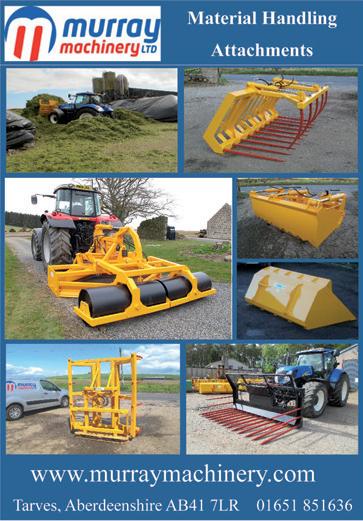
www.farmingscotlandmagazine.com 72 TELEHANDLERS
powerful four-cylinder engines from Deutz. For the 2023 model year, the 3.6 l Stage V engine in the SCORPION 732, 736, 741 and 746 models has been optimised for greater efficiency and performance in cooperation with LIEBHERR. As a result, the SCORPION 732, 736, 741 and 746 models each have 50 Nm more torque and an increase in power output of 6 hp. The compact engines remain economical in operation and maintenance, as usual, and are characterized by low maintenance requirements.
The SCORPION 741, 736 and 732 models have been fitted with the hydrostatic VARIPOWER 2 drive from the CLAAS JAGUAR since 2021. The compact drive unit with its highly efficient, hightorque twin motor ensures a long service life, further improved drive efficiency and a lower noise level on the road. The driver has three driving ranges available – 0 to 20 km/h, 0 to 30 km/h and 0 to 40

km/h – which can be preselected with the press of a thumb, with a maximum speed of 40 km/h. The final speed is reached at a reduced, fuel-saving engine
speed. The braking behaviour of all SCORPION has been further optimised by new components such as the brake valve and brake pedal along with new software
tuning. An automatic parking brake is standard as a braking assistant for uphill and downhill gradients, which prevents the machine from rolling away.
JCB launches zero emission 403e compact electric loader
JCB is introducing its first full electric wheeled loader, delivering best-in-class performance and full working day use, with low noise and zeroemission operation being ideal for work in livestock buildings, glasshouses and alongside farm and horticultural staff.
The machine boasts the largest standard battery pack in
its class, with 20kWh capacity, providing productivity that matches the popular 403 diesel model.
Features include: 20kWh lithium-ion battery pack is largest capacity in the class, 3.4kW drive motor (peak power) with three driving modes, 20kW hydraulic pump motor (peak power) with shovel and fork modes, ZF
axles with an integrated dropbox for permanent four-wheel drive and Digital dashboard and rotary controller for precision operation.
JCB is expanding its full electric equipment line-up, with the launch of the 403E wheeled loader, helping farms and horticultural businesses meet the challenge of carbon reduction.
TELEHANDLERS
The machine is powered by a 20kWh lithium-ion battery pack, assembled from proven JCB modules, as pioneered in the company’s existing range of electric equipment. These batteries, coupled with high efficiency electric motors and optimised traction and hydraulic systems, deliver class-leading performance, with the loader capable of completing a full working day, or 4-5 hours of continuous use in a mixed duty cycle.
FARMING SCOTLAND MAGAZINE
Next issue out
September 2023
New improved range from Manitou
Manitou Group, global leader in all-terrain material handling has a range of new and improved models including the launch of the ‘oxygen’ range which features 100% electric models. The new 26 metre Manitou Rotating Telehandler the MRTe sits alongside the new 6 metre MT 625e model. Also making an appearance is the new access platform, the 16 metre 160 ATJe model.
The new and improved construction telehandler range will feature the new 7 metre model the MT 735 which replaces the old MT 733 alongside the 13 metre model the MT 1335. These machines have been designed to be easy to use, efficient and robust machines allowing you to carry out your construction work in complete safety. These new models offer compact width dimensions, alongside a 75 hp Deutz engine and easy step which is seen in the Newag models to offer easy access to the cab. A new curved panoramic windscreen/roof window has
also been implemented which features a patented roof grill for excellent visibility. The most recent model to the Newag XL range, the MLT 850 will also be displayed for the first time in Scotland which has been designed to meet the needs of large farm’s as well as the
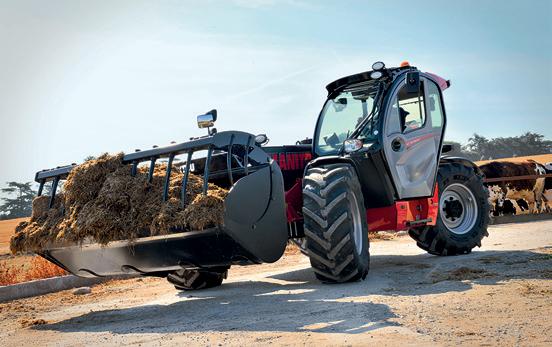
recycling and environmental sector.
With a capacity of 5 tons and maximum lifting height of 7.60 metres, this machine can handle high capacity attachments and a very high hydraulic working speed. The MLT 850 offers more than 600 Nm of torque and with
any of the NewAg XL models, it also has the quietest cab on the market with only 69 dBA to reduce your fatigue. The cab access has been optimised with two Easy-step steps combined with under-door lighting to make getting in and out even safer, day or night.

www.farmingscotlandmagazine.com 74
TELEHANDLERS
New compact Merlo TurboFarmer 30.7 telescopic handler enters the market

Merlo Group works continuously to develop its product range to meet the demands of users worldwide. As a result, Merlo is pleased to announce the introduction of a new model for 2023 to specifically meet the needs of those working in confined spaces such as a traditional farmyard setting.
This new Merlo TurboFarmer 30.7 is the muchanticipated successor to the ever-popular Merlo P32.6 model; a compact model that

www.farmingscotlandmagazine.com 75 TELEHANDLERS
found favour for many years amongst the British livestock farming sector.
The compact overall dimensions of this new model at just 2.00 meter wide and 2.10 meter high means it can quite simply reach the places that
many other handlers in its class cannot.
Despite its compact dimensions the new TurboFarmer 30.7 packs a punch when it comes to performance, powered by a 100hp Deutz TCD 4-cylinder Stage V diesel engine this new

model offers almost 7 meters of reach and a 3-ton lift capacity. In common with all other Merlo TurboFarmer models the 30.7 features EPD managed hydrostatic drive with a maximum speed of 40 km/h plus as standard load-sensing, flow-
sharing powerful hydraulics giving the operator the ability to make simultaneous multiple boom movements at once, optimising performance when mucking out or loading bales.
Fitted with a full-size Merlo ROPS & FOPS cab Merlo offer two additional cab specifications as alternative to the standard cab; The L model offers a reduced overall height of just 1.98 meter and for those looking for increased comfort the patented Merlo hydraulic Cab Suspension is available as an option for standard models.
The patented Merlo ASCS safety system provides the added benefit of automatic attachment recognition when used with genuine Merlo attachments. The addition of the optional 10.1” monitor in the cab offers the operator complete control of hydraulic oil flow rate, working parameter adjustments and digital live load chart is displayed maximising safety.
The TurboFarmer 30.7 is the ultimate compact telescopic handler with powerful hydraulic performance, intelligent machine design and excellent ergonomics as standard. Contact your local Merlo dealer today to register your interest in this new addition to the Merlo range.
www.farmingscotlandmagazine.com 76 TELEHANDLERS
FARMING SCOTLAND MAGAZINE Next issue out September 2023 Subscription page 122
Telehandler implements from Quicke
Quicke, a renowned agricultural machinery manufacturer of tractor loaders and implements, also offers a comprehensive range of telehandler implements that cater to the diverse needs of farmers and contractors. With their commitment to quality, innovation, and reliability, Quicke has gained a reputation for delivering exceptional performance in the field. The Quicke telehandler implements range comprises a variety of attachments designed to enhance the functionality and versatility of telehandlers, enabling users to accomplish a wide range of tasks efficiently.
The bucket attachment is one of the most popular implements in the Quicke range. Available in different sizes and configurations, these buckets are designed explicitly for telehandlers,
allowing for efficient loading, handling, and transportation of various materials such as soil, gravel, sand, and agricultural produce. The high-strength steel construction ensures durability and longevity, even in demanding working conditions. For those engaged in livestock farming, the Quicke telehandler implements range offers specialised attachments such as the bale spike and bale grab. These attachments enable farmers to handle efficiently and transport hay, straw, and silage bales. The bale spike features sturdy tines that penetrate the bale securely, while the bale grab utilises hydraulic arms to provide a firm grip on the bale, ensuring safe and efficient handling.
Quicke also provides a range of lifting and handling implements, including pallet and manure forks. The pallet forks are
ideal for loading and unloading pallets of various sizes, making them indispensable in warehouses and agricultural settings. On the other hand, the manure forks are
Schaffer Loaders
Schaffer is a leading German manufacturer of compact wheeled and telescopic wheeled loaders for agricultural, landscaping, construction and industrial applications. For over 60 years Schaffer have been developing loaders to meet individual requirements and customer satisfaction has made us what we are today: one of the most capable and successful suppliers of farm loaders, wheel loaders and telescopic wheel loaders worldwide. Schaffer were established in 1956, have been supplying machines to the UK and Irish market since 2005 and to this day are still a family owned and run company.
H Fulton tractors Ltd are the importer for Schaffer agricultural loaders, supplying loaders through our dealer network in the UK & Ireland.

Schaffer offer a large portfolio of machines that range from compact and ultra-low profile yard loaders to artic-steer telescopic wheeled loaders with operating weights of up to 12 tonnes. A large variety of attachments makes the Schaffer loaders extremely versatile machines with a multitude of uses in all application. Schaffer employ over 400 staff in their German factory and enjoy a reputation for being innovative, flexible and an international manufacturer of highquality machines.
When it comes to articulated telescopic loaders, Schaffer machines are the most successful in their class. Precision performance on any terrain, with lifting heights and loads that you will not find in comparable machines from our competitors. The compact design,
characteristic of all Schaffer loaders, makes them easy to use particularly in hard-to-reach areas. Add user-friendly controls found in all our models, and you have the perfect material handling
specifically designed for handling animal waste and other organic materials, allowing for efficient cleaning of livestock areas and composting operations.
solution. All loaders have the renowned Schaffer reliability whilst our design engineers have focused on rugged, modern styling to match the powerful performance of the machines.

www.farmingscotlandmagazine.com 77 TELEHANDLERS
Aquaculture
Revolutionary Seaweed Farming Project Paves the Way for Natural Capital Investment on Scotland’s Isle of Skye

Kaly Group Ltd, a natural capital investment company focused on developing marine environment projects, has made significant strides in the six months since receiving an initial investment from The TRICAPITAL Syndicate LLP and Scottish Enterprise. The licensing process for Kaly’s first commercial scale kelp farm in Loch Bay near Stein, northwest Skye, is well underway with Marine Scotland.
Kaly’s go-to-market strategy has expanded to include integration into the fast-growing seaweed biostimulant product category for use on land-based crops and soil. This move aims to enhance topsoil quality and reduce synthetic nitrogen and mined phosphorus use in agriculture while simultaneously remediating harmful nutrient loads in the sea from agricultural runoffs and finfish aquaculture. Working with the Scottish Institute for Marine Sciences and the James Hutton Institute, Kaly is developing a methodology to quantify the environmental benefits of this process.
Kaly is also working on other natural capital projects, including native oyster bed restoration. The company aims to become the leading developer and advocate for the inclusion of marine habitats in emerging nature markets in the UK.
Seaweed farming is an industry with great potential for growth, as the global seaweed market has more than tripled since 2000, with most market forecasts predicting a doubledigit compound annual growth rate over the next decade.
TRICAPITAL’s Managing Partner, Moray Martin, commented on the investment, saying, “Kaly aims to add significant capacity to the Scottish seaweed industry in the next few years. As well as significant economic benefits, seaweed farming can play a huge part in pushing back against climate change by absorbing carbon, regenerating marine ecosystems, creating biofuel and renewable plastics as well as generating marine protein.”
Daniel Hillman, Co-Founder of Kaly Group, commented, “To successfully develop natural capital in the marine environment, we understand there
is a larger exercise of laying the ‘plumbing’ for entirely new value chains and markets. Starting a seaweed farm or an oyster bed and calling it a day was never an option for us. Kaly is creating not only the physical infrastructure to enable a certain degree of scale in the production of farmed seaweed, but also the market mechanisms and governance structures that will allow for UK farmed seaweed to be widely accessible to consumers in various useful products and priced according to its inherent value to people and planet.
This underpins our entire approach to natural capital - that nature needs to have a price
that says it’s worth protecting and enhancing. Some may be content to sit back and wait for these frameworks and structures to emerge spontaneously, but at Kaly we are committed to being a shaping force in the development of a farmed seaweed industry and in the nature markets currently being implemented by the UK government and around the world.”
By investing in Kaly Group, TRICAPITAL and Scottish Enterprise have set a model for the future of the seaweed farming industry in Scotland, creating a prosperous and healthy future for both the industry and the communities it supports.
www.farmingscotlandmagazine.com 78
Mark Jelley announced as FSOOTY 2023 winner
Brixworth Farming’s Mark Jelley has been crowned as this year’s Syngenta Farm Sprayer Operator of the Year (FSOOTY). Announced in the Sprays & Sprayers Arena at Cereals 2023 in Nottinghamshire today (13 June), the prestigious FSOOTY title seeks to recognise and reward the skills and expertise of the UK’s top operators.

Mark Jelley is the lead sprayer operator at Brixworth Farming in Northamptonshire. He has been operating sprayers
for 45 years and now uses a stateof-the-art Chafer Interceptor selfpropelled sprayer to work across 1,500 hectares of combinable crops on the farm’s own land, plus an additional 500 hectares of contract farming.
In addition to his knowledge and attention to optimise every application, the judges exemplified Mark’s approach to progressing the skills of his fellow operators on the farm. That included sharing information and best practice to
ensure they are all working in the same way, which leads to consistently better results.
“Having been a previous finalist I was keen to give it another go,” Mark reported. “The FSOOTY questions make you think, so it’s a good learning experience too.
“Entering FSOOTY is a good way to measure and further your knowledge, and to keep on learning.” He undertakes frequent work-based training, as well as taking every opportunity to increase his knowledge in his own time.
Thrums’ MD highlights career opportunities for veterinary nurses
A veterinary professional who originally joined Scotland’s largest independent veterinary group on work experience and is now the company’s associate managing director, is highlighting the career routes open to veterinary nurses as part of Veterinary Nursing Awareness Month (VNAM).
VNAM takes place every May and this year’s theme is empowerment. The aim of the month is to promote the vital role of veterinary nurses to the veterinary profession and pet owners.
Ashley Wilkie originally completed a week’s work experience at Thrums Vets, which has four practices across Angus and East Perthshire, in 1995 when she was in the fourth form at Webster’s High School in Kirriemuir.

Immediately afterwards she was offered a Saturday job at the group’s Kirriemuir practice, where she cleaned the wards, assisted with preparations and restocking, as well as helping with some basic patient care.
Two years later, after completing her Scottish Highers, Ashley successfully applied for a veterinary nurse placement at Thrums, where she combined
practical experience in practice, with a qualification at Telford College, which is now known as Edinburgh College.
Ashley qualified as a registered veterinary nurse in 2000 and when the Kirriemuir practice moved into new purpose-built premises in 2002, she moved into the building’s apartment, becoming the live in nurse where she cared for inpatients, as well as doing her day job. In 2006 she was promoted to head nurse and played an integral role in growing the nursing team as Thrums opened new practices in Blairgowrie, Forfar and Scone.
More recently, to coincide with the growth of the group, Thrums introduced several new job roles, as well as senior registered veterinary nurse roles, which saw Ashley successfully apply for an associate managing director role.
Ashley said: “Growing up we had horses, dogs and rabbits, and I knew from a young age that I wanted to work with animals, which originally led me to my local veterinary practice, Thrums, for work experience at the age of 15. Back then I never dreamed I would have progressed so far at the practice, but it’s been a hugely
rewarding career and I’ve loved the variation of work in a mixed practice, that covers pets, farm and equine.
“I’ve particularly enjoyed surgical nursing and radiography, as well as getting lots of opportunities to participate in supervised minor surgeries. Most of my CPD was then centred around anaesthesia, wound care and surgical nursing.
“Today we have 13 veterinary nurses across the group, and everyone is hardworking, respectful and friendly. It’s very rewarding to see members of the team become lead nurses in our practices and I’ve always enjoyed helping them find their areas of excellence, as well as being a mentor.”
Ashley added: “To go from kennel girl to associate managing director is something I feel very proud of! Although leadership can be difficult, I envisage what I want my leader to look like, which means being sincere, trustworthy and caring, to both patients and the team. I never ask anyone to do anything that I wouldn’t get involved in myself, which keeps everyone engaged and is hopefully encouraging too.
“I love helping colleagues achieve their goals and moving forward I plan to be heavily involved in the evolution of our independent practice. It’s very exciting to have a say in the direction of the business.”
Finally, Ashley added: “Although it’s taken lots of hard work and dedication, I hope my career path shows what other veterinary nurses can achieve if they are ambitious and work for a forward thinking and supportive employer. Understandably, in a veterinary practice, the vets can become a focal point but it’s important to recognise the hard graft and dedication of the nursing teams too. It’s therefore fantastic to shine a light on the opportunities that are available to nurses and especially during VNAM.”
people
www.farmingscotlandmagazine.com 79
Innovators wanted to help boost rural economy
Businesses and entrepreneurs are being sought to take up residence in a multi-million pound innovation centre creating new links between science and industry in rural Scotland.

Set to open in Inverness later this year, the Rural and Veterinary Innovation Centre (RAVIC) will develop new technologies and systems for the country’s land and marine-based sectors, including the green and blue economies of agriculture and aquaculture.
The £12.5 million pound project is being led by Scotland’s Rural College, (SRUC) whose existing Centre for Epidemiology and Planetary Health will provide a core function. It has been funded by the European Regional Development Fund, the Scottish Funding Council and SRUC.
RAVIC will bring together scientists, innovators and businesses to create new products, services and solutions to overcome sector challenges, including
those posed by animal disease, climate change and food security. There will also be an emphasis on bioscience, including animal health, as RAVIC is to form part of Scotland’s new School of Veterinary Medicine.
As climate change continues to accelerate, the farming sector will be faced with rapidly changing animal diseases and uncertain markets. RAVIC will provide a much-needed research infrastructure to support the development of innovative systems and other practical tools to help Scottish farmers and land managers. RAVIC will work closely with SRUC’s Veterinary Surveillance Intelligence Unit, a recently developed Scottish livestock information system, that will provide new ways to help farmers deal with animal diseases, increase production efficiency and thereby reduce carbon emissions.
Located on Inverness Campus, a Highlands and Islands Enterprise
(HIE) development, the RAVIC building, will house several commercial business incubation units, a lecture theatre, wet and dry molecular, necropsy, and microbiology facilities, and a public atrium.
Dr Adam Giangreco, an international expert in commercial, translational, and applied life sciences, has been appointed as Head of Business Development. The post has been supported through a partnership between RAVIC and HIE which has helped facilitate the development.
The collaborative hub will be looking to attract businesses that will enhance the rural economy, capitalise on the area’s natural assets, and support the transition to a net-zero economy.
RAVIC Director Professor George Gunn said: “The Highland innovation centre will help short circuit the gap that exists between science and business to unlock the true potential of Scotland’s blue
and green economies to create high value jobs. The development reinforces SRUC’s commitment to expanding its regional presence in the area and it will also be an important addition to the existing range of expertise already on Inverness Campus.”
Elaine Jamieson, head of food and drink and life sciences at HIE said: “We’re looking forward to working with SRUC and growing the culture of collaboration that exists across Inverness Campus. RAVIC will enable businesses to work alongside scientists and researchers to develop products and services that are aligned to industry challenges and needs, transforming food systems to ensure they become more sustainable, secure and efficient. The growth of entrepreneurial businesses and research capacity will contribute to the further development of two key sectors in the Highlands and Islands: life sciences and food and drink.”
www.farmingscotlandmagazine.com 80 ARTICLE
The Border Union Agricultural Show 2023
By Dan Withall
The Border Union Agricultural Show is the highlight of the event calendar for the Scottish

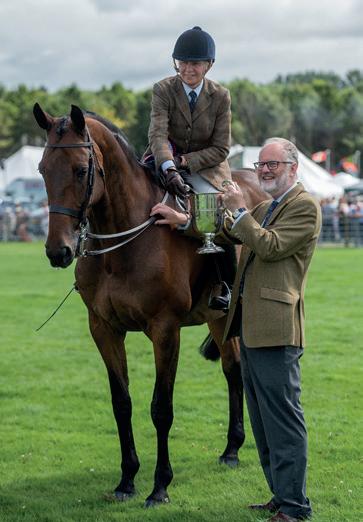

Borders and Northumberland. The Annual Show is held on the last Friday and Saturday of July
at the Springwood Showground across the magnificent River tweed a short walk from the historic cobbled square of Kelso.
The town boasts an award winning Farmers Market packed with local and rare breed meat and food producers many of whom are displaying their wares at the show and join us for carvery and recipe demonstrations at our food fair.
The show is a traditional farming show with over 500 open competitions for horses, sheep and cattle. There is also a popular goat section and rabbit show.
Sadly due to the scourge of avian flu our annual poultry
show has not been staged since 2019 and that ahead of the arrival of the pandemic which saw so many agricultural shows challenged with their very survival.
2022 was our come back show and we now build on this success to promote and develop the event, always recognising the changes we now face with new ways of working and costs of transportation and utilities. Nevertheless the show is tremendously supported by all its members who have loyally taken us through the pandemic and look forward to entering their show stock and enjoying the comforts and delicacies
www.farmingscotlandmagazine.com 81 BORDER UNION AGRICULTURAL SHOW
of the Members Marquee this year supported by the local Tempest Brewing Co with their collection of fine ales, barley wine and other tempting liquid refreshments they provide a gluten free variety.
The Border Union Agricultural Society was formed in 1813 and as a charity continues to deliver an annual livestock show, world famous Tup Sales on the second Friday of September and Crufts qualifier Dog Show in June.
Alongside these events the Society provides educational schools days in May demonstrating to youngsters across the Scottish Borders where their food comes from and how they might one day start working in the rural economy themselves. This year saw the addition of a science and technology version which aims to retain talent in the Borders to supply and assist in the business of food production.
Our bi-centenary year saw The Society set up a Bursary Fund which has been providing grants to university and college leavers to further their travels and expertise to bring back to their own work in agriculture, science and arboricultural industry in the Scottish Borders and North Northumberland.
This year’s Border Union Show will present a vast array of activity and interest for all walks of life.
Our own pet show on the Friday 28th July is a firm favourite with the younger generations and supported by
the Society’s own Honorary Veterinarians Galedin Vets who support and care for small and large animals across the Scottish Borders.
The show is a great family event providing entertainment at every level including the Royal Highland Educational Trust (RHET) demonstrating, through educational and hands on fun activities, the principals of the dynamic farming world.


To compliment the family theme The Sheep Show provides a memorable family moment with a great contemporary soundtrack and subtle encouragement to learn more about shearing, wool and sheep production, all co-ordinated with our hoists unmistakable Kiwi drawl.
There are over 175 trade stands for everything you could imagine from tractors and farm supplies to clothing and food outlets. A stroll along the rows of the heavy machinery is a fascinating trip into todays and indeed tomorrows technology with the vast and gleaming bodies of the famous brands all on show for the enthusiast and professional alike. Many of our stall holders have been supporting the Border Show for generations and we welcome their sons and daughters to the site every year.
Our fantastic Food Fair welcomes producers from throughout Scotland and far beyond demonstrating and offering a taste of their precious and carefully produced wares. We specialise in hosting those
who make sustainability their key goal applauding the principals of seasonal foods and ‘slow food’ production with many of our favourite producers living within the Kelso community and nearby Scottish Border towns.
You will discover rare breed lamb and mutton provided by Going Native Heritage Meats, incredible melt in the mouth beef from Hardies Mill and range of honey, dried fruits and my personal favourite sausage rolls from Rola Mor.
The food hall is also home to our busy Cookery Theatre with a full daily programme of demonstrations, recipe tips and if you are lucky to be there at the right time a taste of something wonderful. This year we have the noted local chefs Ross Horrocks form the Caddy Mann near Jedburgh and Billy Hamilton Head Chef of the Buccleuch Arms at St Boswells. Both passionate chefs and immensely proud of the local food producers whom they use all year round.
2023 sees the return of our growing association with the local Hotel and Spa Schloss Roxburghe. Formerly the Sunlaws House and part of the Roxburghe Estates the chef and sommelier provided a fascinating insight into pairing meat with fine wines in 2022 and we eagerly anticipate their skills in 2023.
Our expert butchers and breeder of North Northumberland Lamb and Mutton Jimmy ‘The Lamb Man’
Bell has been supplying the TV Motorbike riding chefs the Hairy Bikers with his quality lamb and he returns in 2023 to demonstrate the fine art of butchery and carvery twinned with the remarkable local young butcher Briggsy from Jedburgh who has been working hard with us at our education days having fun making sausages with the classes and showing them just what goes into the proper beef burger.
Award winning Alison Tuke has been farming at Hardiesmill for many years and the land has been a farm since 1560.
She has a determined process as she explains:
“We try and keep cattle outside on the grass throughout the year, though living in Scotland means this is not always possible. The cattle do not mind the cold, nor the wind, but nobody likes endless days of rain. So we bring them in if it is very wet to save the ground and to let the cattle enjoy a drier lie. They are bedded on straw courts and have free access to grass sileage/hay bales which are put in daily.
“We have been experimenting with different grass varieties over the last 18 years, to extend both the growing season and the resilience to the variations in the weather. All are species rich in order to be sustainable and to contribute to the flavour of the beef. We also retain our grass for longer in lays in order to increase its minerality, healthiness, carbon sequestration and goodness, which is paying dividends.”
www.farmingscotlandmagazine.com 82 BORDER UNION AGRICULTURAL SHOW
For many years the Border Union Show has been growing plots of its own to use on show days as demonstration areas. This year we shall be growing Charlotte salad potatoes and harvesting with a horse drawn machine to demonstrate historic practices in motion. Our partners will be the Fingerpost vegetable growers who are a frequent seller at the Kelso Farmers Market and keen to work with us on this type of project.
Elsewhere in the plots we have Golden Promise a malting grain to be harvested by Charlie McCriricks wonderful combine plucked from another era at least compared to the monsters of the harvest landscapes of today.
Alongside this endeavour the flower plots rich with organic flowers and grasses designed to put back minerals and rejuvenate the land on which they grow. Supported by Dods seeds.
No show can possibly be amongst the historic best without a dynamic and enduring Industrial Section. Kelso has its own robust committee, planning and sorting the myriad entries to deliver a show of cakes, scones, needlework and all manner of activities. Now known as the Bake and Create section it holds its own with the jams and flower arrangements fit for a special occasion and what better than a well spent hour perusing the winners in the exhibits hall.
We are well blessed with sheep entries from far and wide and despite the challenges of previous years we hope for a
grand entry on Saturday morning to demonstrate the stock quality and breeding knowhow in the region.

As cattle entries are much enhanced by a National Show we have a local posse who fulfil the much admired Champions who grace the show field mid Saturday afternoon to strut their stuff in front of the Main Ring crowd to much applause and genuine interest. The cattle rings area popular haunt for visitors who welcome the opportunity to get up close to these gentle giants and get an idea of their extraordinary presence and link these beast to their every day life and what we take for granted with the efforts and toil of those who choose to farm and fulfil the public demand.
The evening milking of the Goat section starts on the Friday at 6pm promptly where the goats are stripped out and judging continues right through the Saturday until a champion can be found. A firm favourite of visitors around the Borders there will be 2 shows at the Border this year on Friday for the Goat Society and our own championships on Saturday.
Next door the rabbits are equally adored by the younger visitors and families looking to get up close to the visitors in their own tent. Now more than ever the ability of animals to calm and delight youngsters remains an important part of placing the public in front of livestock and continuing to demonstrate the cycle of life in its proper form.
There is less and less opportunity to get involved these days and important that we remain focused on educational opportunity.
The craft and gift marquee has developed over the years and with so many finding a rewarding home based occupation it is vital we support the skills and variety of the many exponents of these often unique activities. As ever a great place to find that unusual gift for the hard to please.

Wherever there is a show there is a group of Young Farmers raising funds with count the balloons in the tractor tug o war or a chance to dunk someone in the water. Great fun and critical to the longer life of any event as they move through the ranks become stewards and eventually directors themselves. Kelso has its own local Ednam group keeping up their reputation for fun and a few beers after the show.
If its fun you after then the Border Union Show has always enjoyed the fun of the fair and candy floss, waltzers and a hair raising ride a particular delight. Bright lights, sugar and a few spins might require a sit down but it would be foolish not to take a chance for a ride or two.
The main ring fills the day with a hearty variety of dog trials, falconry, gun dogs and the magnificent sights of the heavy horse and carriage driving rare chances to see them in all their glory and on show. A few dare devils in the mix upside down and flying around on two wheels for the young at heart and the daring do of the pony club games to boot.
A weary walk home with the bairns all face painted up and happy in their world amazed by the sights and sounds and ice cream cones a plenty. Haste ye back! See you next year.
www.farmingscotlandmagazine.com 83 BORDER UNION AGRICULTURAL SHOW
Versatile livestock farm in the Scottish borders
Galbraith is bringing to the market a compact mixed farm in an accessible part of the Scottish Borders. Hawksnest Farm has about 195 acres of grazing land, an attractive three-bedroom cottage and an extensive range of modern and traditional farm buildings.

Duncan Barrie of Galbraith, who is handling the sale said: “This is a well-maintained and very adaptable farm in a lovely setting, surrounded by the rolling countryside of the Scottish Borders. The farm is equipped with a productive block of pasture land which is all in good heart and situated within a ring fence. There is an attractive three-bedroom cottage as well as an excellent range of farm traditional buildings and modern cattle sheds which could be put to a variety of uses.”
Balintore Cottage is situated in a private and secluded position with views over the surrounding countryside. The cottage provides spacious accommodation over one level, including three bedrooms, sitting room, kitchen and utility room. The cottage has its own garden, with a lawn, vegetable patch and small orchard.
The farm buildings at Hawksnest include, a range of traditional farm buildings split into a former byre, granary and stores, with a number of more modern storage and cattle sheds which may present alternative uses subject to obtaining necessary planning consents.
The farmland lies in a single block to the south and east of the
farm steading and is bound to the east by the Allan Water. The land has been classified by the James Hutton Institute as Grade 4.2, with a small area of Grade 5.1, and is currently all of the ground is down to pasture and used for a mix of grazing and fodder production.
Hawksnest Farm enjoys a central position in the Scottish Borders, about 6 miles from Lauder and 7.5 miles from Galashiels while Edinburgh is about 30 miles. The nearby towns of Lauder, Earlston and Galashiels all provide an excellent range of business services and recreational facilities, whilst Edinburgh is highly accessible either by road via the A68 or A7, or via rail from the railway station at Stow (3.5 miles).
The Borders region benefits from a plethora of golf courses

and hunting with the Lauderdale, Berwickshire and Buccleuch Hounds, horse racing at Kelso, as well as salmon fishing on the River Tweed and lovely walking routes including the Southern Uplands Way.
The local area is well provided for by agricultural merchants and suppliers, with the nearby St Boswells Mart (13 miles), Stirling Agricultural Centre, just outside Stirling (65 miles) and the Borderway Mart
at Carlisle (68 miles) all good outlets for livestock.
Hawksnest Farm is for sale through Galbraith as a whole for offers over £1,220,000 or in two lots as follows:
• Lot 1: Balintore Cottage, farm buildings and land extending to approximately 13.12 ha (32.42 acres), Offers Over £495,000.
• Lot 2: Buildings and land extending to approximately 67.03 ha (165.63 acres), Offers Over £725,000.
Subscription page 122
www.farmingscotlandmagazine.com 84
estate
MAGAZINE
FARMING SCOTLAND
Next issue out September 2023
High demand and rising prices continue to limit access to Scotland’s valuable rural land
More support in Scottish Government to cover rural matters is needed
By Simon Ritchie, Press & Public Affairs Manager at Scottish Land & Estates

It’s less than three months since Humza Yousaf got the keys to Bute House. To say he’s had a busy start would be an understatement. From party issues to policy delivery challenges to court battles, the First Minister’s inbox would make us all gulp.
Stepping back, we all know the world is facing two distinct-yet-intertwined manmade crises: global heating, and biodiversity loss. Scotland is no exception, and Scotland’s people and our political leaders are responsible for how we as a nation respond to those challenges.
key... but the Land Reform Bill also seeks to break up landholdings, making that investment harder to secure.
Scotland’s increasingly valuable rural land is only available to a limited few as high demand from forestry, natural capital investment, and corporate estate buyers continues to drive high prices, according to a new report by the Scottish Land Commission.


The Rural Land Market Insights Report 2023 underlines the need for action to ensure that communities, family farms, local businesses, and individuals are not priced out of the rural land market due to sustained high land prices driven by largescale forestry and natural capital investments.
The report notes that, while forestry land prices flattened at the end of 2022, demand outstripped a continuing rise in the supply of land across the board, maintaining the “seller’s market” of 2021.
Andrew Thin, Chair of the Scottish Land Commission, said: “The findings of our latest report underline the pressing need for action, including through the measures the Commission has proposed for the Land Reform Bill in relation to better regulation of significant land sales.
“Scotland’s land is increasingly valuable and in demand for several reasons. There are competing objectives as Scotland makes rapid changes to deliver on the Scottish Government’s climate and nature goals. Our land market report emphasises the need to actively shape these changes through policy and regulation to deliver on Scotland’s ambition for a just transition. But failing to act now risks exacerbating existing issues of concentration of ownership – leaving individuals and
To make progress towards a future agriculture policy, farmers and land managers require clarity on future payments and support from the government. Mairi Gougeon, the Cabinet Secretary for Rural Affairs, Land Reform & Islands, bears the responsibility of advancing this policy. Additionally, a Land Reform Bill is scheduled for this year - also Ms Gougeon’s brief. Once again, how we use our land in Scotland in the years to come will make all the difference in how quickly we reach Net Zero carbon or halt the decline in biodiversity, both in keeping with a Just Transition. Tackling those things will require much more cash than the government can afford itself, as it has already accepted, and private investment into large scale projects will be
In addition to agriculture and land reform, Mairi Gougeon is also responsible for the Wildlife Management & Muirburn Bill, which requires extensive work. However, she lacks the support of a junior minister, unlike other Cabinet Secretaries in different portfolios. Scottish Land & Estates and its members see this resource problem at the highest level of government and believe that the Rural Affairs brief should receive equal support.
While acknowledging that the First Minister has the authority to structure his team as he sees fit, Scottish Land & Estates has written to him, urging the appointment of a junior Minister for Rural Affairs. The workload associated with multiple bills and the need for effective representation of rural businesses necessitate additional capacity at the Cabinet level.
The Cabinet Secretary for Rural Affairs, Land Reform & Islands is an extremely capable and respected politician, but nobody could do all this work alone. This is an issue of capacity. That’s why we have written to the First Minister, calling on him to give the Rural Affairs brief the same support as other briefs, and appoint a junior Minister this summer.
estate www.farmingscotlandmagazine.com
For more information www.scottishlandandestates.co.uk Telephone : 0131 653 5400
communities increasingly unable to acquire the land they need.”
The report highlights that commercial forestry continues to be the biggest driver of increasing land values, particularly in upland and non-arable agricultural land. Additionally, natural capital investment motivations remain
widely discussed and are a key driver in the market.
The report indicates that the proportion of land being sold off-market/privately may have slightly reduced across the board as sellers seek to make the most of competitive market conditions; however, more smaller transactions appear
to have been taking place offmarket/privately.
Corporate and institutional buyers are still very active and a driving force in estates, upland, and marginal agricultural land, especially where peat is present. The report highlights that corporate and institutional buyers are increasingly interested in land
as a financial asset and inflation hedge, with less immediate interest in land use.
Finally, the report notes that, with the exception of prime arable, distinctions between land classes and uses are becoming increasingly blurred as forestry, natural capital, and agricultural buyers all chase the same land.
SLW responds to RSPB Scotland claims regarding hen
harrier survival rates
Scottish Land & Estates has issued the following statement in response to a new report by RSPB Scotland regarding hen harrier survival rates
Mark Tennant, chairman of Scottish Land & Estates, said: “The vast majority of the UK’s hen harrier population is found in Scotland, with more than 500 pairs recorded in a recent report by NatureScot. Estates play a vital role in encouraging raptors to flourish, including through the recent Heads Up for Harriers project which saw 28 estates participate and the South of Scotland Golden Eagle Project where 90% of translocated chicks have come from grouse moors.
“Any persecution of hen harriers – and any form of wildlife crime generally – is abhorrent and our members are committed to assisting government and police in this area. In this regard, we recognise the official statistics published by the Scottish Government in its annual wildlife crime report, with the most recent report released last month confirming that offences against birds of prey are at historically low levels with 12 offences recorded in 2020-2021.
“RSPB Scotland has not provided the data it is using for this latest report to partners and this lack of cooperation undermines a collective effort to tackle raptor crime.
“There have been long-held concerns regarding transparency around data collected by RSPB from satellite tags and how they
interpret it. It is in stark contrast to organisations such as Natural England that provide a publicly available tracking update for hen harriers on a quarterly basis. Where a tag stops transmitting, Natural England takes great care to ensure conjecture does not form part of its analysis.
“It is well established that there is a high natural mortality

rate for hen harriers in their first year and other factors including weather, availability of prey and predation by foxes and other birds can all play a big role in their survival. Likewise, there are different reasons why tags stop transmitting, not only persecution, and police do examine the circumstances when tags no longer send signals. This
is a complex issue and great care should be taken when drawing conclusions on data not publicly available.
“Scottish Land & Estates is supporting a national survey of the hen harrier population and we hope by working alongside other partners that we can soon establish new and accurate data about the Scottish population.”
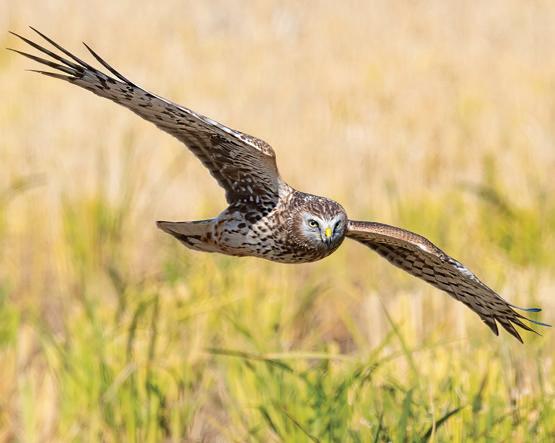
estate www.farmingscotlandmagazine.com 86
Productive land near Morpeth comes to market

Notes of caution sounded at Scotland’s grouse symposium
Galbraith is bringing to the market a highly accessible, ring fenced block of productive land and woodland extending to 204.01 acres (82.56 hectares), with excellent potential for arable cropping, mixed farming or natural capital projects.
The Land at Earsdon West Forest includes seven principal fields of a good size and enjoys excellent access from north and south via the adjacent A1.
The property is for sale as a whole for offers over £1.85 million.
Alistair Cochrane of Galbraith, who is handling the sale, said; “This is one of the first significant blocks of land on the Northumberland coastal plain that has been brought to the market this year. The majority of the land was previously devoted to a rotation of oilseeds and cereals but was laid to grass in 2017 and has since been managed to produce high quality haylage crops. We believe that this will have enhanced soil structure and fertility and that the land will lend itself to the successful resumption of arable cropping if desired.
“The land is well shaped and highly accessible and is well located in relation to local cooperative grain facilities. The fields are well laid out and of a generous size, easily accommodating modern farming machinery, and the property offers an ideal opportunity for existing arable enterprises to spread their fixed costs.
“In addition, there is a significant conservation dimension.

A considerable area of new woodland has been planted in recent years, almost entirely broadleaved, and a pond has been created, considerably enhancing the amenity value of the land and providing varied habitats for wildlife. The new planting supplements existing streamside habitats and the owner has also restored and planted hedgerows.
“There is the potential for the purchaser to consider natural capital or Biodiversity Net Gain opportunities in addition to the potential for arable crops and in particular the location of this landholding, adjacent to the A1, is a significant advantage.”
The Land at Earsdon West Forest includes 161.60 acres of productive arable and ploughable grassland with 38.49 acres of woodland, comprising a mix of well-established, principally broadleaved species.
The Land is classified as Grade 3 on the MAFF Land Use Capability Classification and falls mainly within the Hallsworth Series of Soils.
The young woodlands which have been established over the last 20 years comprise a diverse species mix and these woodlands, field margins and pond add enormously to the amenity of the property, as well as adding wildlife interest and sporting potential.
The land is subject to a Countryside Stewardship Scheme Agreement commencing on 1st January 2022 and ending on 31st December 2026, producing around £8,531 annually.
A one-day symposium, Practical conservation for Scotland’s Grouse, organised by the Game & Wildlife Conservation Trust and the World Pheasant Association and sponsored by Hampden & Co took place at Balhousie Castle, Perth, on Friday 5 May.

A wide-ranging programme highlighted the pressures on Scotland’s grouse species, including climate change, disease, disturbance, failure to agree on the way forward among ‘stakeholders’, emerging land management regimes such as ‘green washing’ and carbon offsetting, afforestation, and political change and its unintended consequences.
The opening address was given by Finlay Carson MSP. He was followed by Patrick Laurie speaking about black grouse; Dr Kathy Fletcher, GWCT, on ptarmigan; Matthew Colston, Elanco Animal Health, on tackling tick; Dr Beth Wells, the Moredun Research Institute, on vaccine development for louping ill; Ross Ewing, Director of Moorland, Scottish Land and Estates on threats from the Wildlife Management and Muirburn Bill; and former GWCT Chairman Ian Coghill urging all to listen to the science.
The afternoon programme included Bruce Cooper, specialist land management consultant; Dr Nick Hesford, GWCT, on gathering evidence; Professor Neil Metcalfe, Glasgow University and Chair of the Scientific Advisory Committee on capercaillie; and Rory Kennedy, GWCT Director Scotland calling for collective action to save Scotland’s capercaillie.
Patrick Laurie said he had witnessed “the devastating collapse of black grouse in Galloway, their decline mirrored by other birds like curlew, driven to a level below which they cannot survive by the massive expansion of commercial forestry” and that we were “shepherding birds into non-existence.”
Speaking about capercaillie, Rory Kennedy said an adaptive management approach was needed and that this species, saved from extinction in the UK once already, required especial effort with all options in play including access exclusion around lek and nest sites, fence marking, heightened predator control and the trialling of other possible solutions such as diversionary feeding for predators over limited time periods, and control of pine marten numbers through contraception.
Hugo Straker of GWCT, co-organiser of the conference, said:
“This was a highly thoughtprovoking event, and important for those with the knowledge and a broad range of opinions to come together to look at the status of our four grouse species. What emerged was certainly a significant note of caution that, whether through legislation or consequences on habitat and species in our bid to combat climate change, or as a result of many other factors that we can control, we do not in fact damage the important objective of biodiversity recovery – including the conservation status of our four grouse species. Evidence and common sense must not become casualties alongside biodiversity loss.”
www.gwct.org.uk/auchnerran/
estate www.farmingscotlandmagazine.com
Free woodland advice for crofters and smallholders
Free advisory visits offering help to access grants for tree planting and woodland management are being offered to crofters and smallholders.

The Scottish Government’s Farm Advisory Service, delivered by SAC Consulting - part of Scotland’s Rural College (SRUC), is working in partnership with Woodland Trust Scotland to provide advice on agroforestry and help crofting communities establish new woodland.
The Woodland Trust Scotland’s Croft Woodland Project also provides support to establish hedges and shelterbelts and manage existing woodlands.
There is little tradition of woodland management in crofting as, until 1991, these rights were reserved for landowners, not their crofting tenants.
However, there are many benefits to planting trees on crofts, from improving productivity and offering opportunities for diversification, to increasing carbon capture and providing habitats for wildlife.
Janette Sutherland, from SAC Consulting, said: “This offering from the Farm Advisory
Service and the Croft Woodland Project will give crofters excellent advice on managing or creating woodland on their crofts, bringing a range of benefits to land, crops and livestock.
“FAS has many other useful resources for crofters, including guides to starting up and succession, as well
as further advice through our Young Crofter subscription or a Specialist Advice plan.”
Iona Hyde, from Woodland Trust Scotland, said: “We are delighted to be working with the Farm Advisory Service to promote woodland creation and management across the Highlands and Islands.
“A new online tool should make accessing advice and support from the advisors easier for crofters and smallholders across the crofting counties.”
To request a free visit from a woodland advisor, fill in the form on the Farm Advisory Service website at: www.fas. scot/croft-woodland
Union calls for farmer-friendly forestry grants
Future grant support for forestry must become more farmer-friendly, cut out red tape and support the establishment of smaller areas of trees and hedges that can integrate into farms and crofts.
Following a six-week survey of members, the Union has also used its response to the Scottish Government’s consultation on the Forestry Grant Scheme to reiterate its concerns over the award of planting grants to establish trees on productive farmland.
NFU Scotland Vice President Andrew Connon said: “We have hugely ambitious targets for tree

planting in Scotland and farmers and crofters have a huge role to play in that. However, forestry targets must recognise that we need to have the right tree in the right place.
“Members remain deeply concerned about the volume of productive land in Scotland that is being taken out of agricultural production for trees. This loss of productive land is regularly supported by the existing forestry grant scheme.
“There were comments that large swathes of productive farmland are being bought by private investors looking
to offset carbon emissions in their own industries. There are fears that this is not being done with food production, climate
or nature in mind, but a way to satisfy individual business interests at the expense of rural Scotland. We feel that
forestry
www.farmingscotlandmagazine.com 88
‘greenwashing’ remains a huge concern for our members.
“On future budgets for planting, the majority of our members believe food production should be the priority for the agriculture budget. Forestry and woodland funding should not dilute this and come from a separate funding stream.
“Of those respondents who have had experience of applying for forestry grants, the vast majority found the current process complicated, expensive, time-consuming and ineffective. A lack of support from Scottish
Forestry advisors saw many having to employ consultants to complete applications. That has been prohibitive and must change if we are to encourage small-scale planting.
“We need an easier application process, less red tape and support for smaller areas of woodland, shelter belts and hedgerows that we can integrate into existing agricultural activities.
“We will continue to engage with Scottish Forestry on the development of the grant scheme to ensure it’s workable for farmers and crofters.”

SLE enhances policy team with new adviser on biodiversity and woodlands
A new policy adviser on biodiversity and woodlands has been appointed by Scottish Land & Estates.

Nathan Bryceland has joined the rural business organisation to support the work of SLE members across Scotland as they work to address the nature crisis.
Nathan joins Scottish Land & Estates with 20 years’ experience working in countryside management and education, with countryside ranger services, local government, and government agencies – including 10 years leading learning programmes with Historic Environment Scotland. He has also worked closely with Scottish rural estates and the tertiary education, tourism and agricultural sectors.
Over the years, Nathan has worked on multiple partnership projects focused on Scotland’s natural and built heritage, including woodland creation and management schemes, biodiversity surveying and community engagement (including conservation volunteer management), and has extensive experience of leading environmental educational excursions for groups of all ages and abilities across Scotland and beyond.
Driving to decarbonise the forestry sector
Around 7 million tonnes of wood are harvested from Scotland’s forests each year and transported to sawmills, board manufacturers and other processors, mostly on 44 tonne diesel lorries.
The forestry sector is primarily known for being a “green” industry but it is still striving to do more to decarbonise.
How timber is transported is a key factor which is getting attention. Much funding has been awarded in previous years to shipping timber by sea, rather than always using diesel lorries, but there is a new trial underway to test electric lorries.
Nathan is a graduate of the University of Edinburgh and Aberdeen, with PGCE and MA Honours in Environmental Education and History, specialising in land use, management and recreation in the Scottish Highlands & Islands and national parks.
Biodiversity and wildlife projects that SLE and its members are involved in include Saving Scotland’s Red Squirrels; South of Scotland Golden Eagle Project; Peatland Action; Working for Waders, and the Alliance for Scotland’s Rainforests. SLE members are also at the forefront of the Wildlife Estates Scotland accreditation scheme, a best practice scheme that promotes the highest standard of game, wildlife and habitat management practices.
Scottish Forestry has awarded £452,000 towards a three year trial which will test the use of state-of-theart electric timber wagons to transport timber.
As part of the project, which is the first of its kind in the UK, two Scottish timber companies, James Jones & Sons Ltd and Scotlog Haulage, are partnering with the Volvo Group and Cleaner EV to undertake the demonstrator project.
James Jones & Sons Ltd, one of the largest sawmill groups in the UK, will trial a 40 tonne articulated lorry from their sawmill in Lockerbie to transport timber to their Hangingshaws national distribution centre.
Scotlog Haulage will trial a 44 tonne truck in
the Highlands, moving roundwood timber from Inverness Harbour to West Fraser and other local mills.
During the three year trial, the vehicles will be evaluated for their achievable mileage vs battery consumption, durability, viability and total cost of ownership.
A key element of the three year trial is that all the partners involved are committed to sharing their experiences of running the electric lorries with others in the timber and rural haulage sectors.
Creel Maritime consultants will monitor the use of the lorries and arrange knowledge exchange opportunities over the course of the following three years.
The two new electric timber lorries are due to arrive in Scotland in the summer and one might even make an appearance at this year’s Royal Highland Show.

www.farmingscotlandmagazine.com forestry
89
Ffermio Cymru
Welsh Farmers and wider rural economy to be denied much needed extra revenue
WELSH farmers are to be denied the chance to make thousands of pounds in extra revenue this year as the Welsh government decides not to relax planning regulations affecting agritourism.
Despite launching a consultation into extending Permitted Development Rights in February 2022, Pitchup.com believes the Welsh government has opted not to go through with the change due to ‘limited resources’.
However, the issue might be revisited in the future, Pitchup. com believes.
According to Dan Yates, founder of Pitchup.com, the move could cost Welsh farmers thousands of pounds this year, and the wider Welsh rural economy millions of pounds.

He said: “This was a real opportunity to make a huge difference to farmers who are currently going through the biggest financial turmoil in decades, as well as the wider rural economy which is still recovering from the COVID pandemic.”
Permitted Development Rights enable farmers and other landowners to set up temporary campsites on their land for 28 days per year without needing to apply for further planning permission.
However, in June 2020, the Westminster government temporarily extended this to 56 days per year to help the rural economy recover from the COVID pandemic and to provide increased capacity for people unable to holiday abroad. The Welsh government made a similar move in April 2021, extending the limit to 56 days for the rest of the year.
The scheme was such a success, generating more than £25m for the UK rural economy in 2021, that it prompted the Welsh government to launch a consultation into permanently extending PDR to 56 days, in February 2022.
The Welsh government has remained tight-lipped on the consultation since then and so far has made no public announcement on the outcome, despite promising one in 2022.

But sources close to the Welsh government have told Pitchup.com a decision to keep the allowance at 28 days has been taken.
Dan Yates said: “The saga of the Welsh government consultation into PDR has been dragging on well over a year now, without any meaningful updates. But we have it on very good authority – sources close to the government – that the change has been canned, for this year at least.
“The government seems to be citing a lack of resources as the reason the change won’t happen, but this seems at odds with the length of time the consultation has been going on. Surely, over the course of the past 16 months, they could have found the time to make a decision?
“Farmers have limited resources too, now more than ever as farm payments are being wound down, and this unfortunate news means the opportunities to bolster their income are further diminished, as is that of the communities that surround them, which would have benefitted from an increased tourism spend.
“We can only hope the Welsh government realises the
opportunity extending PDR would bring to Wales’s rural communities and revisits the issue as soon as possible.”
Currently, the Westminster government is consulting on extending PDR in England to 60 days per year, but putting a 30-pitch cap on campsites wanting to open for the full 60 day term.
No such consultation is taking place in Scotland, nor has the Scottish government announced it intends to make any changes to the regulations governing pop-up campsites.
However, out of all the countries that make up the United Kingdom, figures suggest Wales would benefit the most from extending Permitted Development Rights.
That’s because 34% of holidays in Wales involve
camping or caravanning, compared to just 20% in England and 21% in Scotland.
“When people visit Wales, they’re looking for an outdoor, back-to-nature, kind of experience,” Dan Yates said.
“Our data shows demand for these experiences is on the rise. Bookings for camping holidays in Wales are up 33% this year compared to last, and as the cost-of-living crisis continues, we believe this will increase as camping offers the best value for money for cash-strapped families.
“Therefore, extending the opportunities to do this would have had a marked impact on Welsh tourism and the rural economy, as well as giving people the opportunity to have an affordable holiday in a beautiful country.”
www.farmingscotlandmagazine.com 90
IBERS recognised as a sustainable farming research centre of excellence

Aberystwyth University’s Institute of Biological, Environmental and Rural Sciences (IBERS) is joining sustainable farming organisation, Linking Environment and Farming’s (LEAF) UK network of world leading innovation centres and demonstration farms.

IBERS is internationally recognised as a unique base for inter-disciplinary scientific research into the global challenges of food security, bioenergy, sustainability and the impacts of climate change.
It joins 16 other research centres and 41 demonstration farms, who all make up the LEAF Network, bringing together some of the UK’s most forward-thinking farmers and leading research centres to demonstrate and develop more sustainable farming methods, delivered through Integrated Farm Management (IFM).
Speaking at the launch event, Vicky Robinson, LEAF’s Technical Director said:
“Research, innovation and their grass roots on-farm applications are the cornerstones of the LEAF Network. The UK is a world leader in research and the development of new thinking and technologies around more sustainable food production. Translating these ideas and innovations at a practical farm
Prosiect ymchwil ar brotein pys gwerth
£1 filiwn am leihau
mewnforion soia
level is key to driving forward more resilient and regenerative global food and farming systems.
“This ‘science into practice approach’, combining research, development and knowledge exchange underpins the LEAF Network. The new discoveries and ideas from our innovation centres are cascaded down to our demonstration farms who, in turn, test that they are practical and economically viable out in the field. Wider dissemination to the farming community is then driven through on-site visits, talks and training. In essence, it’s a great example of a circular approach to knowledge generation and exchange.
“We are hugely honoured to welcome IBERS to our LEAF Network. As well as developing the next generation of biologists, its research facilities covering plant genetics, phenotyping, biorefining and food processing together with the IBERS Biobank, will enable us to tap into a huge range of research outputs and engagement activities, for the benefit of our farmers, growers, members and the wider farming community. We greatly look forward to forging a strong and exciting partnership with IBERS.”
Bydd prosiect newydd gwerth £1 filiwn yn ymchwilio i fathau newydd o bys i leihau dibyniaeth y Deyrnas Gyfunol ar fewnforion soia, cyhoeddwyd heddiw (dydd Iau 1 Mehefin).
Mae’r prosiect ‘Protein Pys’, sy’n cynnwys academyddion o Brifysgol Aberystwyth, yn cael ei arwain gan yr arbenigwyr a bridwyr hadau glaswellt a phorthiant, Germinal.
Yn 2022, mewnforiodd y Deyrnas Gyfunol dair miliwn o dunelli o soia i’w ddefnyddio mewn bwydydd dynol ac anifeiliaid.
Mae soia hefyd yn gnwd sy’n gysylltiedig â datgoedwigo yn Ne America, sy’n cyfrannu at gyflymu newid hinsawdd.
Mae’r galw am broteinau sy’n seiliedig ar blanhigion yn cynyddu. Mae soia yn sail i’r rhan fwyaf o opsiynau protein sy’n seiliedig ar blanhigion, ond ar hyn o bryd maent yn anodd eu tyfu yn hinsawdd y Deyrnas Gyfunol.
Nod y prosiect hwn yw defnyddio pys fel ffynhonnell brotein cartref a all gymryd lle soia mewn bwydydd dynol. Mae pys yn addas ar gyfer hinsawdd y Deyrnas Gyfunol, yn gyfeillgar i’r amgylchedd, yn hybu iechyd y pridd trwy osod nitrogen rhydd o’r aer a hyd yn oed gadael rhywfaint yn y ddaear ar gyfer y cnwd nesaf.
Bydd Germinal Horizon, is-adran Ymchwil ac Arloesi’r cwmni, yn cydweithio ag IBERS ym Mhrifysgol Aberystwyth, Canolfan John Innes, a PGRO ar y prosiect.Ei nod yw mynd i’r afael â thair her bwysig: yr angen dybryd i ddisodli soi â chnydau protein y Deyrnas Gyfunol; cwrdd â galw’r farchnad am flas ac ymarferoldeb; a thyfu dewis arall o brotein soia yn gynaliadwy.
Dywedodd Dr Catherine Howarth o IBERS ym Mhrifysgol Aberystwyth, un o’r ymchwilwyr ar y prosiect:
“Mae gan bys broffil maeth rhagorol ac maent yn
rhan bwysig o gylchdroadau cynaliadwy yn amaethyddiaeth y Deyrnas Gyfunol. Gallan nhw hefyd helpu i leihau ein dibyniaeth ar soia sy’n cael ei fewnforio, a fydd yn cefnogi cymdeithas i gyrraedd targedau sero net y llywodraeth. Mae amrywiaeth eang o gynhyrchion sy’n cynnwys pys fel cynhwysyn ac rydyn ni’n llawn cyffro o fod yn rhan o’r prosiect hwn.”
Dywedodd Paul Billings, Rheolwr Gyfarwyddwr Germinal y Deyrnas Gyfunol ac Iwerddon:
“Mae dod o hyd i ddewis arall cynaliadwy yn lle soia yn flaenoriaeth i’r diwydiant bwyd. Mae cnydau protein fel pys yn ddelfrydol ar gyfer hinsawdd y Deyrnas Gyfunol ond un o’n heriau yw eu proffil blas mewn bwyd dynol.Mae blasau pys yn annymunol i ddefnyddwyr mewn bwyd wedi’i brosesu, felly y nod yw cynhyrchu pys sy’n ddiflas ond sy’n cadw gwerth maethol. Cafodd y gennyn ar gyfer pys heb flas ei adnabod gyntaf yn y 1990au gan wyddonwyr yng Nghanolfan John Innes (JIC) yn Norwich.
“Bydd y rhaglen fridio gyffrous hon yn defnyddio ymchwil arloesol mewn geneteg pys i ddatblygu mathau newydd heb y problemau traddodiadol cysylltiedig.”
Ariennir y rhaglen yn rhannol gan Lwybr Arloesedd Ffermio Defra trwy Innovate UK, sy’n rhan o Ymchwil ac Arloesi’r Deyrnas Gyfunol.
Yn ogystal â sicrhau cynaliadwyedd amgylcheddol, nod yr ymchwil yw cynnig cyfleoedd economaidd newydd i ffermwyr ddefnyddio dewis arall wedi’i dyfu gartref yn lle soia. Bydd y prosiect yn cynnwys profion cadarn ar ffermydd i sicrhau mai dim ond y mathau sy’n bodloni gofynion y farchnad a gofynion agronomeg ffermwyr y Deyrnas Gyfunol fydd yn mynd i’r farchnad.
www.farmingscotlandmagazine.com
Tha atharrachadh a’ tighinn, agus ‘s e rud math a bhios ann
Le Murray MacLeòid
Tha fhios nach bi an siostam a tha aca son feoil mairt a chothromach gu mòran ùidh dha cus.
Ach, ma tha thig na h-atharraichean a tha iad a’ bruidhinn mu dheidhinn an toirt gu buil, dh’fhoadadh buannachdan nach beag a bhith na luib - agus chan mar ann mar a shaoileadh daoine.
Gun a bhith dol ro dhomhainn ann an cùisean teicnigeach, tha an siostam a tha aig na taighean spadaidh an dràsta air a bhith ann son ùine fhada agus tha e stèidhichte air an rud a tha comanta san Roinn Eorpa. ‘Se an griod EUROP a th’air.
Gu simplidh, tha e ciallachadh mar is motha agus is troma a tha am beathach ‘s ann as motha a thèid do phàigheadh.

Rud nach eil a’ tighinn a-steach air an gnothaich idir ‘s e a’ bhlas agus na tha de gheir anns na fèithean, rud a tha cho cudromach nuair a thig e chun an rud a nochdas air an truinnsear agus mar a tha thu ga chocaireachd.
Ach tha iomairt a-nis a’ dol airson cùisean atharrachadh ach am bi na gnothaichean sin nam pàirt de chùisean nuair a thig e gu dè phrìs a tha croitearan is tuathanaich a’ faighinn airson an cuid sprèigh. Agus gabhar a dhèanamh gun duilgheadas, tha e comanta ann am mòran dùthchannan eile air feadh an t-saoghail.
Ach, carson a bu chòir do chàil dhen seo a bhith na dhragh dha duine ach tuathanaich, taighean spadaidh is taighean bidhe. Tha ri linn ‘s gum faodar seo a bhith air leth cudromach ann a bhith cruthachadh gnìomhachas àiteachais a tha freagarrach san àm ri teachd.
Tha mòran a’ ceisneachadh de mhilleadh a tha beathaichean mairt a’ dèanamh air an àrainneachd, agus ged nach eil e idir cothromach a bhith smaoineachadh g’eil cùisean ann an Alba cho dona ri pàirtean eile dhen t-saoghal, chan eil e na iongnadh ged a bheil draghan ann.
Tha tuathanaich mar-tha ag atharrachadh an seòrsa beathaichean a tha iad a’ cumail, gu feadhainn nach eil a’ feumach air uimhir a bhidhe, nach eil a’ cur a-mach uimhir methane agus a tha dìreach nas fheàrr dhan àrainneachd san fharsaingeachd.

‘S e an duilgheadas nuair a thig e chun a’ mhargaidh gur e na beathaichean is motha agus is troma a gheibh a’ phrìs is motha ri linn siostam EUROP. Atharraich sin agus thig atharrachadh bunaiteach air an seòrsa crodh a chì thu air feadh Alba.
A’ dh’aoidheoin cuid ag iarraidh oirnn gun a bhith ag
ithe feoil dearg idir, tha iarrtas fhathast ann. Ged am faodar a bhith dùil ri beagan de chrionadh anns na thathas ag ithe, chan e drochd rud a tha ann ma thig coimhead ri inbhe ard seach dìreach tòrr de stuth àbhaisteach.
Ach, a thilleadh air a bhith a’ biadhadh na dùthcha agus a’ cumail tuathanaich air an fhearann, tha adhbhar eile carson a bu chòir dhuinn a bhith coimhead ri roinn na feola mairte a chuideachadh, gu h-àraid ma tha iad fhèin deònach na atharraichean a tha a dhì a dhèanamh.
Tha an fheadhainn aig a bheil fìor eolais air pròiseactan na h-àrainneachd - chan e iadsan a bhios a’ cur a-mach anns na meadhanan - a’ tuigse cho cudromach ‘s a tha crodh do bheathaichean eile. Tha an salchair aca a’ tarraing an t-uabhas de bhiastagan agus sin an uairsin a’ tarraing eun. Sin is coireach gu bheil an RSPB ag iarraidh crodh air na làraich glèidhteachais aca. Ma tha an RSPB dha thuigse…
Fhad ‘s a tha an gnìomhachas a’ dol an sàs ann an còmhraidhean mu bhith ag atharrachadh, tha mòran ann a dh’fhaodadh sinn fhèin a dhèanamh aig an aon àm - sin dèanamh cinnteach g’eil sinn faighinn ar feoil bho stoc a air àrach san dòigh cheart. Sin ma tha sinn dha-riribh son an àrainneachd a chuideachadh.

www.farmingscotlandmagazine.com 92
Beatha an eilean
www.stornowaygazette.co.uk
It’s time to focus on seven key considerations that add value to rural estates
Focusing on the key principles of managing estates will still provide you with a robust business, even in the ever-changing rural marketplace, says Niall Milner, Director and head of Property and Forestry at Davidson & Robertson.
In this fluctuating world of agricultural policy, Brexit, global conflict, and the pandemic triggering a recession in the UK, it is more important than ever to focus on the key principles that make managing estates more effective. Whilst there are numerous things to take account of, Davidson & Robertson (D&R) believes there are seven considerations that are core to adding value to estates.
Niall Milner, D&R Director said “Diversification, wise investment, a serious look at health and safety, and energy efficiencies have never been more important. At the same time, budgets, looking at the reinstatement costs for insurance purposes and keeping good records are also key to the business.”
1. Diversify your income – As a landowner, whether that be as an investment landowner with rental property, or running your own agricultural business, having diversified income streams can provide resilience in a time of change.
The residential property market within Scotland has rent caps in place, and the agricultural sector with the inevitable emerging changes to the subsidy schemes means having other income streams can assist with volatility. These streams can be through commercial rentals, storage or workshops in disused buildings, farm shops or cafes, or the ever-growing craze of the paw park for those nearer to residential settlements, (having dedicated areas for dog walkers to walk independently on the more marginal or smaller areas of land unsuitable for farming).
2. Invest wisely – Every farmer wants a new shed. With growing machinery and the need to increase productivity and capacity, it’s unsurprising that new sheds are on the wish list of most farmers. Before investing in the tenant farm holding, consider whether you want to invest in the tenant’s business or whether you need to satisfy a repairing obligation. An investment into the farm infrastructure needs to be supported by a business case so make sure the discussion on return is approached before the shed is built.
3. Take H&S seriously – We live in litigious times and there is no getting away from the “where there’s a blame there’s a claim” mentality. What may seem obvious to you is not obvious to the public, and where access rights across Scotland are so irrepressible, it’s important to properly manage stock, fencing, appropriately sign around the farm, and hold a tree safety survey. It often seems like money is wasted until it becomes money saved. Some insurance companies may risk profile clients, and where active measures are in place to avoid liability, an underwriter may look more favourably at renewal time.
4. Energy – EPCs and energy security are in sharp focus and the reality of the cost of living crisis is now hitting home. We are beginning to see a shift in the mindset of prospective tenants taking an interest in the EPC of properties. Rental values have always historically been underpinned by repairing standards and location, although with the ever-increasing interest from tenants in the energy performance of prospective properties, there is becoming an emerging green premium or brown penalty to rentals. There is no getting away from the legislative requirements
and the need to meet minimum energy efficiency standards across the rental sector. Upgrading insulation, renewable heating systems, and even adding solar panels are good ways to futureproof housing stock and should be considered at the point of any rental voids. In larger businesses that may have the need, wind and solar can be an expensive upfront cost, but with improving battery technology and the prices reducing as the technology advances, those who invest in the long term may reap rewards from having a secure energy source for their businesses.
5. Reinstatement Cost Valuation
- Building costs have increased by over 20% in the last few years, with imported materials being more difficult to source and afford.
It is important that Reinstatement Cost Valuations are carried out on farms and estates regularly and no more than 5 years apart for insurance purposes. Extreme weather is now becoming a more regular occurrence and under insurance on buildings in the event of an incident and a claim is a risk no policyholder wants to take. In many cases the Reinstatement Valuation will be higher than the market valuation of a property, valuing what it would cost to demolish and rebuild the building on a like-for-like basis, including everything from planning fees to materials and work.
6. Budget – The famous saying ‘don’t let the tax tail wag the dog’ rings true, and if the business is ever looking to introduce change, it’s important to consider the implications from a tax perspective. Equally, having a cash flow budget for your property is key and reviewing this regularly can help you tax plan and make the best business decisions which don’t leave you in the red. Reforecasting halfway through the tax year can
also help realign any unforeseen income or expenditure.
7. Everything in writing – If your property involves any tenanted property, ambiguity and misunderstandings can cause some of the biggest breakdowns in relationships. Having file notes and written correspondence can help alleviate any disagreements and equally, written tenancy agreements are no exception. Tenancy agreements typically set out obligations for repair and maintenance, as well as any detail around the term dates and special clauses, therefore if it’s not in writing, ensure that notice is served to request the terms of the tenancy in writing. This can be important in all circumstances, particularly those on agricultural tenancies where the land may be suitable for development and having clear break clauses are needed. For those with tenancies under the Agricultural Holdings (Scotland) Act 1991 or Agricultural Holdings Act 1986, schedule 1 identifies provisions required in leases and tenancy agreements.
For more information, or to discuss rural estate management issues, contact Niall Milner on 0131 449 6212 or email NM@ drrural.co.uk

www.farmingscotlandmagazine.com 93 ARTICLE
Niall Milner Director, Davidson & Robertson
The erosion of fieldsports in Scotland
 By Jake Swindells, Director for
By Jake Swindells, Director for
Scotland
Scottish Countryside Alliance

The Wildlife Management and Muirburn (Scotland) Bill begun the process of being debated in parliament at the end of May. The bill, which originally included the word grouse in the title, aims to introduce a license for the taking of any grouse, and by any means. Perhaps the thinking was that losing the word grouse would soften the approach, making the legislation more palatable,
but this certainly hasn’t been the case. Whether it is driven shooting or walked-up over pointers, a licence would be required to take just one of these iconic birds. Shooting is worth around £200 million pounds to the Scottish economy every year and is a vital source of income for many rural businesses who rely on the industry to see them through the months when

tourist numbers are reduced. Cafes, hotels, fuel stations and more all benefit hugely from this injection of support during the lean months. Our government seem hell-bent on reducing this income by squeezing the fieldsports sector to within an inch of its existence. What they don’t seem to understand is that when they take what animal rights organisations have to say as gospel, it not only adversely affects the Scottish economy, but also drives the already significant wedge between the SNP and our rural communities deeper than ever. When our sector offers evidence to support our message, our government sides with loose opinion to base new legislation on. This isn’t just about money. The bill also seeks to introduce a licensing scheme for the burning of heather, known as Muirburn. There are many benefits to this practice and, though the Scottish Government state that they understand these benefits, there is a persistent need to introduce so much unnecessary legislation that it will push practitioners to the point where it will simply be too onerous to do, and many species will suffer as a result. Grouse moors offer an abundance of wildlife, and it is well documented that the lack of a properly managed moor will very quickly see the demise of the likes of the
Curlew, Lapwing and Golden Plover. The Game and Wildlife Conservation Trust stated that these key species alone fledged more than 3 times the young when moors were the subject of good management. Muirburn will see a licensing scheme introduced so that no heather burning can take place unless NatureScot deem it necessary. A survey will have to be completed by the applicant or landowner to show that there is no other viable alternative, and that the peat depth is no deeper than 40cm, an arbitrary figure chosen by ScotGov officials only because it’s pretty close to the arbitrary figure used in England. Science at its best. Their understanding is that fire damage may occur to peat, resulting in the release of carbon into the atmosphere. A very simple test was conducted
SCOTTISH COUNTRY LIFE
www.farmingscotlandmagazine.com 94
Jake Swindells
Cartridges in gun
by a gamekeeper just a few years ago where he placed a Mars Bar on the ground and burned the heather over and around it. The chocolate didn’t even melt. More scientific studies have been conducted, MSP’s and Civil Servants have been taken onto the moor to see this practice first hand and written evidence has been submitted by numerous organisations over many years, yet muirburn will be restricted regardless.
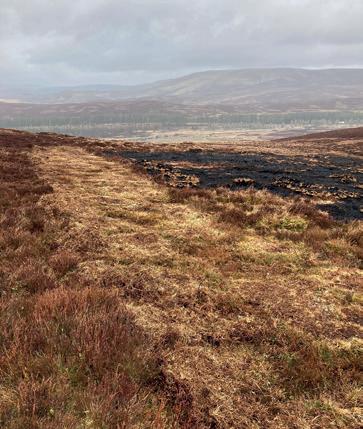
Burning can also be used to prevent wildfires from spreading, but our government favours other methods, such as cutting or swiping. Not every area is accessible with a swipe and what is left behind dries out and is the perfect tinder for fires to start or spread. Sometimes I really struggle to see the joined-up thinking when legislation is created. This bill has many more parts to it, and another worrying consideration is the proposal to award the SSPCA further investigative powers. As it stands, the SSPCA’s jurisdiction concerns welfare aspects where animals are
involved. The extent of the suggested power grant is, as yet, unknown but there are fears that a charitable organisation, with a history of bias against fieldsports, will act as jury in an arena in which they would struggle to remain impartial. Undermining the authority of Police Scotland and potentially risking contamination of evidence through lack of experience and training would certainly not be helpful in the evidence gathering process. As this bill progresses through three stages over the course of 2023, we will continue to present evidence where others present opinion. We will continue to work with policy makers and try to educate where necessary. We will try to ensure that those creating and shaping legislation do so being fully informed and we will do this in conjunction with our rural partner organisations. If you would like to read our responses relating to this bill, or any other, please visit the Scottish Countryside Alliance website where you can also sign up to our Heather Routes newsletter.
Paying the price of Brexit
By Mairi Gougeon Cabinet Secretary for Rural Affairs and Islands

It’s now been six years since the Brexit vote, and Scotland’s producers continue to pay the price for the UK Government’s decision to remove us from the EU, the Single Market and the Customs Union.
Brexit has harmed our trading relationship with the EU, our most important trading partner and one of the world’s biggest agri-food producers. Many exports to the EU have fallen – including a 38% fall in fruit and vegetable exports, and a 7% fall in dairy and egg exports between 2019 and 2022.
It has also created significant workforce recruitment and retention issues for Scotland’s food and drink sector – particularly for our fruit and vegetable producers and dairy farm businesses.
Brexit also saw Scotland being short changed on rural funding. We were promised at least CAP levels of funding before the EU referendum –that never transpired. But I am working hard to seek a different approach for post 2025, with a multi-year funding settlement that respects the devolution settlement and fully replaces EU funds.
These challenges are ongoing – Brexit isn’t over and it isn’t something we can recover from. It also means we need to focus more on food security as a nation and build resilience into Scotland’s food system as a Good Food Nation.
We share a common goal in ensuring we support farming and food production in Scotland to become a global leader in sustainable and
regenerative agriculture. As we act urgently to tackle the climate emergency and protect and restore nature, I am also determined to ensure that high quality food production is maintained.
We will shortly publish responses to our consultation on a new Agriculture Bill. The Bill aims to provide a framework to support, and work with, farmers and crofters to produce more of our food, more sustainably.

And next week, I’m looking forward to joining farmers and crofters once again at the Royal Highland Show, where I will be providing more detail on what businesses can expect from the future support system.
That work has been co-chaired by me and your NFUS President, Martin Kennedy. His involvement –and that of other farmers and crofters – to designing and developing a future support system has been invaluable.
We have already produced an agriculture reform route map, so people know when and how current schemes will change. But I want to stress there will be no cliff edges in support, and unlike in England, we will maintain direct payments and support our nation’s food producers through a just transition.
This might not be the future we expected six years ago, nor one we voted for or wanted. But I want to assure every farmer and crofter in Scotland that their needs and interests are at the heart of the future support system I and your NFUS President are working hard to create.
www.farmingscotlandmagazine.com 95
Burn v Swipe
Overcoming adversity in agriculture
To make the most of our membership coming together at the Royal Highland Show, Women in Agriculture Scotland (WiAS) hosted another breakfast – after the success of last year’s event - on the Thursday (22 June). A sell-out event, the
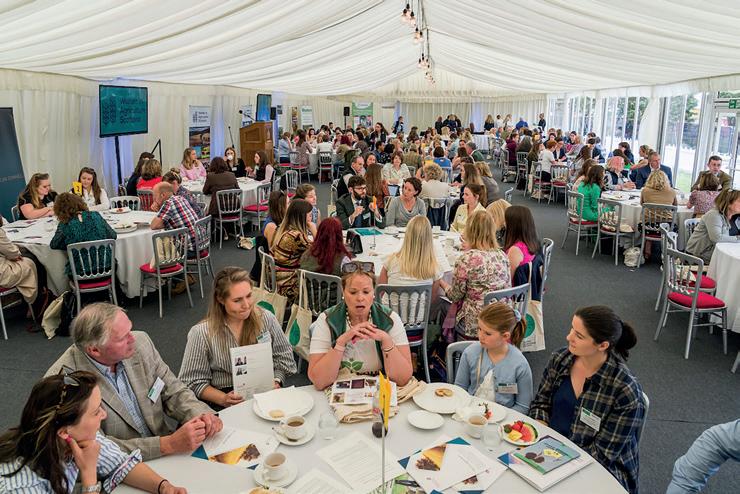

breakfast brought together over 200 guests from across Scotland.
The event was kindly supported by the Scottish Government and aimed to provide attendees the opportunity to hear from two cracking speakers, improve their confidence and
skills, create a network of new contacts to support them with their endeavours, and enable them to continue to positively contribute to Scotland’s rural economy.

This year’s theme was Overcoming Adversity in
Agriculture and welcomed an incredible line-up of speakers.
Mike Duxbury, founder of Inclusive Farm, share his inspiring story and detailed how he is creating a space where anyone can find a career in agriculture.
www.farmingscotlandmagazine.com 96
“My own personal experience as a totally blind person has given me the drive and passion to conceive this project and strive to see it to fruition. I lost my sight completely when I was only 6 years old, however against all odds; I knew that I wanted a life and career in farming. Whilst I was realistic in knowing that I would have some limitations I was determined to find out how I could attain my goal.
“Having been accepted into Warwickshire College of Agriculture, as the first ever blind person, I found my niche with my love of pigs. As most pigs are farmed on an intensive basis in units I found I could navigate and work alone with no restrictions. I then proceeded to gain all the certificates that I could, including my pig craftsmanship and AI (Artificial Insemination) Certificate and my Degree in animal nutrition. Once I left college I secured a job as a feed specialist with a national animal feed company.
“This was where my life and career advanced to include many areas of the pig industry. Thirty years later my love for agriculture is still as strong. Having had jobs in other industries, living my life as a blind person, I can say to this day that the farming industry had never shown me any discrimination at all.
“During this time of my life I met some amazing people, who along the way inspired me. This is the experience that I wish to pass on to other disabled people and people with special needs, to show them that differences need not be a barrier to a goal or dream in farming and agriculture.”
The second speaker, Milly Fyfe, spoke about her personal journey in agriculture.
Milly is an award-winning marketing, PR, events and fundraising specialist, providing digital marketing support to food and farming businesses, helping to reach out and connect with a targeted audience or customer base.
An anchor woman and spokesperson, Milly represents and supports numerous farming organisations and charities including Ladies in Beef, The Farm Safety Foundation and The Farming Community Network.
Milly and her husband Andrew farm beef suckler cattle, sheep, arable crops and a few rare breed pigs with their two young children Angus and Dougie in rural Northamptonshire.
Milly writes and contributes to several publications including the Daventry Express, Rugby Advertiser and BBC Radio Northampton.
A Love British Food ambassador since 2012, Milly is passionate about flying the flag for British Food and Farming and gave a reading at Westminster Abbey during the National Love British Food harvest service.
During the height of the pandemic, Milly established a food blog called No Fuss Meals for Busy Parents, helping to make a connection between food grown in the UK and how to make tasty meals the whole family can enjoy. From there the podcast ‘The Countryside Kitchen meets’ was created, interviewing farmers and food producers about what they grow or raise, where people can buy and how they can transform those ingredients into a tasty meal.
Women in Agriculture Scotland will be hosting more events throughout the year to encourage new members and improve skills, networks and confidence. For more information, visit www.womeninagriculturescotland.com
Southern Belle
Five star treatment
And we’re off! The tour season is underway, with all the fun and trauma it brings to my life on an annual basis. Badminton Horse Trials, The Royal Windsor Horse Show and Newmarket, were the usual line-up to an outstanding two-week jaunt with my Australian horse breeding group. It is always an epic five-star trip, where we are privileged to visit top studs and events always include hospitality. I love my job!
I have one day at home to turn around, then off again. This time with Texas A & M University students, who call me Mam, are singularly polite and clear litter from the bus and breakfast tables in various Travelodges, which are our home for the duration. I can feel you all smirking at my drop in standards in the space of one day.
I’ve always been a big fan of a Travelodge, as they are cheap and cheerful, when all you really need is a shower and a clean bed and most importantly, compared to many five-star hotels I have been in, every staff member in every Travelodge we visited were polite, helpful, and frankly just lovely. I’m a great believer, that regardless of the star quality
of a bedroom, you live your best life outside (unless you are on honeymoon, or in your early 20s).
We visited amazing castles, sites and fantastic farms from the Borders to Inverness and saw Scotland at its best. Relived its amazing history at Culloden, while giving perspective by reminding my young group, that my house is older than their country! We lounged on the grass at Blair Atholl games and tested the water (toes only) in St Andrews. We sang on the bus, made friends for life and I like to think I taught them some important stuff, like how to sing Rattlin’ Bog, the importance of haggis and Ecclefechan tart in your diet and to always take the road less travelled.
We survived with only one near drowning, in a failed canal jumping bet and three smouldering hairdryers (different voltage people!). Everyone left with a smile, including me and the first group I ever led from Texas A & M university, still send me pictures of their Pimm’s they are serving on special occasions that I taught them to make!
Five-star is going the extra mile. My work is done here!

www.farmingscotlandmagazine.com Women in Agriculture Scotland
97
One of the joys of environmental conservation is the rule of unintended consequences, the cascading butterfly effect that environmental work can bring to not just one species but whole ecosystems. And few species link places and people together more than the Atlantic salmon.
May 2019, during the only blisteringly hot weather of the year, and a group of volunteers heads out to the Geldie. They are restocking a new patch of woodland, creating a broadleaf link between the sorry-looking square of pines and the Geldie Burn. Here, within fencing (too many deer to hope that trees could establish without one), are some 30,000 trees, planted in 2017. The soil here is poor, leached and acidic, suffering from centuries of high levels of browsing by deer. It is exposed. The trees were planted without the use of
Pulling in the mussels// Mussel tussles//Pearls of ecological wisdom
Continuing our series of exclusive extracts from his acclaimed book ‘Regeneration’, Andrew Painting looks at the incredibly rare molluscs which live for up to 250 years, clean our rivers, brought the Romans to Britain – and occasionally produce pearls
fertilizer. Mountain hares have taken their toll, killing some of the trees, and so the planting area is to be restocked with a mixture of broadleaf species, aspen, downy birch, alder, rowan and four species of willow.

All of this activity, one way or another, is for the benefit of salmon. We may think of salmon as a game species of the open, treeless moor, but people are becoming increasingly aware that salmon need trees to survive. Trees regulate water levels and temperatures, and stabilise riverbanks, creating gravelly patches. They flood the waters with nutrients, which leads to more insects. They are also a major ally in downstream flood prevention.
Salmon may benefit from the trees we are planting, but the actual, intended beneficiary of this activity, the species which
is actually paying for it all, is another beast altogether. It is a curious creature that people seem to have largely forgotten about, and it is dependent on salmon for its own survival.
The freshwater pearl mussel is one of those bizarre creatures that defy comprehension. To look at, they are like the mussels you get in Belgium when you order moules frites, except they’re a bit larger and not covered in garlic and butter. They can live for over a century. In fact, they have a maximum lifespan of around 250 years. They spend their lives sitting on gravel banks, usually a metre or so below the water, filtering the river, cleaning it, and living off the gunk that they filter out. Also, one in every few thousand has a pearl (yes, a real pearl!) in it.
It is odd indeed to think that Rome’s first emperor decided to come, see and conquer Britain for the sake of pearls. It is, if nothing else, a stark reminder of how much we have lost. Even more remarkably, it was only fairly recently that many people were aware of them. The last full-time pearl fisher, a chap called Bill Abernathy, was working the Esk until the 1970s, floating about in a coracle made of canvas and sticks, looking for them through a special, giant snorkel mask. His most famous find, the marble-sized Abernathy Pearl, is the ‘jewel in the crown’ of Scottish pearls. Its current owners, Cairncross of Perth,
rather coyly describe it as being ‘priceless’.
The reason that you can’t buy Scottish pearls so often these days, and certainly can’t (legally) fish for pearl mussels, is that we killed pretty much all of them. And yet, despite this, Scotland has some of the healthiest freshwater pearl mussel populations in the world. More than half the world’s recruiting population (still reproducing) exists in Scotland. We killed most of them, but we weren’t quite as good at killing them as other places were at killing theirs.

For most Scottish people, the freshwater pearl mussel is an unknown, forgotten relic of history. For the few who do know about it, all too often it is the lure of those pearls. A pearl poacher can kill an entire population in a single search for riches.
Pearl mussels may be largely forgotten, but they perform important ecological functions that benefit us all. They filter water of pollutants. Mussel beds can strengthen riverbanks, stopping erosion. They also provide food for any number of freshwater species. But one particularly potent reason that we are interested in pearl mussels is that they spend the first nine months of their lives latched on to the gills of salmon and trout. Without salmon, they cannot survive. So any conservation project to save them will have to save the salmon first.
People like salmon. Salmon are beautiful. Salmon are a
www.farmingscotlandmagazine.com 98 BOOK SERIALISATION
Pearls in Peril project is just one of many ecological projects being pursued at the 30,000-hectare Mar Lodge Estate
keystone species of Britain. They are delicious. Salmon fishing is highly lucrative. We have a cultural connection with salmon that goes back to the beginnings of civilization, one that, unlike the freshwater pearl mussel, has yet to be forgotten. The salmon is a conduit: protect the salmon and you protect the pearl mussels, and vice versa.
All of this is by way of saying that freshwater pearl mussels were paying for our tree-planting efforts. The Geldie planting scheme is a small part of the hugely ambitious Pearls in Peril project, a multi-million pound, EU-funded project to protect pearl mussels for the benefit of pretty much every species that they share the rivers with, not least salmon.
That’s not where the potency of the salmon brand ends. As we
are slaving away under the hot sun, I become increasingly aware that there are not just planted trees here. Despite the apparent lack of a seed source, there is natural regeneration here too, and it is doing much better than the planted stuff. A few willows and rowans, unlocked from the perpetual cycle of growing above the heather and being browsed back again, are roaring away. I keep finding dwarf birch plants. They must have tripled in height since the fencing went up two years previously. Insects flood onto the spring flowers of eared and creeping willows, each catkin a riot of life. The volunteers dunk their heads in the burn, reapply suncream, and get back to planting. Two thousand trees to go.
And here is the beauty of a simple conservation intervention.
Volunteers plant trees, which stabilise riverbanks, reduce river temperatures, sequester carbon and return nutrients to the river, helping more salmon to survive. More salmon means more homes for pearl mussel nymphs. Pearl mussels, in turn, filter the water, further stabilise banks and provide food for any number of species. Finally, the trees are then helped by returning salmon, who bring back nutrients from the sea and deposit them on land, by way of ospreys and other predators. Planting trees helps salmon, salmon help freshwater pearl mussels, which help other river species, which help salmon, which fertilise trees. Meanwhile, the planting of trees creates new environmental niches for any
number of terrestrial species, from black grouse to mountain hares. And to top it all off, dwarf birch, one of the UK’s rarer plant species, gets its own kick-start. We humans not only get to enjoy living with a more diverse and intact ecosystem but also benefit from flood prevention, less water pollution, carbon sequestration and the economic bonus of more salmon to fish for.
Of course, this is pie-in-thesky, far too neat and ambitious. On its own, the Pearls in Peril project won’t save either the Atlantic Salmon or the freshwater pearl from continuing decline. Far more, wider efforts are needed. But it has done an enormous lot of good for Deeside and beyond all the same.


www.farmingscotlandmagazine.com 99 BOOK SERIALISATION
SPECIAL OFFER Readers
of Farming Scotland can claim an exclusive 10% discount on copies of Regeneration: The Rescue of a Wild Land by Andrew Painting PLUS free P&P in the UK. Order online https://birlinn.co.uk/product/regeneration-3/ quoting FS23 at the checkout.
The view from above: The Linn of Dee, where salmon still run, albeit these days in smaller numbers than before.
The views from below: Salmon making their way up the Linn of Dee – as they have for as long as the Linn has existed. Pearl mussels spend the first nine months of their life attached to salmon gills.
Credit: Philip Lay
A Country Estate in Inverurie
By Janice Hopper
Situated at the foot of Bennachie near Inverurie, Pittodrie House Hotel combines modern Scottish hospitality and luxury without forgetting its rural surroundings and heritage. The grounds are peppered with traditional farming equipment - a plough here, a hay rake there, all polished up, painted and varnished to decorate the surroundings, rather than banished to the past. Parts of the house itself date back to the 15th century, but it’s been added to, embellished and enhanced over the centuries while still retaining period features and charm.

The kitchen team is in touch with a plethora of local suppliers and farmers to source fresh produce. Preferred producers include ScotBeef, John Ross Junior and MacSween. And the hotel also makes its own jam from fruit that grows in the Walled Garden. For real indulgence try Pittodrie House’s six course tasting menu. After an amuse bouche of Scottish trout, savour Gressingham duck with beetroot and orange, a crab and sweetcorn panna cotta, Highland lamb with Stornoway black pudding, finishing off
with a chocolate ganache, and a cheeseboard of Strathdon blue with quince. Another indulgence is a tempting afternoon tea served in the rich red Drawing Room, featuring the hotel’s homemade jam alongside a host of treats.

Guests usually take time to explore some of the 2,400 acre estate that’s home to several tenant farmers. In Spring, guests wander down to the fields to meet the baby lambs, a traditional sight in the Scottish landscape right across the country. But one tenant farm at Pittodrie has something a little different to offer.
The renowned ‘Artisan Grower’ team is delighted to call the Pittodrie Estate their farming home. The couple, Robert and Michelle Sullivan, started the business in Kirkton, Aberdeenshire growing micro greens alongside eye-catching edible flowers. They moved to Pittodrie in order to expand from one acre up to ten, transporting their poly tunnels and micro herbs with them. The farm specialises in veganic farming (aiming for vegan and organic practises) and the Artisan Grower recently
won an award from PETA for their animal friendly farming without animals or the use of animal inputs. Appearances on ‘Countryfile’ and ‘Escape to the Country’ brought them national attention, and a very unexpected invitation put them on the global stage. Approached via Instagram to feature in a music video for a Pharell Williams track featuring Jay-Z, the Sullivans initially thought it could be a hoax. The video for ‘Entrepreneur’ was, in fact, very real, and aimed to showcase black businesses around the world. The Aberdeenshire farmers took their place alongside a host of talent.
The Artisan Grower crops include edible flowers, kale,
kohl rabi, cabbages, lettuce, spring onions, fennel, courgettes, pumpkin, pak choi, radishes, Swiss chard, peppers, aubergines, tomatoes and the list goes on... At one point they sold veganic veg boxes, and in the past they’ve also had a range of juices with catchy names such as Green Light, Beeta-Carrotene, Citrus Burst, Green Monster and Protein Power. Today much of their produce is grown for Compass GroupESS (Energy, Government and Infrastructure), and a lot of the fruit and veg goes off-shore to the oil rigs, as well as to onshore units too. The couple’s long term dream is to open a local restaurant proudly serving their own produce including the juices.
www.farmingscotlandmagazine.com 100
Travel Scotland
Pittodrie House
Afternoon tea
When guests leave Pittodrie House and its estate to explore there’s plenty to keep them occupied in this rich rural terrain. Farming folk will be well aware that the Thainstone Mart is just down the road. The Thainstone Centre is the proud host of the Royal Northern Spring Show, one of the first dates in the farming diary. It’s organised by the Royal Northern Agricultural Society, which was founded in 1843 by farmers and landowners in the north east of Scotland. The Patron is Her Royal Highness Princess Anne who is still a familiar face at the show. Thainstone’s Porterhouse Steakhouse is popular at any time of the year for fans of red meat. The restaurant is a division of ANM Group, a cooperative of farming, food and finance business. Decide between Chateaubriand for two, a centre cut fillet or a tomahawk steak!
Other occasions to plan around include a host of Highland Games and agricultural events in the Aberdeenshire calendar. The Turriff Show falls at the end of July, and the iconic Braemar Gathering is held the first weekend of September. A key rural attraction only fifteen miles drive from Pittodrie House Hotel is the Museum of Farming Life at the National Trust for Scotland’s Pitmedden Garden. The original gardens date back to 1675 so take time to discover a Renaissance style pleasure garden with elegant parterres and
Travel Scotland


yew trees trimmed into shapely pyramids. An orchard grows an array of apples, cherries, blackcurrants, damsons and pears, and a key date for the diary is the Apple Sunday event every autumn, when visitors can buy fruits harvested from the garden. Step inside the Museum of Farming Life’s farmhouse to see a traditional comfortable home, then compare it with the starker accommodation of the farm workers. Display boards explain how farm labourers attended feeing-markets to obtain work, moving from place to place with little more than a kist holding a few personal belongings. Stables, a bothy and outhouses filled with centuries of museum farm equipment complete the picture.
On sunny days drop by one of the stone circles peppering the landscape around Inverurie. East Aquhorthies Stone Circle is noted as a ‘recumbent stone circle’. This monument type is only found in North East Scotland and incorporates a large monolith, known as a ‘recumbent’, lying on its side. The recumbent stone itself is made of red granite quarried near Bennachie. Other sites include the Inverurie Pictish Stones and The Brandsbutt Stone that’s said to date to around AD600.
After all the exploring take time out to try local specialties. Dean’s Shortbread has a visitor centre and relaxed cafe in Huntly, pick up a buttery at a branch of J

G Ross, or head to Oldmeldrum to tour Glen Garioch distillery. And, if you’re still feeling active,

www.farmingscotlandmagazine.com 101
tackle the summits of Bennachie and truly immerse yourself in the land and landscapes of Inverurie.
Museum of Farming Life
Pittodrie House
Artisan radishes
Pitmedden Garden
Slow-cooked beef with peppercorn cream
By Wendy Barrie
This delicious mouth-watering sharing dish was made using Cadzow beef. These rare cattle are available from time to time through Macduff of Wishaw who specialise in bringing heritage breeds to market, supplying chefs worldwide and now also offering a private butchery service. The Cadzow cattle of Lennoxlove Estate are descended from the cattle that roamed wild in the Caledonian forest. Indeed when the Romans arrived on our shores they wrote about the white cattle, giving them a respectful wide berth but probably enjoying a rib or two as well. Both the Cadzow beef and the Skye salt are on Slow Food International’s Ark of Taste. This dish can be enjoyed with any well-hung pedigree beef from your local butcher or farm shop.
Ingredients:
approx 400g double muscle rib, bone in a knob of butter
Isle of Skye sea salt & milled black pepper
250mls double cream
Method:
approx 1 dozen whole red peppercorns
a scrunch of oregano and bayleaf (optional)
6 medium potatoes & 75g butter
160g mushrooms
• Melt butter in a hot frying pan and seal beef on both sides to brown and caramelise. Season. Pre-heat oven 180°C.
• Place seared meat in an ovenware dish (set aside frying pan), pour over juices, add a cup of water, cover with lid or foil and pot roast for a couple of hours. Add herbs at this stage if wished. Check from time to time to ensure it doesn’t dry out.
• Meanwhile peel and slice potatoes finely. Layer in a buttered ovenware dish, interleaved with small dabs of butter and seasoning. Add to the oven for the second hour of cooking.
• Remove beef from oven and allow to rest for 20 minutes. Return all the cooking juices to the frying pan and skim away any excess fat with a spoon. Reduce remaining juices a little if necessary. Taste to adjust seasoning and add cream. Bring to boil.

• Meanwhile sauté mushrooms in a little seasoned butter to add to the serving platter.
Serves 2
Wendy is a cook, food writer & campaigner for local sustainable produce & biodiversity. Founder Director of award-winning Scottish Food Guide & Scottish Cheese Trail, Wendy is also Leader for Slow Food Ark of Taste in Scotland, Cooks Alliance member, IGCAT Global Experts Network member, co-founder of Scottish Bread Championship & pioneer of East Ayrshire Council’s school lunch programme. She has co-written “Meadows: The Swedish Farmer & The Scottish Cook,” with her husband, on regenerative food production.
www.farmingscotlandmagazine.com 102
 Photograph © Wendy Barrie
Photograph © Wendy Barrie
Case IH extends Optum range with new 340hp flagship model providing classleading Feature

Catering for the growing market in multi-purpose, high power tractors, Case IH has launched a new 340hp flagship model for its Optum range, maximising the award-winning Optum concept of a high power, low weight design that can be ballasted as required. Despite multiple improvements, the Optum 340 CVXDrive with AFS Connect™ is no heavier than the existing 300 and 270 models, but provides more power, ultimate productivity and the ability to handle any task.
The new spacious cab provides best-in-class comfort
and is extra quiet at just 66dB(A). Operators will appreciate the excellent allround visibility, premium quality trim, automotive standard of fit and finish, plus a high level of equipment, which includes a key fob for keyless operation.
The cab’s advanced design includes the redesigned ergonomic Multicontroller armrest, which places 95% of the mostused functions at the driver’s fingertips, many of which can be operated either via the touchscreen or new integrated turn-and-press encoder dial. For ultimate operating and ride

machinery www.farmingscotlandmagazine.com 104
comfort, an optional new semi active cab suspension can be chosen.
Clear and easy to use, the new AFS Pro 1200 touch screen monitor with Bluetooth®
functionality gives an overview of all tractor functions. It helps the operator optimise engine, transmission, hydraulic and PTO performance, while also managing the operation of the implements. The new AFS Vision Pro operating system enables precision farming functionality, tractor systems and connectivity to match the required operating preferences.
Optum 340 CVXDrive comes with Safeguard Connect, a comprehensive package of the best Case IH added-value services which provides long-term protection and maximises productivity to meet the requirements of modern, innovative farming and contracting businesses.
The Optum 340 CVXDrive will be seen in public at various shows across Europe over the summer and autumn.
Maschio Gaspardo Launch New Kit
Maschio Gaspardo has bolstered its line-up with a raft of new machines recently unveiled at Cereals last month. The new additions include Primo fertiliser spreaders, Gigante no-till directdrills, Terremoto cultivators and Toro power-harrows, equipped with ISOBUS.
Although new to the UK, these high specification implements have been available throughout the rest of Europe and beyond for a number of years and, as such, are well proven in the field.

Primo twin-disc fertiliser spreaders use some clever technology to make them some of the most precise high output machines on the market. The key feature that sets them apart is the use of twin shutters – one set to

deal with rate control and another to shut off the flow of fertiliser at the headlands.
The key advantage of this is that the on/off shutters can work independently of the rate control sliders making for rapid shut-offs without influencing application rates. This means that as the spreader reaches the headland it shuts off quickly so that there’s
no overlapping with the headland bout.
The version on display at Cereals will be a Primo Isotronic Exclusive model with 32 section GPS-controlled headland shutoff and variable rate compatibility with the ability to alter application rates to left and right discs independently for the highest levels of precision.
machinery
Mzuri launch new linkage single pass drill
Recognising the demand for a linkage mounted drill with more output, Mzuri have developed the new Mzuri Pro-Til iGen.
Staying true to the Mzuri philosophy, the Pro-Til iGen is a one pass drill designed to produce the perfect seeding environment straight into stubble, cover crops and grassland. Accurate seeding depth is maintained across the width of the machine and dual reconsolidation is achieved through a full width packer and individual press wheels.
Aimed at farmers looking for a high output mounted solution, the new range has launched as 4.8m machine which Mzuri felt was the natural initial size to start the range. The 4.8m model features 15 coulters on a row spacing of 320mm.
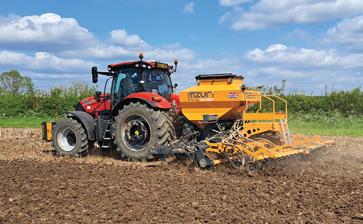
Based on the Mzuri ProTil core concept, the Pro-Til
iGen features a leading tine to prepare a nursery seedbed, dual reconsolidation, and independent coulters as standard. With independent coulters arguably Mzuri’s most respected feature, it is no surprise the Pro-Til iGen boasts fully independent coulters, each with its own depth wheel which reconsolidates, but more importantly provides individual height control of each coulter. A simple mechanism is employed to control height and pressure of the rear seeding wheels, offering exceptional seed placement accuracy across the width of the machine.
Reliable seed delivery is achieved through twin metering units with seed being conveyed via a generous fan system. The iGen’s 2200ltr tank is pressurised to effectively double output over conventional metering, with the
KUHN baler and grassland tour 2023
KUHN Farm Machinery has released details of its 2023 baler and grassland demonstration tour which will feature fixed and variable chamber balers, square balers and combination machines alongside a selection of grassland machinery throughout

the 2023 season.
“Working with our dealer network throughout the UK, will enable farmers and contractors to experience our comprehensive range of balers and other KUHN green harvest machinery in a familiar setting. We believe there
drill operating comfortably at speeds up to 18kph.
The Pro-Til iGen is fitted with a twin harrow bar as standard to achieve a uniform level surface, ideal for getting the best out of pre-emergence herbicides.
Mzuri made the decision to expand their mounted offering
to cater to a growing market of customers looking for a linkage format without compromising on reliable establishment or output. Customers can also benefit from the associated cost savings of a mounted machine, with the ProTil iGen range expected to be up to 30% cheaper per metre than its trailed version.

machinery www.farmingscotlandmagazine.com 106

is nothing better than an on-farm demonstration. This year we have a dedicated web page to help potential customers locate demo machines,” product specialist Rhodri Jenkins explains.
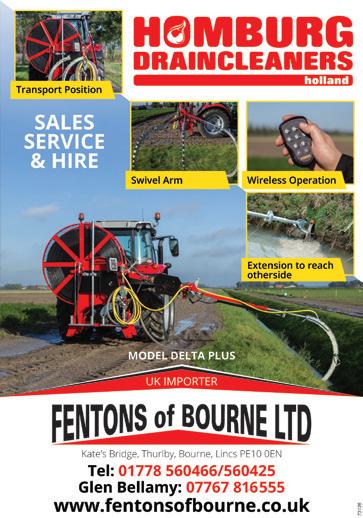
The demonstrations are part of KUHN’S Go Further with Your Forage initiative that seeks to show how machinery can help maximise green harvest yield and quality. KUHN has allocated a total of 20 machines to cover the UK including KUHN’s triple mowers, tedders and rakes along with the Merge Maxx 1090.
“It is an opportunity to see machinery working in real life conditions and a chance to speak to our specialists about the specification and capabilities of our balers and green harvest equipment,” adds Mr Jenkins.
For more information on the KUHN baler and grassland tour visit www.kuhn.co.uk/gofurther-your-forage
Kverneland introduces f-drill to boost seeding combinations
Kverneland has introduced the f-drill front hopper for those looking to carry larger capacities of seed or fertiliser, to run with combination outfits.
Available as the f-drill Compact and f-drill Maxi, the two versions provide hopper capacities of 1,600 litres and 2,200 litres respectively. Both benefit from Kverneland’s innovative ELDOS electric metering unit complete with hydraulic fan drive, which is capable of delivering application rates from 1-400kg/ha.
“The f-drill is great solution for those looking to boost productivity when placing fertiliser with an eight-row maize drill,” says Kverneland’s seeding
specialist Graham Owen. “With its own seed metering unit and 100mm diameter distribution system, the f-drill front hopper is ready to be combined with many different outfits including the Kultistrip, Optima maize drill and Monopill sugar beet drill.”
“When combined with a power harrow drill combination such as the Kverneland e-drill, the f-drill front hopper could also be used as an additional seed hopper to suit companion cropping,” he adds. “Doing so contributes to better balance for the entire combination.”
The generous carrying capacity of the f-drill also
2326
enables it to be combined with Kverneland power harrows and a coulter bar, to deliver a compact drilling rig up to 6m wide.
With ISOBUS e-com software, the f-drill provides plug and play functionality through any ISOBUS compatible tractor, using either the tractor terminal, a Universal Terminal, or the IsoMatch Tellus Pro or Tellus GO+ terminals.
A Duo version of the f-drill is also available, and is equipped with two ELDOS metering units and split-hopper capability.
Prices start from £21,237 for the 1,600-litre capacity f-drill Compact.
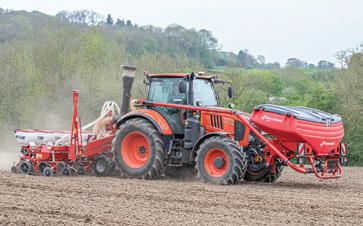
KIOTI HX tractors increase flexibility with option of front loaders and rear hitches
KIOTI has built on its reputation for creating tough, flexible and reliable tractors by offering their flagship HX range with a front loader option.
The company has teamed up with Spanish manufacturer, Tenias, to provide the front loaders, which have been
designed to specifically fit the HX tractor.
The loader is available in KIOTI red and has a maximum lift capacity of 1755kg and lift to a maximum height of 4301mm. Key features include quick connect hydraulics, Euro 8 quick release headstock and rapid tractor uncoupling.
machinery www.farmingscotlandmagazine.com 108
See us at Croptec 2022 23rd & 24th November STAND

Increasing its flexibility still further, the HX tractor is also now available with a hydraulic rear hitch with hook and clevis. Designed by Dutch manufacturer, Pateer, specifically to fit the HX, the hitch includes clevis and hook options and hydraulically telescopes outwards for easy attachment of machines.
The HX tractor is available in the UK in two models - HX 1001 and HX1201 - with 100 and 115 hp respectively. All are available with PTO engine boost, and


feature a 32 x 32 power shuttle gear box, an ergonomic cab with great visibility, and selectable 4-wheel drive.

The HX is a great all round tractor, providing a versatile and powerful option at an affordable price, whilst the 5 years’ & 3000 hours’ warranty provides that extra peace of mind.

Demonstrations are available through the KIOTI UK dealer network, to request your demo contact KIOTI UK on 01480 401512.
HE-VA introduce new version CombiDisc Cultivator
OPICO has introduced a new version of its HE-VA CombiDisc cultivator.
Designed specifically for those running mid-sized tractors, the new model has a 2.45m
machinery www.farmingscotlandmagazine.com 110
working width and four deep soil-loosening legs – rather than the five employed on 2.75m versions. These changes put the horsepower requirement for the smallest Combi-Disc at just 155hp, making this versatile one-pass tillage tool much more accessible to a wider range of growers.
The Combi-Disc employs two leading rows of soil-loosening legs followed by two rows of serrated sabre discs to provide a surface chopping and mixing effect. This is all followed up with V-profile roller to produce a corrugated, weather-proof finish.
It’s this combination of soilengaging elements that makes the Combi-Disc such an adaptable tool. In normal circumstances the tines, discs and press are used in partnership to turn previously uncultivated ground into a seedbed in one pass. When conditions require it, the discs can be lifted completely out of work,
enabling the unit to be used as a straightforward subsoil loosener/ pan-buster.

Likewise, with the legs lifted out of contention, the machine can be put to work as a straightforward shallow disc cultivator.
The recent addition of new ‘Stealth’ soil-loosening legs adds further to the Combi-Disc’s versatility, making it a true low disturbance subsoiler with the added ability of providing some surface tilth creation at the same time.

If it’s lift capacity that is the tractor’s limiting factor rather than power, there is also the option to specify the Combi-Disc with a cage roller rather than the standard V-profile ring-press. This brings the 2.45m wide unit’s weight down from 3000kg to 3300kg, thus making it suitable for a wider range of tractors. While this new model answers the needs of growers with less
FARMING SCOTLAND MAGAZINE
Next issue out September 2023
Subscription page 122
machinery www.farmingscotlandmagazine.com 111
horsepower, it’s narrower 2.5m transport width makes it suitable for
those regions where narrow lanes and tight gateways are an issue.
Top-spec. sprayers for mid-sized farms


For the first time ever Maschio Gaspardo displayed examples of its range of mounted sprayers at the recently held Cereals Show.
While the company has a full line-up of trailed and mounted machines, it is the Tempo Ultra Isotronic that took centre stage.
While there are options for more basic levels of specification, as the flagship mounted mode,l it is fully loaded with every feature you’d expect from a top line machine.
This includes ISObus controls which mean it can be connected directly to the tractor terminal or alternatively to a separate compatible control box. Having this on-board technology as standard means it’s also possible to have GPS-managed section control (down to individual nozzles), variable rate control and an automated boom
recirculation system that avoids delays in spray line purging to maintain even coverage when coming into work.
The control computer also manages all the Tempo Ultra’s hydraulic functions. A single tractor spool-valve supplies oil to the sprayer’s centralised electrohydraulic valve block which handles everything including boom fold, variable geometry tilt control as well as the pendulum frame’s height. Electronic boom height control is an option with up to four ultrasonic sensors providing automatic management of crop-tonozzle clearance and boom tilt.
Boom widths of 15m to 30m are available all with a steel lattice construction and larger versions with aluminium outside sections.
Two sizes of tank are available for the Temp Ultra
NAAC Safety CampaignATV helmets #wearitandshareit
The National Association of Agricultural Contractors (NAAC) is launching a social media campaign on ATV safety to impress the importance of wearing a helmet. Farmers and contractors are being invited to share photos of themselves wearing a helmet with the hashtag #wearitandshareit.
The aim is to make all operators ask why anyone would put themselves, or their workers, at risk (and break the law) by not wearing a helmet on a sit-astride ATV (aka a quad bike).
Shockingly, in the last five years, ATVs were involved in 14 deaths in agriculture - the most significant cause of deaths involving moving vehicles in our industry. That’s fourteen families destroyed. Many, other serious and life-changing incidents are happening all the time. Yet there is still resistance to wearing a helmet.
The NAAC is raising the question why anyone would choose to ride, or deliberately send a worker or family member out on a job with a sit-astride ATV, with no helmet, knowing there is a real and proven risk of loss of life, which could easily be reduced by using a helmet.
Commenting Jill Hewitt, NAAC Chief Executive said, “ATV users should take pride in wearing a helmet to protect their safety and help minimise the risk of the worst possible news being delivered to their family if an incident occurs. None of us are infallible and the NAAC wants the industry to get behind us by sharing photos of themselves wearing a helmet under #wearitandshareit”
Continuing Jill said, “It is a legal requirement to wear a helmet at work and if you leave it behind, you are more likely to suffer a
machinery www.farmingscotlandmagazine.com 112
Isotronic rated at 1600-litres and 2000-litres (1820-litres and 2180-litres actual) with an
additional 300-litre clean water tank and 30-litre induction hopper.
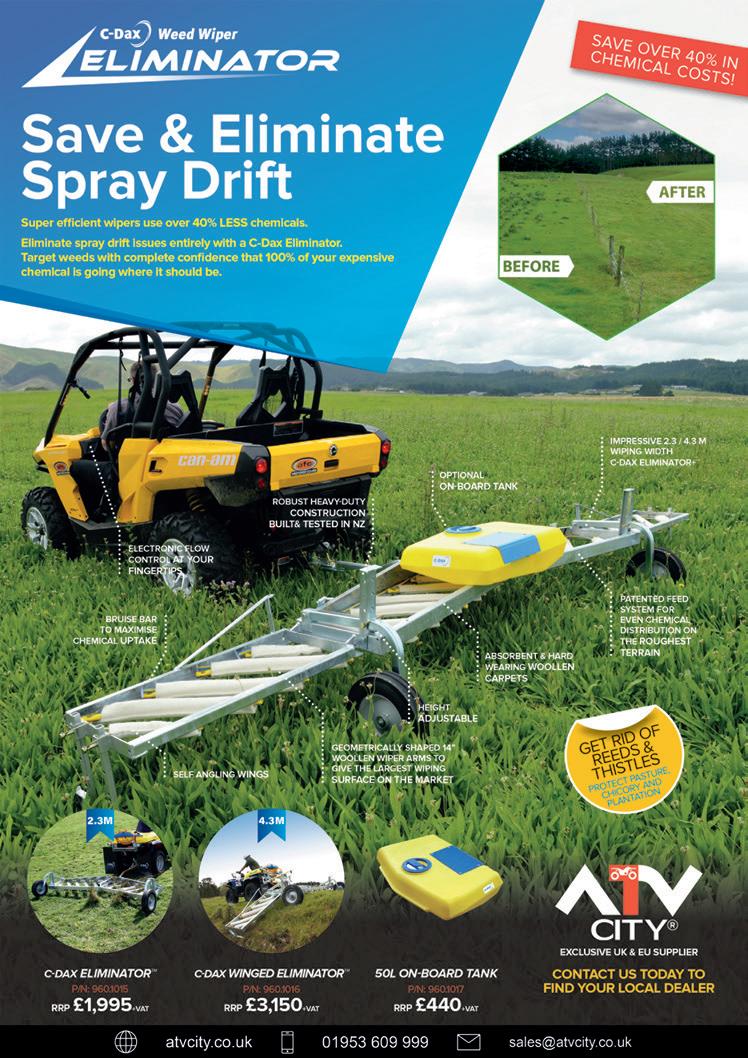
serious head injury, or worse, if you come off. The NAAC is working with Logic helmets to provide a discount to members, removing any final excuses why a helmet would not be worn.”
HSE has confirmed if there is an incident and someone
was not wearing a helmet, this will be a key part of the investigation and could result in enforcement , including prosecution. Enforcement action will also be taken if an inspector sees someone working without a helmet on farm.

McCormick reinforces support for Scottish farmers with new dealer announcement
Complementing its multiple dealer appointments across Scotland and the Borders over the past few years, McCormick has announced that WM Rose of East and West Linton has taken on the McCormick franchise –further strengthening the network which has seen considerable growth in recent times.
The family run business matches the ethos of the brand, providing excellent local service
from businesses who are focused on customer service rather than huge multiple depots giants with large overheads to service.
The McCormick stand spotlighted the multitude of midrange models offered by the brand around the UK’s 170hp average annual tractor sales power figure.
Across many of its Scottish dealers, McCormick is experiencing growing sales in this bracket.
Serving the needs of a broad range of arable, mixed and livestock farms and contractors, they displayed representatives of the 135-155 max hp X6.4 P6-Drive series with six-speed powershift, which includes the X6.414, judged Tractor of the Year 2023 in the ‘Best Utility’ category for features including its front axle suspension, fourwheel braking and P6-Drive transmission with six powershift gears and four robotised ranges.
Also present were the X7 short wheelbase tractors with
six-step powershift P6-Drive and continuously-variable VTDrive. The range includes the four-cylinder 165hp X7.417 and 175hp X7.418, plus the sixcylinder X7.617 and X7.618 with the same maximum power outputs. Potential buyers thereby have a choice of configurations to suit their needs, with a wheelbase of 2,651mm (four-cyl models) and 2,760mm (six-cyl tractors), but all models have a maximum 11,500kg gross vehicle weight and maximum 710/60 R38 rear tyre size.
Ariens’ Arrow Takes Aim at the UK StandOn Mower Market
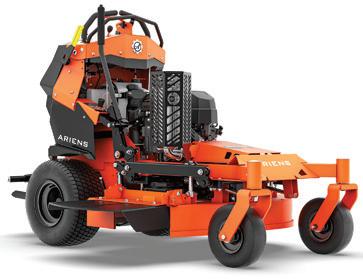
The Ariens Arrow range of standon zero-turn mowers is now available to buy in the UK for the first time. Primarily designed for commercial users, the Arrow provides a perfect blend of power, performance and manoeuvrability, combining the comfort and speed of a zero-turn mower with compact size and agility.
Ergonomics have been prioritised in every aspect of the mower’s design. The standing driver position, with thighs leaning against the machine, is the most natural working stance and of particular benefit to users with back problems. The standing position enables the legs to absorb vibrations
and unevenness efficiently, as well as allowing for easy, quick mounting and dismounting. An ergonomic control panel allows critical adjustments to be made on the move.
The Arrow’s mowing performance is enhanced by its compact design and very low centre of gravity. At a length of only 160cm, with a cutting width of either 81cm or 91cm, the mower can be driven closely and quickly around bushes and trees. With a full view from above of the entire mowing deck and clear visibility of the machine’s width, the driver can approach and drive around obstacles efficiently, navigating intricate
shapes, flowerbeds and hillside terrain safely and easily. Where variable height is needed, the
deck can be adjusted quickly to maintain high-quality cutting performance.
machinery www.farmingscotlandmagazine.com 114

RHET secures funding to inspire young people about food and farming

The Royal Highland Education Trust (RHET) has secured £200k of funding from the Scottish Government to provide a farming and rural learning experience for a minimum of 80,000 pupils across Scotland.

The funding secures the future of rural education events for children and young people, covering core costs such as infrastructure, bus transport, coordination and safety requirements.
Cabinet Secretary for Rural Affairs, Land Reform and Islands, Mairi Gougeon MSP, went to see for herself how funds awarded to the Scottish rural education charity The Royal Highland Education Trust (RHET) spend award
funding to education Scotland’s young people.
Rural Affairs Secretary Mairi Gougeon joined over 100 P5 and P6 pupils from the Brechin schools cluster, who were meeting local farmers, growers and rural businesses running a variety of sessions to learn about how Scottish food is produced. At today’s event pupils were learning about dairy and making butter, see seeds, sheaves and growing crops, grinding wheat seed into flour, pressing oil seed rape into oil, beekeepers demonstrating how they look after their bees as well as hedge demonstrations, getting up close to John Deere machinery - all linking to the learning outcomes of the curriculum.
Cabinet Secretary for Rural Affairs, Land Reform and Islands, Mairi Gougeon MSP, said:
“I am delighted to be here to see first-hand the benefits of the Royal Highland Education Trust’s Food and Farming education programme.
www.farmingscotlandmagazine.com 116 finance
Anglo Scottish Asset Finance Bolsters Service offering with Appointment of New Head of Agriculture & Food

Anglo Scottish Asset Finance have announced the appointment of Andrew Laird as Head of Agriculture & Food for UK & Ireland. Andrew will be responsible for establishing new Agriculture and food division, offering bespoke finance solutions to the sector, and building on Anglo Scottish’s strong business growth.
Reporting directly to Carl Johnson, UK Sales Director (Asset), Andrew will build a new team of specialists to support the growing need for bespoke finance in the Agriculture & Food sector.
Andrew, who has worked in asset finance for over 30 years, has specialised in the funding of
agriculture and food production for the past 15 years. It is his goal to promote diversification in agriculture and food production by supporting businesses, and championing renewable and green energy projects, specialist technology projects including robotics and artificial intelligence, and land loans, commercial mortgages, and livestock funding.
Commenting on his appointment, Andrew said: “Anglo Scottish has rapidly established itself as being one of the largest finance brokers in the UK, and I am excited to be joining at this pivotal time and to establish new lending opportunities with specific focus
on agriculture and food processing. With our approach to finance, we can help businesses to respect the traditions of the past, while embracing the new technologies of the future.”
UK Sales Director (Asset), Carl Johnson commented: “Andrew’s wealth of experience
will help customers, dealers, manufacturers, and suppliers access bespoke lending solutions to support their business. His appointment shows our commitment to customers in the agricultural and food processing sector and our desire to help them advance their businesses.
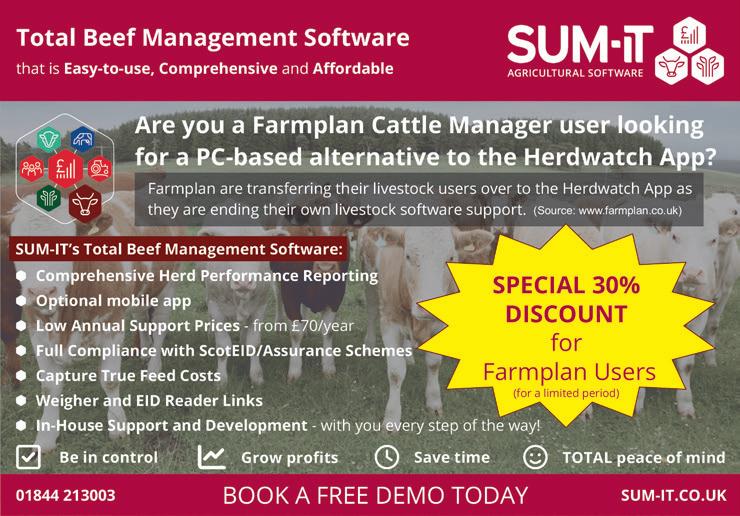
finance www.farmingscotlandmagazine.com 117
Turriff Show all set to showcase north-east farming and food
The gates open again for the 2023 Turriff Show on Sunday 30 to Monday 31 July 2023. The event has become renowned throughout the UK as a vibrant show that celebrates the best of the region’s farming, food and heritage.
The Show is Scotland’s largest two-day agricultural show. In 2022, over 24,000 visitors attended to experience a variety of activities, 300+ exhibitor stands and the livestock and equestrian classes. With expert advice from consultants, agronomists and nutritionists to a range of the latest equipment including tractors, machinery and livestock handling systems, Turriff Show covers all aspects of agriculture.
This year, farming highlights are the Aberdeen Angus Society’s Summer National Show and the
National Ryeland Flock Book Sheep Society Show.
Kevin Gray, who farms at Tillyfar, near Turriff, is the 2023 Show President, he said, “It is an honour to be President for Turriff Show. It is an event I have attended all my years and I have been on the committee, in various roles, since 1995. It is a show that takes folks back to their roots. The atmosphere of community spirit is alive, and a lot of hard work comes from all that are involved in creating the two-day event.”
“As always, a big attraction for the farming community is the always outstanding show of livestock. Last year we had a phenomenal turn out of entries, including the National Highland Cattle Show, all of this was a wonderful outcome after COVID-19. We hope to
have just as many this year with the addition of more Agritrade stands. There is something for everyone, whether you are buying a hammer for fixing fences, or buying a new combine harvester - it’s all here.”
Another highlight is the hugely popular EQ Food and Drink Pavilion, which has capacity for 50 local producers to showcase and serve tasters of the best local food and drink. Many of the exhibitors sell their own home-produced foods and drinks, including meat, dairy, preserves, honey and local drink - beer, gin and whisky.
Mr Gray adds, “The opportunity to showcase local producers really demonstrates the diversity of food and drink produced in the north east of Scotland, and its quality, and it,
for our local visitors, it shows that you don’t have to travel far to try something new.”
Due to the ongoing Avian Influenza restrictions, poultry will not be showing this year. However, we are delighted to hold the Egg and Pigeon classes.
The Show hosts over 1,500 exhibitor classes, including cattle, sheep, horses and ponies, rabbits, cavies, dogs and pigeons, plus industrial and craft classes for skills including baking, vegetable growing and flower arranging; Turriff Show’s total prize money exceeds a staggering £88,000 and 330 trophies are awarded.

“Scotland’s biggest two-day agricultural show is a much-loved calendar date, the length and breadth of Scotland,” says Turriff Show’s President, Kevin Gray.
Coloured Breed Judges Confirmed for UK
Dairy Day 2023
A fantastic line-up of judges has been finalised for the coloured breed classes at UK Dairy Day taking place on Wednesday 13th September in Telford.
The judging of the Dairy Shorthorn, Guernsey and Jersey classes will take place first thing on the morning of the event attracting cattle entries from across the UK.
Dairy Shorthorn Judge: Gwyndaf James
Gwyndaf James has been
chosen by the Dairy Shorthorn Society to judge, travelling from Ceredigion.
Gwyndaf has been involved with agriculture since leaving school to work on the family farm with a herd of Dairy Shorthorns and Holstein Friesians. The family started showing Shorthorns in 1973, winning the Royal Welsh on numerous occasions and Breed Champion at the Royal of England in 1980 and Reserve
in 1987 as well as many county and local shows. This, along with being involved with young farmers stock judging, gave him the grounding and impetus to work as a breeding advisor since 1994.
Being a member of the Shorthorn Society, on their breed council for over 25 years and on their judges panel since 1993, has taken him to many local and county shows. He’s had the privilege to judge the
ABAB Calf Show twice, but the highlights have been to judge the World Conference Show in 2010 at the Highland Show, the first-ever national dairy show in 2011 at the Cheshire County Show and in 2022 being asked to judge the world conference and the national show at the Great Yorkshire.
Guernsey Judge: Colin Christophers
In addition to judging the National Ayrshire Show, Colin
www.farmingscotlandmagazine.com 118
events
Christophers has been selected by the Guernsey Cattle Society to judge the Guernseys classes.
With wife Jenny, son David and help from daughter Debbie and Granddaughter Megan, Colin runs the Rosehill Ayrshire herd. The 300-acre Cornwall Council farm has a herd of 300 with 170 milking cows and followers. Recent investment on the farm has seen a new slurry system installed, collecting and converting methane from the herd to power tractors, vehicles, and generators.
The Rosehill Ayrshire Herd has shown all over the South West and previously up to the Royal Show. Their greatest accolade is winning the Royal Show with Rosehill Black Velour. In addition to showing Colin has had the honour of judging all over the UK, including at Balmoral & Antrim in Northern Ireland, The Highland Show and AgriScot in Scotland, The Welsh Dairy Show, Royal Welsh
and the Royal and Royal Welsh Shows.
Jersey Judge: John Waller
Travelling over from Cumbria is John Waller to judge this year’s Jersey classes.



John farms in partnership with his father Robert, on a pedigree dairy and sheep farm of 400 acres in Killington, down the Lune Valley, between Sedbergh and Kirkby Lonsdale. A family-run farm, they have 100 Holsteins and 60 Jerseys under the Killington prefix, and 400 commercial sheep.
John’s wife, Kate and daughters, Sophie and Natalie have been the main driving force behind the Jersey herd, first founded in 2002. The Waller family have enjoyed successes at their local shows and John has judged Jerseys at shows across England including the Great Yorkshire Show. He is the current Secretary and a previous Chairman of the Lakes Counties Jersey Club.
The cattle infrastructure sponsor is NWF Agriculture supporting free cattle entries for exhibitors. The cattle schedule will be released in June with the stall booking deadline being Friday 4th August 2023.
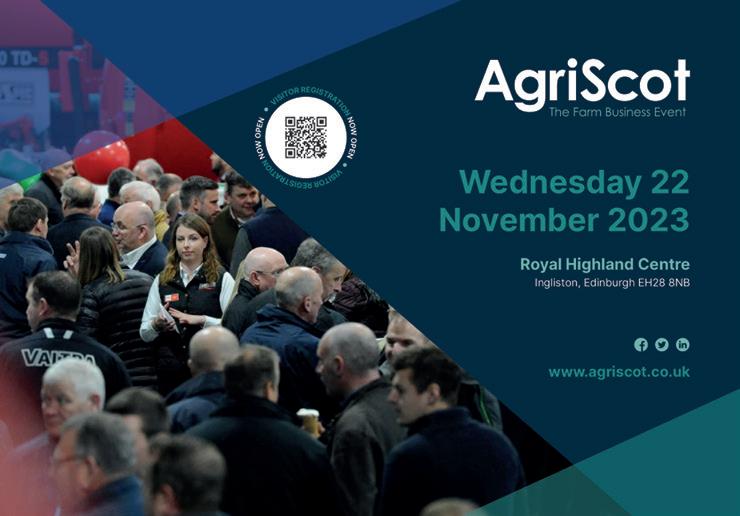
www.farmingscotlandmagazine.com 119 events
Colin Christophers
Gwyndaf James
John Waller
National Farm Management Conference set to debate “What is a Farm For?”
The annual National Farm Management Conference run by The Institute of Agricultural Management (IAgrM) will return this year to the QEII Centre in London on 7 November 2023.

The conference title this year is ‘What is the farm for? Technology v Tradition: The Future of Agricultural & Environmental Management’ and will explore how the twin strategies of regenerative agriculture and the use of modern agri-tech can work together.
“Are we going to have farms that produce lots of food, or farms that respond to the public goods for public services? What is a farm for? Is it there to produce food or public services?” questions Victoria Bywater, national director ofIAgrM.
It is hoped the conference will help answer these key
questions and look at how food production and environmental protection can work to solve two of the most critical issues facing humanity: climate change and biodiversity loss.
The packed one-day event comprises of a stellar line-up of speakers from across the industry and includes:
Opening the conference, Professor Sir Charles Godfray, from Oxford University, will talk about how agriculture is both a problem and solution for climate change
Sam Hall, director of the Conservative Environment Network, will then discuss how farmers can stop and reverse biodiversity loss caused by intensive agriculture
Will Jennings, the CEO of Rabobank in the UK will give a macroeconomic overview of the
situation in farming and supply chain industries
Representatives from the food supply chain have also been invited to discuss how regenerative food production might affect procurement policies, with Joseph Keating, Co-op agriculture manager, leading this session.
Also on the agenda are regenerative farmers, including Paul Carrott, Will Oliver and Paul Cherry, as well as agronomists, such as Ed Brown, head of agroecology at Hutchinsons, will bring a boots-on-the-ground perspective to discuss how they have made the transformation and are making it work at a scale.
And bringing a transatlantic view of technology from the USA, will be managing director of Kincannon and Reed,Aidan Connolly.
Finally, the conference will explore the role technology plays in agriculture and the opportunities and challenges it presents as well as what barriers preventing farmers the adoption of new technology. For example, Sarah Bell, from the British Farm Data Council, will also be discussing ownership of data.
Carl Atkin-House, chairman of IAgrM says: “We have a fantastic line-up of speakers throughout the day. For farmers and ancillary industries involved in agriculture and food, this conference is not to be missed. It will address one of the burning questions on everyone’s lips and look at how agriculture can maintain food production while delivering environmental policies set out by the government.”
For a full list of speakers please visit https://www.iagrm. com/conference/conferencesummary
www.farmingscotlandmagazine.com 120
events
PEOPLE ON THE MOVE
Amy Geddes
Amy Geddes has taken over from Dave Bell on group that encourages responsible use of plant protection products.

Angus-based Amy Geddes is to take over the chair of the NFU’s valuable industry-led initiative in Scotland that promotes the responsible use of plant protection products through Integrated Pest Management (IPM).

Amy is a fourth-generation farmer at Wester Braikie Farms near Arbroath. In partnership with her parents, they farm 320 hectares (ha) of seed potatoes, spring barley, winter oilseed rape, wheat and vining peas. Amy joined the Board at Scottish Agronomy in 2022 and is currently co-vice chair of NFUS Combinable Crops committee. Amy is a supporter and keen volunteer for the Royal Highland Education Trust and enjoys hosting visitors on farm to learn about food and farming and the countryside.
Dee Ward
Dee Ward has been appointed as the new chair of rural business organisation, Scottish Land & Estates. Mr Ward was appointed to his role at SLE’s Annual General Meeting, held at Dunblane Hydro Hotel. He succeeds Mark Tennant who has been SLE chair since April 2020.
Dee is the owner of Rottal Estate, an upland estate in the Angus Glens of approximately 8,000 acres. Rottal is managed in a way to integrate both traditional land use and other business interests.
Farming, grouse shooting, deer stalking are all present alongside hydro-electric and biomass energy generation in a great example of “land sharing” to provide multiple benefits and public goods. Rottal also has a thriving wedding and events business.
Susan Davies
James Hutton Institute appoints new Chair.


Susan Davies, Chief Executive of the Scottish Seabird Centre, has been appointed as Chair of the leading global research hub.
A well-known and respected Scottish environmentalist has been named the new Chair of The James Hutton Institutethe globally recognised Scottish research institute focussed on the sustainable use of land, crops, and natural resources.
Susan Davies has been Chief Executive of the Scottish Seabird Centre since 2019 and is also a former Director of Conservation at the Scottish Wildlife Trust.
Lee Smith
NFU Scotland has welcomed Lee Smith as the new Regional Policy Advisor for Shetland.
Lee works with Margaret Farquhar, the well-known NFU Mutual agent in Shetland and is now, alongside her NFU Mutual role, part of the NFU Scotland regional team, headed up by James Buchanan, National Operations Manager. Members can contact Lee on 07554 741030 or lee.smith@nfus.org.uk

Commenting on the exciting appointment, Lee said: “I come from a crofting background and help my husband and family run a large croft. We predominantly breed commercial ewes, but also breed a small flock of Suffolk ewes and we’ve recently bought our son a small flock of Cheviot ewes to allow him to develop his passion in crofting. In addition, we also have small duck egg business providing local shops with free range duck eggs.
THE BOOK SHELF
Wild History
By James Crawford
Scotland’s rich natural beauty and robust history draw millions of tourists annually, but what about the places which remain unvisited by crowds, unadorned by plaques or signs? Wild History: Journeys into Lost Scotland is all about the discovery and appreciation for these enchanting traces of the past, places which ripple with history but are beginning to be reclaimed by nature itself. During his ten years working in the heritage sector, author and presenter James Crawford became fascinated by how some historical sites become enshrined in memory and contribute to a nation’s sense of identity, while others fade quietly into the land as time goes on. He then set off on a journey to explore and uncover these lesser-known historic sites in Scotland, which culminated in his recently-released book, Wild History.
The book is organised into several clear sections – Worked, Sacred, Contested, and Sheltered, with each of the fifty-five historical sites slotted into one of these categories. Worked includes abandoned industrial locations, while Sacred refers to sites of specific cultural and religious significance. Contested explores locations in Scotland’s military past, and Sheltered examines both natural and human-made structures that have stood the test of time. There is also a helpful colour-coded map at the start of the book, which clearly demonstrates how Crawford traversed the whole of Scotland in his pursuit of these fascinating wild places. From the Scottish Borders to Shetland to the Isle of Mull, Wild History is incredibly thorough, offering new insights into the important moments in history which have shaped Scotland as it is today.
Though this book contains some practical information on how to access these oftenforgotten historical sites, it is not a traditional guidebook one might use to plot out walking trails or figure out path access. Wild History is rather driven by Crawford’s engaging storytelling, creating a captivating blend of travelogue, history, and nature writing. He brings each location to life, both through vivid descriptions of his journeys to them and through his beautiful photographs interspersed throughout the book. Crawford has a particular gift for communicating the importance of place in identity, which is notable in his work as presenter on BBC’s acclaimed series, Scotland from the Sky, and in some of his earlier books, such as The Edge of the Plain: How Borders Make and Break Our World. Wild History will open your mind to the history that is alive all around us, and even perhaps inspire you to set off on your own and explore these rugged places, seeing Scotland in a new light as its varied, intriguing past unfolds all around you.
Wild History by James Crawford, published by Birlinn, May 2023 (£22, paperback) www.birlinn.co.uk

107 www.farmingscotlandmagazine.com 121
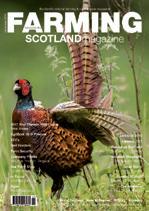













Proud to support Scottish farming, and agriculture throughout the five nations Your ‘collectable’ magazine Keep each issue build your ‘annual set’ and... RELEASE THE LION! Build your own ‘reference’ library of FARMING SCOTLAND MAGAZINE with our new ‘collectable library’ editions To subscribe please call us directly on 01738 639747 or visit: www.farmingscotlandmagazine.com SUBSCRIBE NOW Get your very own copy delivered to your door. Also makes an ideal gift. Only £28.50 a year FARMING SCOTLAND MAGAZINE
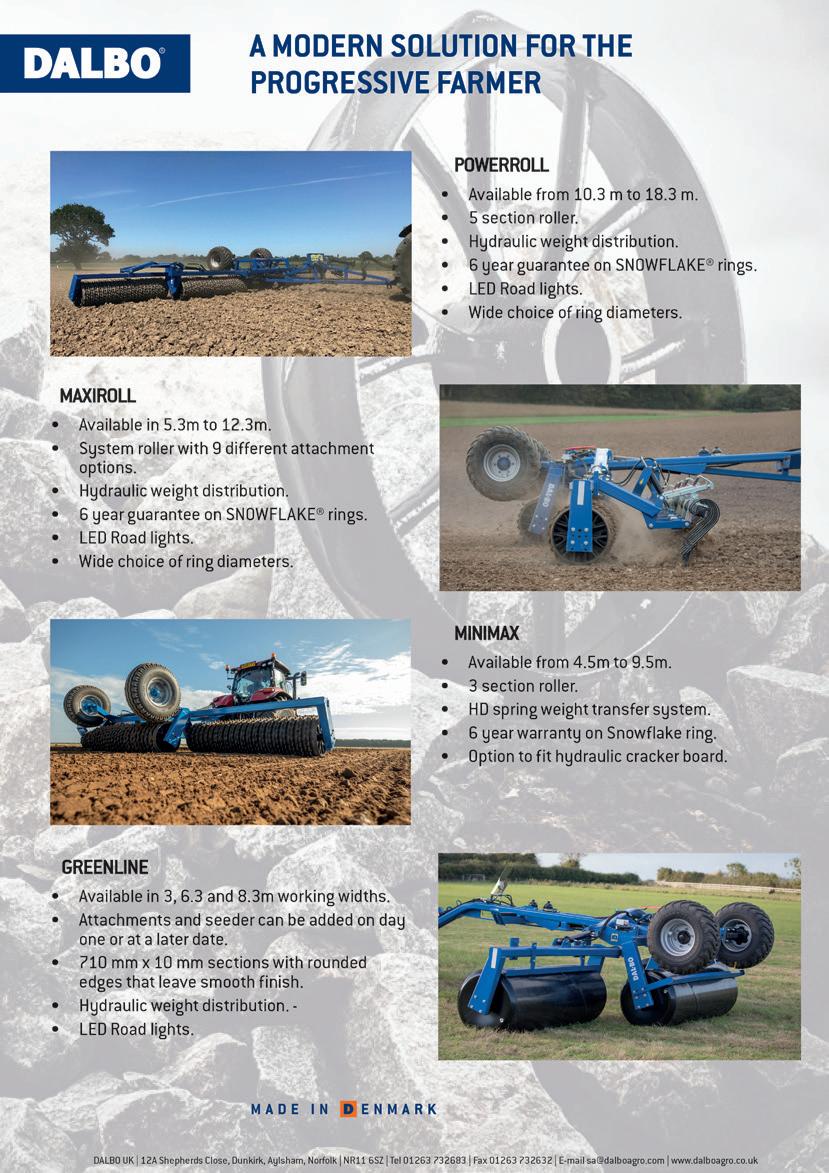





































































































































































































 By Jake Swindells, Director for
By Jake Swindells, Director for




















 Photograph © Wendy Barrie
Photograph © Wendy Barrie

















































